



The Road to Budgetary Blockchain Bliss, is a 2 hour Live Action Role Play adventure for the Blockchain-curious of all tribes including: hackers, lawyers, activists, artists, financiers, designers, venture capitalists, developers, marketeers.
Players adopt a fictional future version of themselves and work with others to solve a real-world problem. They learn about and build DAOs and Dapps (machine-based organisations and apps on the blockchain) and act out the social discomforts, asymmetries, dramas and politics of collaboration and coalition-formation across difference….starting with the budget!
NO PRIOR BLOCKCHAIN KNOWLEDGE NECESSARY
Fill out the application survey to ensure that you are assigned a compatible player character and so increase your chances of achieving your objective – fictionalise at will.
The Road to Budgetary Blockchain Bliss
Devised by Ruth Catlow, Furtherfield and Ben Vickers, unMonastery & Serpentine Galleries
WHEN?: Prompt start – 13:45 – 15:40 on Friday 2 Dec 2016
WHERE? The Presentation Room
As part of MoneyLab #3 Failing Better Symposium | Workshops | Exhibition,
Pakhuis de Zwijger, Amsterdam A two-day symposium,
1 – 2 December 2016, featuring talks, workshops and performances that confront the notion that finance is too big to fail.
Tickets: € 10 per session; € 30 per day, € 60 two day pass Students: 50% discount on all tickets

The global financial dictatorship presents us with a paradox: while the economic transactions capable of shifting the destinies of entire countries are the result of performative language, it is language itself that, in turn, is transformed and subjected by the flows of financial markets. Such a paradox may be understood as a negative feedback loop: a relational process in which one of the actors of the relationship is amplified and expanded (the economy) while the other is weakened and submitted (language). The effects of this paradoxical feedback loop on politics are evident and clear: the linguistic exchange which feeds the public sphere, and therefore the possibility of thinking about the democratic organization of society, diminishes and becomes neutralized because of its submission to the market, up to the point of canceling politics itself. Politics, considered as a space where daily life becomes realized, is reduced to an engine which merely executes the algorithms of finance. In this reconfigured field, the common good becomes increasingly unimaginable as individuals are transformed into cellular automata: inside their bodies, the code of economic behavior and the flat, mutilated language that capitalism requires to operate frictionlessly are already inscribed.
Whoever refuses to enter life as a mere cellular automaton will be annihilated by the financial dictatorship, which is currently passing through an extremely murderous stage: necrocapitalism. Achille Mbembe claimed that the ultimate expression of sovereignty lies broadly in the power and the capacity of deciding who may live and who must die. This was known as necropolitics. Today, the dictatorship of finance prescribes a progressive and quick reduction of the sphere of politics, with the aim of canceling the restrictions that laws and codes used to impose on the flow of capital. And governments have indeed shrunk, turning thus into little more than facilitators of the unstoppable progress of capitalism. However, they have not stopped to exercise their operational capacity to kill and let live. True power has been transferred directly into the hands of capital, who now determines which lives should be halted and which should continue. The power of capital has increasingly turned into a murderous one that, nevertheless, is still executed by the officers of the old sphere of politics.
Mexico passed from necropolitics to necrocapitalism not by force but by the signatures of the presidents and ministers of finance of Mexico, the United States of America and Canada who, in 1992, signed the North America Free Trade Agreement (NAFTA). What has happened in Mexico since then? A chaotic chain of privatizations, looting and crime, all of which have been executed with a hitherto unknown intensity thanks to the almost complete destruction of the former sphere of politics.

After the forced disappearance of the 43 students of Ayotzinapa, Elisa Godínez wrote that “it is not surprising that the corporate sector is heading the demands to repress all social protests which directly affect their properties and interests, arguing that the rule of law should be respected.” [1] It is true that, in the post-NAFTA era, such a position comes as no surprise. However, the true novelty lies in the fact that now the Mexican State no longer defends only the interests of national corporations, but also those of multinationals. And this is not a minor novelty: all sorts of extraction industries, for example, have multiplied their concessions and profits thanks to such a defensive stance. And they have done so while devastating lands, ecosystems and people with almost complete impunity. According to data collected by the Red Mexicana de Afectados por la Minería (Mexican Network of Persons Affected by Mining), 450 tons of gold have been extracted from Mexico, a quantity almost three times larger than the 185 tons extracted during Spain’s colonial domination. This unprecedented looting has particularly benefited Canadian and North American companies, who make up almost 85% of all private mining concessions, while paying back a mere 1% of what they extract to the Mexican government [2].
Article 27 of the Mexican Constitution deals with the property of land, water and natural resources. It originally established that “the property of lands and water resources inside the limits of the national territory corresponds to the Nation.” Obviously, this vision had to change radically under necrocapitalism since, instead of recognizing the primordial nature of private property and the right of capitalists to posses it, it indicated that “the Nation” was, in principle, the sole owner. Now, thanks to recent reforms to Article 27, “the Nation” has acquired the right to transfer the dominion over lands and territorial waters (and, consequently, over the humans and non-humans who inhabit them) into private hands. Article 27 is today the red carpet extended by the Mexican State to welcome the financial and linguistic flows and algorithms of necrocapitalism in grand fashion.
The piece “El 27 | The 27th” is an example of what algorithmic politics can be. Far from trying to point to a possible escape from the horror and exploitation of necrocapitalism, algorithmic politics deepens its murderous potential instead. Despite its relative usefulness as a hired murderer, the traditional sphere of politics is terminally ill: it is too old to carry out rapidly and efficiently the demanding tasks of necropolitics. So, once exhaustion has completely died out its powers, politics made by humans will have to be substituted by algorithmic politics, that is: politics made by machines.
In this piece, an algorithm operates directly on the text of Article 27 in the following way: every night, after the activity at the New York Stock exchange has come to an end, a robot obtains its last closing price and its respective percent variation. If the variation is positive, another robot chooses a fragment of Article 27 randomly, translates it into English automatically, and inserts the translation into its corresponding place within the original text written in Spanish. Given enough time, the algorithm will produce a version of Article 27 fully readable in an effective – yet incorrect – English. An automated English that will already have attempted to displace humans brutally, even though they might still be fighting for a territory delimited by language only, and refusing to die. An automated English that will have already eroded a land delimited by language only, rendering it unrecognizable: torn, exploited, almost dead.
“El 27 | The 27th”: http://motorhueso.net/27
French artists Émilie Brout and Maxime Marion contribute three pieces to The Human Face of Cryptoeconomies exhibition. Gold and Glitter is a painstakingly assembled installation of collaged GIFs. Previous installations have featured the GIFs displayed on a gold iPad atop a pile of collected gold trinkets; at Furtherfield Gallery now a single golden helium balloon hovers in front of a floor to ceiling projection. Nakamoto (The Proof) is video documentation of the artists’ efforts to try and place a face on the elusive Bitcoin creator, Satoshi Nakamoto (but is it his face in the end? We don’t know). Untitled SAS is a registered French company without employees and whose sole purpose is to exist as a work of art.
Brout and Marion’s work can be situated among artists and art practices who have grappled with how to think about value and objects—or more precisely, how objects are inscribed (and sometimes not) into an idea of what is valuable. In a recent article for Mute Magazine, authors Daniel Spaulding and Nicole Demby point out that “Value is a specific social relation that causes the products of labor to appear and to exchange as equivalents; it is not an all-penetrating miasma.”1 Value is a process by which bodies are sorted and edited but it is not a default spectrum on to which all bodies must fall in varying degrees. This clarification makes explicit the fact that while the relationships productive of value allow “products of labor to appear and to [be exchanged]”2 this is not an effect that is extended to all products of labor. Attempts to isolate the underlying logic of this sorting mechanism are often at the heart of art practices dealing with questions of value and commodification. Like Andy Warhol’s Brillo Boxes or Marcel Duchamp’s Fountain, these artworks become interesting problematics for the question of art and value for the ways in which they are able to straddle two economic realms—that of the art object and the commercial object—while resisting total inclusion in either.
The Human Face of Cryptoeconomies picks up these themes in an art context and repositions them alongside digital cultures and emerging digital economies. In Brout and Marion’s work alone, concepts of kitsch, identity, and human capital have been inhabited and imported from their originary realms into the digital. Answering questions remotely, Brout and Marion were kind enough to give us some insights into their work and process. My goal here has been to draw out some points about the operation of value that are at work in Brout and Marion’s practice, as well as to point towards an idea of how value is transformed, or even mutated, in the digital age.
* * *
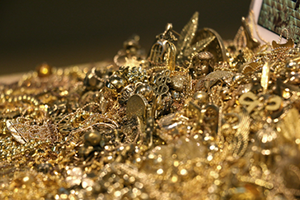
Brout and Marion open up with an interesting provocation. They explain, “When we showed the project [Glitter and Gold] in Paris this year, people stole a lot of objects, even if they were very cheap. Gold has an incredible power of attraction.”
It is telling, to some extent, that Brout and Marion’s meditations on gold have an almost direct link to the visual metaphor used by Clement Greenberg in his 1939 essay Avante-Garde and Kitsch to describe the relation between culture—epitomized in the avant-garde—and the ruling class. Greenberg writes, “No culture can develop without a social basis, without a source of stable income. And in the case of the avant-garde, this was provided by an elite among the ruling class of that society from which it assumed itself to be cut off, but to which it has always remained attached by an umbilical cord of gold.”3 This relation is subverted in Gold and Glitter, which takes for its currency—its umbilical cord of gold—a kind of unquantifiable labor that is seemingly (and perhaps somewhat sinisterly) always embedded in discussions of the digital.
For Greenberg, kitsch always existed in relation to the avant-garde; one fed and supported the other, even if the way in which that relation of sustenance worked was by negation. And while Greenberg’s theory relies on his own strict allegiances to hierarchical society, privileged classes, the values of private property, and all the other divisive tenets of capitalism that we now know all too well can be destructive. Kitsch remains useful to us for the ways in which it allows the means of production to enter into a consideration of aesthetics. Here the recent writing of Boris Groys can be useful. In an essay written for e-flux titled Art and Money, Groys makes a compelling case for why we should persist in a sympathetic reading of Greenberg. He argues that Greenberg’s incisions amongst the haves and have nots of culture can be cut across different lines; that because Greenberg identifies avant-garde art as art that is invested in demonstrating the way in which is it is made and it doesn’t allow for its evaluation by taste. Avant-garde art shows its guts to us all, and on equal terms—“its productive side, its poetics, the devices and practices that bring it into being” and inasmuch “should be analyzed according the same criteria as objects like cars, trains, or planes.”4
For Groys this distinction situates the avant-garde within a constructivist and productivist context, opening up artworks themselves to be appreciated for their production, or rather, “in terms that refer more to the activities of scientists and workers than to the lifestyle of the leisure class.”5 In this way Glitter and Gold, like Brout and Marion’s other artworks, is to be appreciated not for any transcendent reason but rather for the means by which it came into existence. ‘The processes of searching and collaging golden GIFs sit side by side with the physical work of accumulating the golden trinkets for display: “We collected these objects for a long time” the artists explain, “some were personal objects (child dolphin pendant, in true gold), others were given or found in flea markets, bought in bazaars … We wanted to have a lot of different types and symbols, from a Hand of Fatima to golden chain, skulls, butterflies, etc.”
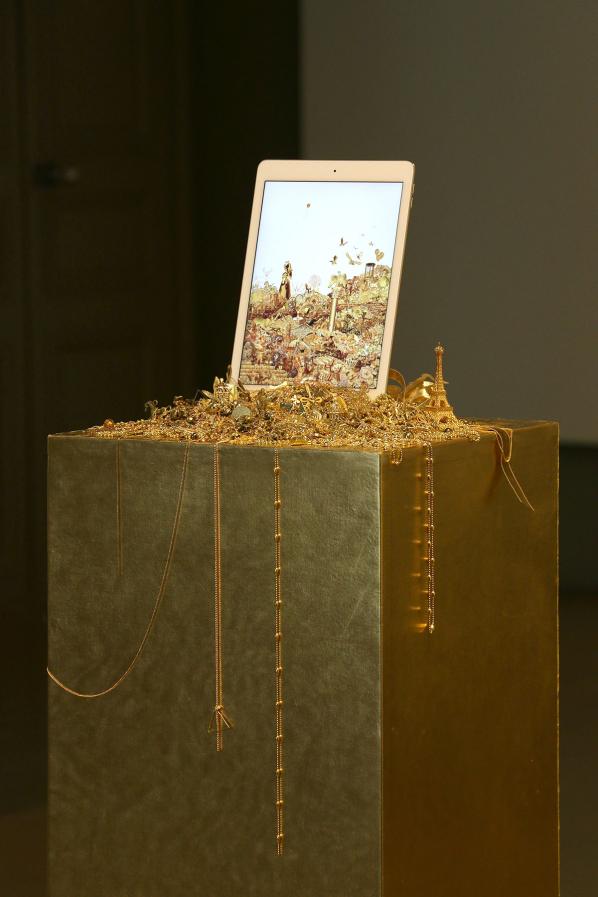
Furthermore, Glitter and Gold can be understood as the product of compounding labors: the labor of Brout and Marion in collecting their artifacts, the labor necessary to create the artifacts, the labor of GIF artists, the labor of searching for said GIFs, the labor of weaving a digital collage. These on-going processes forge, trace, and re-trace paths during which, at some point, gold takes on the function as aesthetic shorthand for value. As Brout and Marion explain, “Here the question is more about the intrinsic values we all find in Gold, even when it just looks like gold. Gold turns any prosaic product into something desirable. [Gold and Glitter] is less about economics than about perceived value.”
Groys provides his reading of Greenberg as a means of pointing towards a materiality that is always in excess of existing coordinates of value. If value always reveals the products of labor as they enter into a zone of exchange, it is something else proper to contemporary art that reveals another materiality beyond this exchange. For Groys, this something else is at work in the dynamics of art exhibition, which can render visible otherwise invisible forces and their material substrates. This is certainly a potential that is explored by Brout and Marion. In Nakamoto (The Proof), the viewer can watch the artists’ attempt at creating a passport for the infamous and elusive Bitcoin creator Satoshi Nakamoto. At present, it is unclear whether Nakamoto is a single person or group of people, though the Nakamoto legacy as creator of Bitcoin, a virtual currency widely used on darknets, is larger than life. Adding to this myth, after publishing the paper to kickstart bitcoin via the Cryptography Mailing List in 2008, and launching the Bitcoin software client in 2009, Nakamoto has only sporadically been seen participating in the project with others via mailing lists before making a final, formal disappearance in 2011, explaining that he/she/they had “moved on to other things.”6 Nakamoto’s disappearance, coupled with the fact that Nakamoto’s estimated net worth must be somewhere in the hundred millions Euros, has given rise to the modern-day myth of Nakamoto, and with it an insatiable curiosity to uncover the identity and whereabouts of the elusive Bitcoin creator.
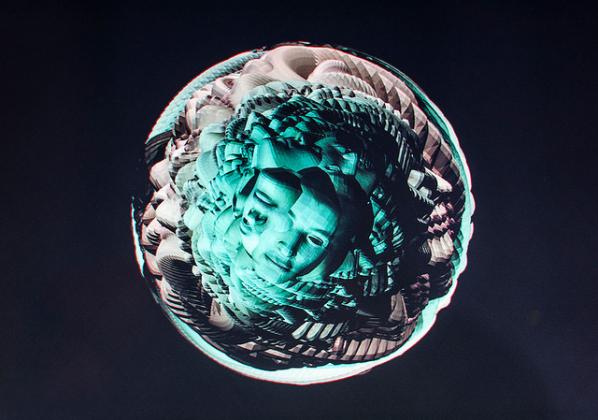
Brout and Marion make their own attempt to summons the mysterious Nakamoto back to life by putting together the evidence of Nakamoto’s existence and procuring a Japanese passport using none other than the technologies that Nakamoto’s Bitcoin both imparted and facilitated. When asked if they feared for their own self-preservation in seeing this project through, Brout and Marion answered, “Yes, even if we were pretty sure that it would be easy to prove our intention to the authorities, and that the fake passport couldn’t be useful to anybody, buying a fake passport is still illegal.” They add, “But we also wanted to play the game entirely, so we made every possible effort to preserve our anonymity during our journey on the darknets.”
However Brout and Marion have yet to receive the passport; as they explain, “The last time we received information, the document was in transit at the Romanian border.” When asked if they expect to receive the passport, they respond, “No, today we think we will never receive it. We are completely sure that it has existed, but we’ll surely never know what happened to it.” What, then, will they do if they never receive the passport? “Maybe just continue to exhibit the only proof of it we have!” they exclaim. “There is something beautiful in it: we tried to create a physical proof of the existence of a contemporary myth, using digital technology and digital money, and the only thing we have is a scan!”
If Brout and Marion’s nonchalance seems unexpected then it is because the disappearance of the passport for the artists marks just another ebb in the overall flow of their piece; a flow that began with Nakamoto, coursed through their clandestine chats via a Tor networked browser and high security email, and now continues to trickle on while we wait in anticipation for the next chapter of the Nakamoto passport to reveal itself. In this respect, the anticipation of the passport is a poetic and unforeseen layer added to the significance of the piece: “Maybe it is even better [that the passport should not arrive]” Brout and Marion comment. “It’s like it was impossible to bring Nakamoto out of the digital world.”
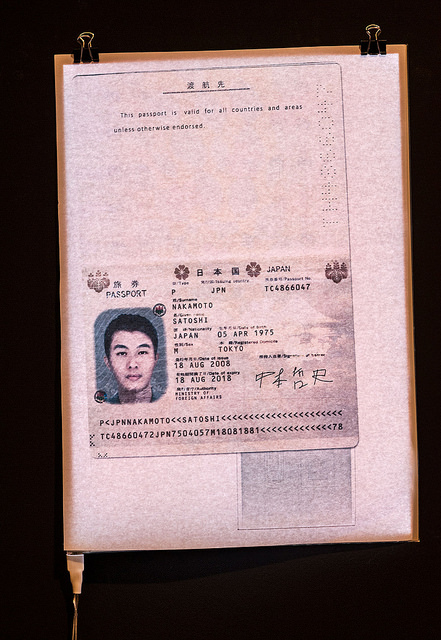
If value is always formed by way of a social relation, then how do digital modes of sociality also deliver this effect? This becomes a particularly fraught question when considering that, as Anna Munster has written, the sociality that takes place on the internet can be understood as the interrelation of any number of subjectivities, both organic and inorganic. Brout and Marion’s ambivalence to the purloined passport highlights just such an expectation: “Here the lack of identity delivers a lot of value. Look at Snowden: journalists ask him more about his girlfriend than about his revelations. Making something as big as Bitcoin and staying perfectly anonymous? These are strong attacks to two of the most important issues of our societies: banks and privacy.” What their statement suggests is how a collective movement towards transgression, here seen as compounding maneuvers of avoidance of physical world boundaries and institutions, might hold within it the promise of its own set of value coordinates. As Brout and Marion further explain: “For us, Nakamoto is absolutely fascinating. The efforts he made to prevent himself from being turned into a product are incredible. Especially when you know the importance of [Bitcoin’s] creation, and that only a few men in the world are smart enough to create something like this. Adding to that the fact that Nakamoto is probably a millionaire, you have one of the only true contemporary myths, something hard to find credible even if it was just a fictional character in a movie. So this somewhat absurd attempt to create a proof of Nakamoto’s existence was, for us, an attempt to make a portrait of him, to put light on his figure. And, in some ways, a tribute.”
Brout and Marion mount a final probe into questions of value in their piece, Untitled SAS. Untitled SAS is the name for Brout and Marion’s corporation whose purpose and medium is to exist as a work of art. In France SAS means société par actions simplifée, and is the Anglophone equivalent of an LTD. SAS companies have shares that can be freely traded between shareholders. Untitled SAS, in Brout and Marion’s own words, “has no other purpose than to be a work of art: it won’t buy or sell anything, there won’t be employees, its existence is an end it itself. The share capital of the company is 1 Euro (the minimum), and we edited 10,000 shares owned by us (5,000 for each one). Everybody can freely buy and sell shares of this company.” Brout and Marion are clear: in no uncertain terms, “Untitled SAS is a work of art where the medium is a real company, and the corporate purpose of this company is simply to be a work of art.”

Untitled SAS is a tongue in cheek commentary on the situating of artworks as outside of the rational space of the market while still being subject to selective norms of economic behavior. Brout and Marion explain, “Untitled SASis obviously a metaphor for the art market, and the market in general: it is a true, fully legal, and functional speculation bubble. Companies usually try to create some concrete value, they are means. The art world has fewer rules than the regular market, the price of some artworks can radically change in few days without any logical reason: their intrinsic value is completely uncorrelated to their market value. We wanted to reproduce and play with these systems in the scale of an artwork.” At this level, what Brout and Marion uncover is further proof of the condition of the contemporary art period as Groys sees it: a time in which “mass artistic production [follows] an era of mass art consumption” and by extension “means that today’s artist lives and works primarily among art producers—not among art consumers.”7
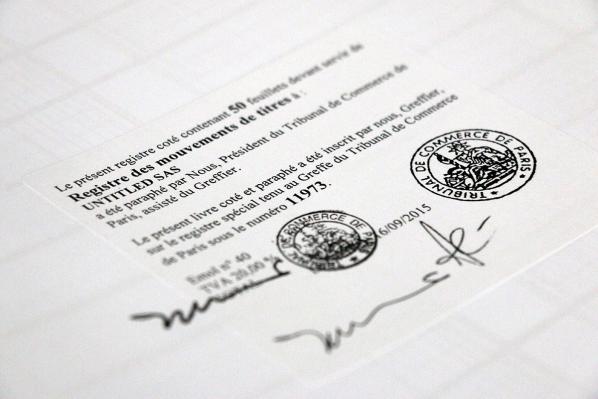
Crucially, the effect of this condition is that contemporary professional artists “investigate and manifest mass art production, not elitist or mass art consumption.” This is the mode of art making precisely employed by Brout and Marion in the creation of Untitled SAS. It has the added effect, too, of creating an artwork that can exist outside the problem of taste and aesthetic attitude. Companies tend to eschew taste qualifications in favor of brand associations. Untitled SAS becomes readable as an artwork, as Untitled SAS, when the expectations and regulations of a nationally recognized business are made to butt up against the inconsistencies of the artworld as an economic sphere. The art object then becomes rather a means of accessing the overlapping paths of art and value as they are uniquely enabled to circulate in and out of the art & Capitalist markets.
* * *
Brout and Marion note that, “In our work we often use algorithms and generative ways to produce things, but here we wanted to something no machine can do, something hand-made, too, finally a simple and traditional work of art.” These kinds of generative technological processes and sorting algorithms have been central to many debates on how contemporary culture is absorbing the boon of big data: from ethical questions on predictive policing to dating apps and ride-hailing startups. As one Slate article posed the question in relation to Uber, these algorithms are more than just quick and efficient modes of labor—they are reflections of the marketplace themselves.
So what, then, might it mean that both values and services in the digital age are predicated on the power to sort and categorize, and that this power is ciphered through its own dynamic of social relations, but that in one scenario what emerges is a sphere of the valuable and in the other a software that asserts itself as benign and at the behest of an impartial, impersonal data? Perhaps the rationality of value and market circulation vis a vis the art object was always going to be a little too tricky to take on: too many exceptions, too many questions of subjectivity, taste, and judgment. But as the works exhibited for The Human Face of Cryptoeconomies might suggest the rationality of value and the products it chooses to incorporate is of high importance. If value works precisely because of the specific interrelating of social subjects then we can consider the realm of the digital as a concentrated form of such a relation.
Against this we must consider the new subject that is produced and addressed by the intersecting of these discussions. Spaulding and Demby make the case that, that “Art under capitalism is a good model of the freedom that posits the subject as an abstract bundle of legal rights assuring formal equality while ignoring a material reality determined by other forms of systematic inequality.”8 Karen Gregory, in The Datalogical Turn, writes, “In the case of personal data, it is not the details of that data or a single digital trail that are important, it is rather the relationship of the emergent attitudes of digital trails en mass that allow for both the broadly sweeping and the particularised modes of affective measure and control. Big data doesn’t care about ‘you’ so much as the bits of seemingly random information that bodies generate or that they leave as a data trail”.
The works of Brout and Marion exhibited at the Human Face of Crypotoeconomies exhibition places the intimacy of the body front and center. They speak to the shadow and trace of the body by appropriating the paths of the faceless, or by giving a face to the man (or entity) without a body, to becoming the human face of the market player par excellence by inserting themselves into a solipsistic art corporation. Brout and Marion’s practice understands that while value may not be an all-penetrating miasma, this is not also to say that the effect of value is not still inscribed on the flesh of each and all, organic or not.
1 Demby, “Art, Value, and the Freedom Fetish | Mute.”
2 Ibid.
3 Greenberg, “Avant-Garde and Kitsch,” 543.
4 Ibid.
5 Ibid.
6 “Who Is Satoshi Nakamoto?”
7 Groys, “Art and Money.”
8 Ibid.
Plantoid (2015) by Okhaos is a self-creating, self-propagating artwork system that uses blockchain technology to gather and manage the resources it needs to become real and to participate in the artworld. Structured as a Decentralised Autonomous Organization (DAO), once it is set in motion the code of the Plantoid system combines the functions of artwork, artist and art dealer in a single piece of software.
As its name implies, the physical Plantoid artworks are cyborg-looking welded sculptures of flowering plants. Flowers are a popular icon of naturalised aesthetics in art and culture. Their aesthetic and art historical appeal makes them an effective subject for subversion. Radicalized flowers wander through recent art like triffids through the English countryside. Helen Chadwick’s “Piss Flowers” (1991-2) are a proto-xenofeminist riposte to idealisation of nature and the body. Mary Anne Francis’s “The Blooming Commons” (2005) combines the ideas of organic and creative fecundity to help artist and audience consider how making art open source affects its aura. Plantoid can easily be cast in this tradition.
The physical form of Plantoid is determined by its blockchain presence, which represents an advance on the state of the art. The Bitcoin blockchain is a database that represents control of resources. Most simply these resources are amounts of Bitcoin but we can encode information representing other resources – and the right to control them – into the blockchain as well. Current general purpose Bitcoin blockchain-based systems such as Counterparty can easily represent tokens for games, for reward and voucher schemes, or for stocks and shares. Placing these on the blockchain does not magically improve them over existing means of issuing them but it does reduce their barrier to entry and make securing and maintaining them easier. It also defamiliarises them by placing them in a new context and makes them accessible and thereby inspirational to new audiences. Melanie Swan turns this idea up to 11 in her excellent survey of the state of the art and its future potential “Blockchain“, describing the application of the idea of blockchains ultimately to the global economy and even the human mind.

Beyond tokens, the blockchain can be a cheap and effective database of existing property and rights, including recording Free Culture licensing. It is simple to create such a system, I made the first one for artworks based on Ethereum myself. It cannot be an effective means of policing DRM (as DRM is inherently broken) and must not be treated as a means of rolling back the limits of and exceptions to the existing property and copyright regimes or of creating new entitlements ex nihilo. This would turn a technology with great (if contentious) potential for liberation into a tool of exploitation. Making a GIF of Apple’s new emoticons and selling the blockchain title to it for $250 reflects existing social pathologies rather than new technological or artistic affordances.
The technobiophilic machine-nature-form hybrid nature of Plantoid is described by Okhaos in terms that cast cryptocurrency as metabolic and reproductive resources. To quote the project page:
Perhaps the initial Plantoid will need $1000 to fully turn into a blossom. Whenever that particular threshold for the Plantoid is reached, the reproduction process starts: the Plantoid only needs to identify a new person or group of persons (ideally, a group of artists) to create a new version of itself. Given the right conditions, the Plantoid is able to manufacture herself, by executing a smart contract that lives on the blockchain, and has the ability to commission welders, companies, and other beings to build and assemble a similar being.
It’s here that we see how Plantoid represents an advance on existing systems. The parameters of each physical Plantoid are encoded on the Ethereum (rather than the Bitcoin) blockchain as smart contracts, representing the economic and manufacturing logic and the aesthetics of its production as a kind of genome. Plantoid is an active artistic production agent rather than a passive registry of existing art.
The defamiliarising effect of the blockchain allows us to unbundle the collections of rights and responsibilities that make up roles within the mainstream artworld. Paying for the creation of art, its storage and restoration, transport and exhibition. Inspiring, designing, manufacturing, promoting, experiencing, critiquing and art. The artist, the gallerist, the critic, the installer, the attendant. A new territory like the blockchain allows us to shake things up rather than to try to double down on existing relations and distribution of wealth in order to extract new rents.

Plantoid opens up the roles of artistic production in precisely this way. It uses the structure of a DAO to incentivise the funding, governance, production, exhibition and reception of Plantoids in a virtuous circle (a positive feedback loop of production). None of this confers ownership or property rights over the physical Plantoid artworks on individual human beings. Their relationships are closer to those of patronage, crowdfunding, or tipping but unbundled further. There are technological precedents for this such as the way Aaron Koblin’s “The Sheep Market” (2008) commissions drawings from clickworkers, Caleb Larsen’s “A Tool To Deceive And Slaughter” (2009) manages its own sale, the way Bitnik’s “Random Darknet Shopper” (2014) orders goods for delivery to the gallery, or Imogen Heap’s release of the single “Tiny Human” (2015) using Ethereum smart contracts
From the project page again:
Plantoids are part of an ecosystem of relationships that is powered by two driving forces: aesthetic beauty and automated governance. Plantoids subtly motivate these interactions, partly through their form and physical beauty, but also by empowering people to participate in their governance. Participants (that is, active members of the DAO) are able to decide on such things as where the Plantoids may be exhibited, whom they might visit, and exactly how they are to be reproduced.
When it receives funds by the audience, the Plantoid evolves and turns into a more beautiful flower, by e.g. moving around a means to gratify the donor and progressively opening up its petals as more and more funds are stored into its wallet. Once enough funds are secured, the Plantoid can use this money to reproduce itself, by commissioning a third party to produce a new Plantoid.
The smart contracts that instantiate these relationships contractually direct human actors to govern the DAO, to manufacture new Plantoids, and to exhibit (and return) the work. The danger of such DAOs is that of any embedded socioeconomic intent – whether corporations, charitable trusts or high frequency trading bots. We may end up with an economic Skynet that reduces us to peons in an algorithmic gig economy, any reflection of our actual needs or desires (such as to make art) perverted by the incentives encoded into an inhuman system. Plantoid exists to ensure the production of art, and its realisation by human artisans. Given the rockstar economics of the artworld and the continued collapse of socioeconomic support for artists outside it that production is badly in need of new means of continuance. The art-economic equivalent of “grey goo” – polychrome goo? – or Terminators armed with spraycans rather than phased plasma rifles seem much less likely scenarios than art DAOs becoming lifeboats or TAZes for the funding of art that is not simply decoration for the 1%. Plantoid’s explicit involvement of human producers in a comradely relationship makes it more a node in the network of collaborative and mutually supportive relationships in the peer economy than an Uberization of artistic production.
Any gap between the ambition and the technology of Plantoid can be crossed by its autopoeitic nature. Ethereum contracts cannot yet manage Bitcoin balances, for example, but using Ethereum’s existing native cryptocurrency “Ether” or one of the proposed systems for managing Bitcoin accounts from Ethereum would address this. Art’s function here, as in its development of religion at the dawn of history, is to create demand for the development of new means of production and relation that a dryly complete rational plan could not reach. Appropriately enough for such a hyperstitional work I discovered it via the blog of renegade philosopher Nick Land.
Without wishing to ventriloquise or reframe its achievements, Plantoid is an exemplary realisation of the potential of mutual interrogation and support of art and cryptocurrency. It’s an art project that uses cryptocurrency and smart contract systems to materially support itself. And that project makes the still abstract potential and operation of cryptocurrency and smart contract tractable to consideration through art. I for one welcome our new hyperstitional DAO artwork overlords.
This work is licensed under a Creative Commons Attribution-ShareAlike 4.0 International License.
Copyright has been a relevant topic since the development of the printing press. It grants the author the exclusive right to reproduce, publish, and sell the content and form of intellectual property. The copy & paste mentality of the Internet user brought chaos to the system. Blockchain technology should now manage the author and marketing rights in a way that is more transparent, completely free of Bitcoin and monetary background. The idea had its origin in the art scene.
The Internet is a space without horizons or frontiers. It has changed our environment and also, thereby, our sensory perception. In ‘the real world’ we are confronted everywhere by people gazing deeply into smartphones: on the street, on the subway, in airplanes, in queues and cafés. Interpersonal dialogue is increasingly being conducted in the virtual sphere. How does the art scene react to new technological developments in arts? I asked Alain Servais (collector), Wolf Lieser (gallerist) and Aram Bartholl (artist.)
AD: Alain, you are collector of digital art since many years. How actively do you use the Internet and the possibilities that it brings for research into art?
AS: I have the opportunity to generally be able to experience art in the real. This is still an indispensable element in the process of acquiring. I’m a big user of the Internet when it’s a question of looking for information on art that’s of interest to me. The key information I always try to gather before acquiring a work is: – a document collating the works which have marked the evolution of the artist’s practice –a piece of writing by an academic, curator or critic contextualizing the artist’s work – an interview with the artist, as I want to hear his/her ‘ voice’ speaking about on his/her art – and a biography.
AD: Wolf, how much do you use the Internet and its possibilities for better marketing in the art scene?WL: We have a presence on various social media and websites, for example, FB, FLICKR, Bpigs, ArtfactsNet, etc. But we try to limit it to those pages that are relevant to art. As an actual communication medium we primarily use Facebook.
AD: Aram, killyourphone.com provides relief and a critique of technology. What would your subjects be without the Internet?
AB: Despite rising levels of communication across devices and networks, I nonetheless notice how, when friends express their opinions on the social media channels, they do so ever more consciously and selectively. We’ve come to understand that all of the commentary and spontaneous utterances on Twitter, FB & co no longer just disappear, but are saved, analyzed and used. ‘Private is the new public’, said Geraldine Juarez recently. The belief that the net makes the world fantastically democratic and offers an equal chance for everyone has, at least since Snowden’s revelations, been finally buried. To that extent, the theme ‘how would it be without the Internet?’ is very interesting! How could we communicate without central, monitoring services? Which low-tech DIY technologies are available in order to exchange data ‘offline’? How can we live without Google?… (A self-test is strongly recommended).
The interplay between the old and new environments leads to numerous uncertainties and generational conflicts. While some nostalgic digital immigrants still assess the advantages of the digital world as being synthetic, alien and unsocial, to the generation of digital natives, the digital abundance is felt as entirely natural. For them, the new technologies were with them in the cradle.
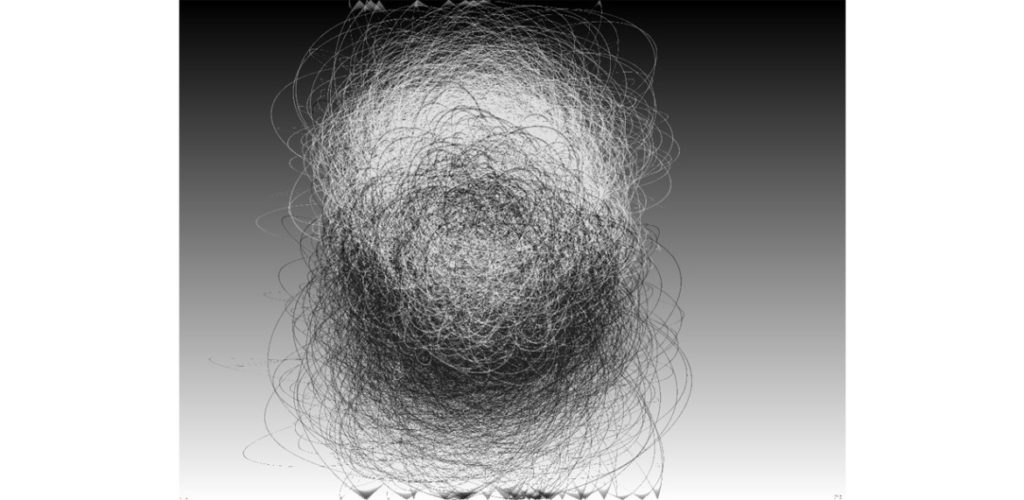
AD: Alain, you are a digital immigrant. What was the first media work in your collection? When did you buy it and why?
AL: My first experience with digital art was with bitforms gallery in NY, more than 10 years ago – at a time when it was really under the radar. I went to an exhibition by Mark Napier from whom I acquired a work at that time – one of the “Old Testament” pieces. That was very natural for me, because I was looking for some new kind of art. I knew enough of art history to know that every important movement in art was always linked to a social, economical, technological, psychological development in society. It was a time, when I was trying to collect works that were really addicted/connected to the actual world, the world around us. I was thinking, ok let’s put myself in 2150: when I’ll be using my third heart and my second brain, what will I say was important in the year 1999/ 2000? Without any doubt it will be the computer and the Internet 2.0 with Facebook and social networks and everything. Eventually I thought: wow people were creating art and it is digital. I immediately considered it to be a very important development for the arts.
AD: Wolf, you procure and sell digital art. What do you think today is the greatest obstacle to understanding the effect of new media?
WL: The sale and procurement via the Internet leads to superficiality. This is, at least, my perception. Experiencing art on a website, interactively or not, is often characterized by shorter cycles/loops compared to viewing the same website here in the gallery. I think we need, as we always did, a balance between the real and the virtual. And actually, this makes sense, because we ourselves do embody both. It’s a reason why the digital natives often express themselves in analog media – it’s no coincidence!
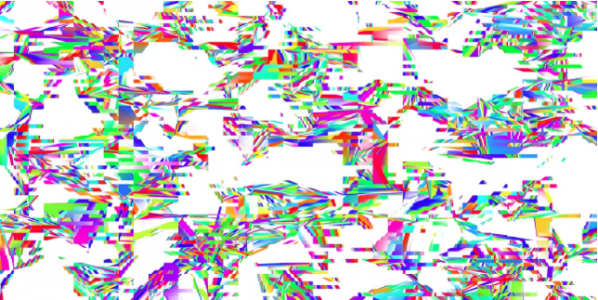
AD: Aram, your works stand at the charged interface between public and private, online and offline, between technological infatuation and everyday life, whereby you teach us how to better understand our new environment. ‘ Whoever sharpens our perception tends to [be] antisocial …’, said media theorist Marshall McLuhan. Is it true?
AB: Especially TODAY it is more important than ever to sharpen perception with regard to the effects of technological development. Two and a half years after Snowden the public discussion on privacy and mass surveillance continues to level off. While the big secret services use their hefty budgets to snow us under, and to lock the doors to the NSA, the interest in further explosive leaks from the Snowden documents is fading. ‘Nothing to hide’ is the mantra of the ‘Smart New World’, in which we can neither see nor sense the complex mechanisms of surveillance. In contrast to the dystopic Matrix scenario, our world will ever be fluffier, smarter and more comfortable, unless one has the wrong passport or sits on a bus next to a presumed terrorist. Then reality will be brutal. Precisely for these reasons it is so important to make the hidden, abstract data world understandable, whether through concrete images, objects, or installations. If you were to hold 8 volumes with 4.7 million passwords of LinkedIn users in your hand hand, you would suddenly understand the significance of the security of our online identities.
Copyright has been a relevant topic since the development of the printing press. It grants the author the exclusive right to reproduce, publish, and sell the content and form of intellectual property. The copy & paste mentality of the Internet user brought chaos to the system. The blockchain technology should now manage the author and marketing rights in a way that is more transparent, completely free of Bitcoin and monetary background. The idea had its origin in the art scene.
AD: Alain, do you think the further development of the blockchain lead to more transparency and protection against forgery?
AS: I would not use the word forgery, but certainly [against] an unfair use of material or a copyright infringement. I suppose that the blockchain is one path that should be investigated and tested for the copyright protection of online works of art. I believe in a transformation of the economy of the market for online art towards the direction of a wider distribution through, perhaps, a ‘renting’ of the work rather than an illusory acquisition (taking into account the copyright stays with the artist anyway). i-tunes and Spotify both adapted well to the online art economy.
AD: Wolf, do you make use of these new possibilities within the marketing of digital art? And have you already thought about a new currency model?
WL: I’ve already been confronted by this and I think that it makes sense. With my artists though there’s as yet no need or willingness. I’ve yet to engage with new currency models.
AD: Aram, to what extent is the blockchain and Bitcoin really discussed within artist circles?
AB: Services like Wikipedia, the Open-Source Software movement and, in principle, the entire World Wide Web wouldn’t exist at all today had Telco-payment-services pushed through its fee-based BTX/videotext with pay-per-view, in the 1980s. Naturally the possibility turns the never-ending reproduction of classic markets on its head, and in recent years, there have been extensive debates about copyright and intellectual property. We shouldn’t forget though, that a large part of the software that operates the Internet and millions of devices came about in the spirit of the sharing-culture. The blockchain is a powerful tool, which introduces a form of artificial scarcity into the digital environment. It’s up to each artist himself or herself whether and how he or she chooses to distribute their work. The art market and the demand will certainly create some model or other for the sale and distribution of art that only exists in bits and bytes. Let’s wait and see…
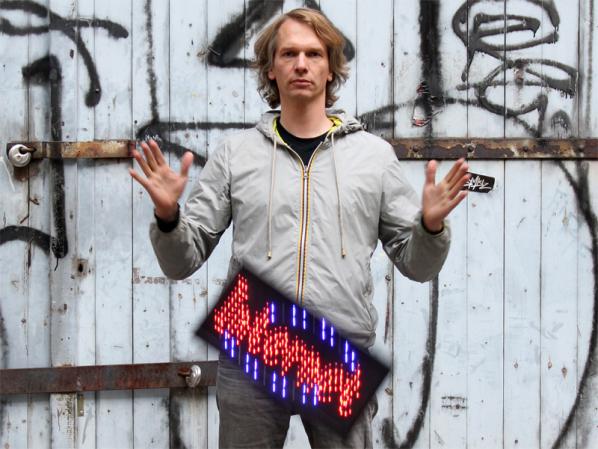
Many of both Bitcoin’s most vocal proponents and detractors agree that the way the cryptocurrency operates technologically determines the form of the economy and therefore the society that uses it. That society would be anarcho-capitalist, lacking state institutions (anarcho-) but enforcing commodity property law (capitalist). If this is true then Bitcoin has the potential to achieve a far greater political effect than financial engineering efforts like the Euro or quantitative easing and with far fewer resources. Perhaps variations on this technology can create alternatives to Bitcoin that determine or at least afford different socioeconomic orders.
Bitcoin is already more than half a decade old and “Crypto 2.0” systems that build on its underlying blockchain technology (the blockchain is a network-wide shared database built by consensus, Bitcoin uses it for its ledger) are starting to emerge. The most advanced allow the creation of entire organizations and systems of organization on the blockchain, as Decentralized Autonomous Organizations (DAOs). We can use them to help create those different socioeconomic orders.
Workers’ Councils are a Liberatarian Socialist system of organization. Rather than implementing Soviet-style centralized command economies, workers councils are decentralized and democratic. Workers in a particular workplace decide what their objectives are then appoint temporary (and instantly revocable) delegates to be responsible for them. Workplaces appoint representatives to local councils, local councils appoint representatives to regional councils, and so on, always temporarily and revocably. It is a system of face to face socialisation and political representation rather than top-down control.
This system emerged at various times in Europe, South America and the Middle East throughout the Twentieth Century. It is a very human method of governance, in stark contrast to the “trustless” code of Bitcoin as well as to the centralized politics of the Soviets. That said, technology can assist organization as easily as it can support material production. In the 1970s the cordones of Chile interfaced with the Allende government’s Project Cybersyn network, and contemporary online workers collectives can use the Internet to co-ordinate.
A DAO is a blockchain-based program that implements an organization’s governance and controls its resources using code rather than law. There can be a fetishistic quality to the idea of cold, hard, unyielding software perfect in its unambiguous transparency and incapable of human failing in its decision making. There can be similar fetishistic qualities to legal and political organizational perfectionism, this doesn’t disqualify any of their subjects as useful ideals however they need to be tempered pragmatically.
Using the public code and records of a DAO can help with the well known problem of structurelessness, and can store information more efficiently and reliably than a human being with a pen and paper. The much vaunted trustlessness of cryptovurrency and smart contract systems can help build trust in communication within and between groups – cryptographically signed minutes are relatively hard to forge although the ambiguity of language is impossible to avoid even in the mathematics of software.
The delegates of a workers’ council can be efficiently and transparently voted on, identified by, and recalled using a DAO. This makes even more sense for distributed groups of workers, groups that share a common cause but lack a geographic centre. Delegates can even be implemented as smart contracts, code written to control resource allocation and evaluate performance in the pursuit of their objective (unless recalled by the council that created them).
Entire councils, and inter-council organisation, can be supported or implemented in their organization as DAOs. Support includes communication and record keeping. Implementation included control of resources, running delegates as code, and even setting objectives for delegates programatically.
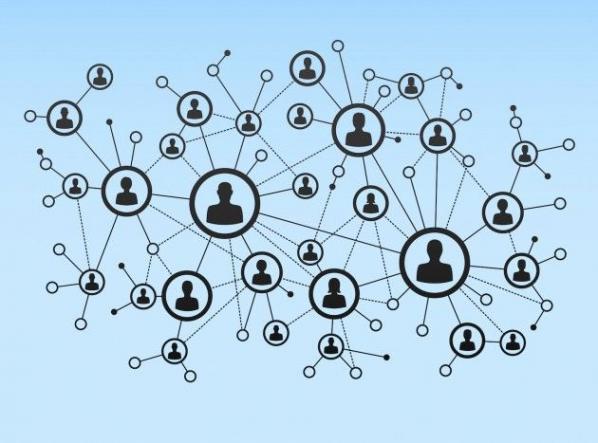
The latter finally brings the concept of DAOs into direct conflict with the spirit of the Workers’ Council. Councils exist to allow individual human beings to express and agree on their objectives, not to have them imposed from above. Being controlled by code is no better than political or economic control. It is the nature of this relationship to code, politics or the economy that is positive or negative – writing code to charge someone or something with seeing that a task be undertaken is no different from writing it in the minutes and makes mroe explicit that organization is production as the subject of work in itself. A democratic, recallable DAO that sets objectives is very different from a blob of capital with unchangeable orders to maximise its profits online.
The resources that a DAO controls need not be monetary (or tokenized). A DAO that controls access to property, energy or other resources can contribute to avoiding the pricing problem that conventional economics regarded as a showstopper for the Soviet cybernetic economic planning of “Red Plenty“. DAOs need not even be created to represent human organization – “deodands” can represent environmental commons as economic actors. These can then interact with workers council DAOs, representing environmental factors as social and economic peers and avoiding the neoliberal economic problems both of externalities and privatisation.
Workers Council DAOs – Decentralized Autonomous Workers Councils (DAWCs) are science fiction, but only just. Workers councils have existed and been plugged in to the network, structurelessnes and scalability are problems, DAOs exist and can help with this. Simply tokenizing “sharing economy” (actually rentier economy) forms, for example replacing Uber’s taxi sharing with La’zooz, while maintaining the exploitative logic of disintermediation isn’t enough.
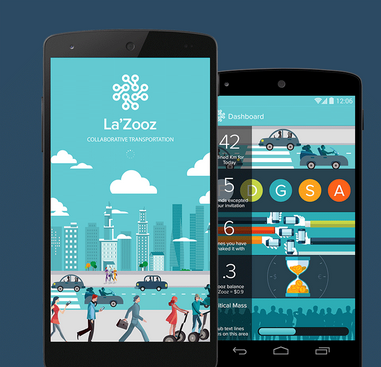
If we are unable or unwilling to accelerate the social and productive forces of technology to take us to the moon, we can at least embrace and extend them in a more human direction.
The text of this article is licenced under the Creative Commons BY-SA 4.0 Licence.
Featured image: Aram Bartholl, Forgot Your Password?, 2013
Historical art is developed by way of its respective era and society, meaning that it is always made in the present. Today, new technologies open up new possibilities for artistic potential. Currently, art production, which is influenced by new technologies, is reacting strongly to the changing times. Artworks are being created, which react to digitalisation, even if they don’t necessarily reflect the digital format itself (i.e. like works by Aram Bartholl).
In its purest form, digital art is ephemeral and based on a transient technology. The continual advancement of the technology demands on-going improvements; challenges from which many emerging artists refuse to be deterred. On the contrary: the monthly quota of events related to digital art proves the high level of interest around the form.
The global technical networks thereby bring about new atmospheres, or perhaps, infospheres, as media theorist Peter Weibel calls them. In the art world, previously held art-historical considerations are forced towards a re-evaluation. Conventional theories and practices must be called into question. New art forms in the immaterial digital domain demand a general rethink in terms of their conservation, presentation and acquisition. And, of course, the reception of digital art is also different.
According to studies by Hiscox, a preference for original works still dominates both in conventional and online trade. Authenticity and intrinsic value continue to be important criteria when it comes to decision-making regarding the purchase of art. Transparency will remain, for the long term, a fundamental prerequisite for the establishment of trust.
Most acquisitions of digital art take place conventionally by way of galleries. If a collector acquires, for example, a website, then the gallerist sells he or she a domain (which is unique!) and transfers in-addition, a licence contract. This is a material document. The ‘network’ remains virtual, while retaining open all of the attributes of an artwork in the source code, i.e. the artist’s signature, the title, the year in which it was produced, the technique, and information on the programmer or the collector.

The collector can enjoy the work beyond the confines of time and physical location. Simultaneously, he or she is responsible for its preservation, which is the guarantee for the continuation of its existence over time.
Internet art in general is dependant on software, but above all it relies on hardware (computer, hard-drive, interfaces, sensors, monitors, projectors, etc.). Yet for how long will the hardware remain a part of our interactive culture? Forward-looking collectors purchase, in addition to the contract, a series of devices that safeguard the work for the future.
The ability to learn about new approaches in our fast-moving culture occurs both naturally and dynamically. The art market is an extremely non-transparent market, access to the right networks and contacts. Is this likely to change any time soon?
Art history shows us that artists are ahead of their time, anticipating what is to come. One need only cast an eye around the scene, in order to open the door to new ideas and technological marketing methods in the art world.
The German artist, Stephan Vogler, has already done this and in cooperation with a law firm has unleashed intelligent synergies. The artist himself produces digital files – intangible goods, as he calls them – which should also naturally migrate to the art market over the long-term, in the best case scenario, as unique pieces which one – such is the thinking within his system – can acquire with Bitcoin.
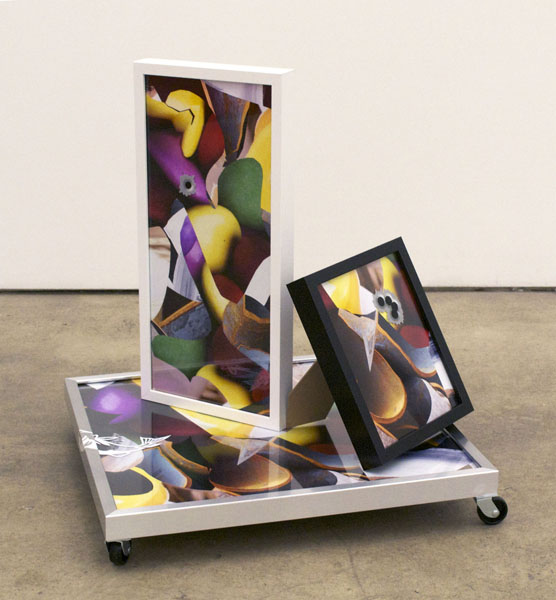
Far more interesting than the means of purchase, is the Bitcoin technology that lies behind it.
Stephan Vogler has developed a licence together with experts on legal practice within the art world, which transforms the digital artwork into an independently tradable virtual commodity, which is limited, both in terms of its technology and its legal rights. The system is based on a license agreement under the utilization of the Bitcoin technology. All works will come with an electronic signature, which is recognized, in legal terms, as being an original signature. This also serves as proof that the files existed at a given moment in time. Their authenticity is mathematically verifiable and the right of resale is exclusive. Virtual ownership is technically and legally limited to the respective owner. The owner of the usage rights is registered in a decentralized Bitcoin Blockchain, and the rights regarding the work are assigned through a Bitcoin transaction. In this way, digital artworks become both tradable and collectable objects without the requirement of their materialisation. Purchase and transaction take place simultaneously and the function of the custodian is eliminated. The structure behind the acquisition is thereby extremely transparent.
Artists like Stephan Vogler want to revolutionize the market for digital art through new technology. But independent from this fact, the art world is not sleeping. Collectors, institutions and art market platforms are already taking note.
For example, Austria’s Museum for Modern Art (MAK) has already bought an artwork with Bitcoin.
Cointemporary.com, a curated online platform, offers ephemeral artworks at a fixed Bitcoin (BTC) price – independent from the actual exchange rate. Berlin company ascribe.io develops systems within the Blockchain technology and offers services for art experts, assisting in the professional management of their digital files, i.e. their registration, archival, transfer of ownership etc.
The Winklevoss twins are known as great advocates of the digital currency. Rumours about investments in the art form are rife.
The acquisition of artworks via Bitcoin sounds forward-looking and simple yet should be enjoyed with a good degree of care. The reason for this is that Bitcoin is not controlled by a state and its central bank, but rather is generated by Internet users by way of complicated arithmetic calculations. So what might be the advantage of a Bitcoin purchase?
Collectors of digital art, such as the Belgian, Alain Servais, or Hampus Lindwall, from Sweden, view the purchase of work via the risky Bitcoin currency with scepticism.
It is still too early to really be able to judge the effects of these developments. Ultimately, the discussion as a whole concentrates far less on the system of currency than on the technology itself, which can also be applied to other circumstances. These experiments will only truly bear fruit through the development of a high degree of know-how, the courage to take on legal consequences at the moment of purchase, and through simple decisions in a user-friendly design.
Featured image: 144 Hours in Kiev: Instagram montage, all images courtesy of Lev Manovich
Lev Manovich’s upcoming keynote, along with the entire Art of the Networked Practice online symposium, March 31 – April 2, 2015, will be free, open and accessible via web-conference from anywhere in the world. Visit the Website to register. The symposium is in collaboration with Furtherfield.
While big data has infiltrated our everyday lives, Lev Manovich and his collaborators have explored the data of everyday life as a window on social transformation. We discuss his latest work: The Exceptional and the Everyday: 144 Hours in Kiev, a portrait of political upheaval in the Ukraine constructed from thousands of Instagram photos taken over a six day period during the revolution in February of 2014. The project evolves from Manovich’s recent manifestations, Phototrails (2013) and SelfieCity (2014), metamorphosing social media into data landscapes.
Randall Packer: How do you view social media as illuminating a broader understanding of crisis in times of political upheaval?
Lev Manovich: When the media covers exceptional events such as social upheavals, revolutions, and protests, typically they just show you a few professionally shot photographs that focus on this moment of protest at particular points in the city. So we were wondering if examining Instagram photos that were shared in the central part of Kiev would give us a different picture. Not necessarily an objective picture because Instagram has its own biases and it’s definitely not a transparent window into reality, but would give us, let’s say, a more democratic picture. So we’ve downloaded over 20,000 photos shared by 6,000 people, and using visualization we created a number of different views of reality with patterns contained in the data. And we were particularly interested to see how the images of the everyday exist side by side with images of extraordinary events: how images of demonstrations, confrontation with government forces, fire, smoke, and barricades exist next to selfies, parties, or empty streets.

RP: Is it possible to think of what you are doing as taking an activist position in terms of revealing truths about a political situation?
LM: We have to be careful because obviously what you are seeing in 144 Hours in Kiev is a relatively small part of the population. Because the people who do use Instagram create tags mostly in English, they are, maybe, pro-Western people. But it allows us to get a sense of, not necessarily of a truth, not necessarily of what’s real, but let’s say a different kind of picture, a different place of reality then what the journalists would get. Because journalists may go, talk to a few people, and then come up with a report. But here you have “quotes,” so to speak, of thousands of people.
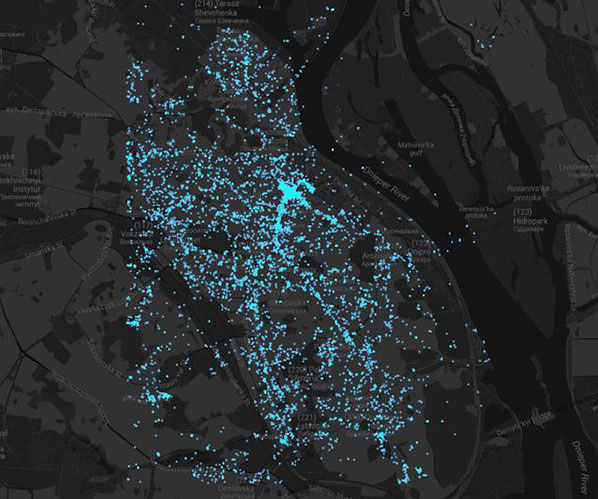
RP: Do you also see the collections of visualizations from user-generated images as an aesthetic realization?
LM: Perhaps one thing we can highlight is the idea of expressive visualization. As an artist I am also interested in the question of how can I present the world through the data. So let’s say a hundred years ago I would be taking photographs of a city. Now I can represent the city through 2 million Instagram photos. Thinking about landscape paintings in Impressionism, Fauvism, or even Cubism, how could I represent nature today through the contributions of millions of people? So I think of myself as an artist who is painting with data.
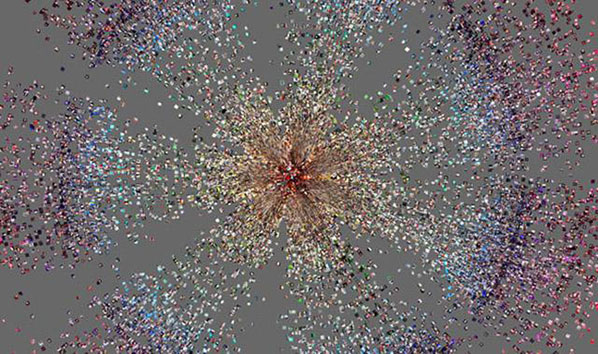
RP: But I’ve noticed that there is a focus in your writing on scientific methodology, you don’t talk very much about the renderings from an artistic perspective.
LM: It’s very clear that we’re taking ideas and techniques that have been used by modern artists. The difference is that we are pulling out data and writing open source tools. We’re taking in this case social media, works that were not created by us, and then putting them through different kinds of combinations. If you think about modernist collage of the city from the 1910s or 1920s, using pieces of newspaper and other existing media, what we’re doing exists in the same tradition.
RP: In many ways, the works can be fully appreciated as collage or composites, which I imagine goes against what you are trying to say through data analysis.
LM: No, it doesn’t go against what we are doing. It’s a matter of speaking to different parts of society. So you don’t just talk to designers or artists or like-minded people, you also talk to scientists. But ultimately what drives me is that I can I create something expressive, something unique, that isn’t just simply a data visualization, but creates an image that finds visual forms, that finds the right metaphors, which allows me to talk about modern society as consistent with its millions of data points. To me I think it’s a successful metaphor for how to speak about society today, when you think about all the traces you leave on social networks. I am trying to find the static visual forms to represent our new sense of society from seemingly random acts of individual people.

RP: Talk about the idea of “collective stories,” which are revealed in the composite of hundreds of thousands Instagram photos, each of which is a story in and of itself.
LM: We bring all these narratives together and try to make a kind of composite “film.” The connection to documentary, such as filmmakers like Dziga Vertov, for me is very clear. When Dziga Vertov, for example, was making his films in Kiev, he would have several cameramen in different parts of the Soviet Union shooting everyday, and they would send it to him and he would put it all together. So my “films” are made up of downloaded visuals, in which you can then make multiple “films” out of.
RP: Is it possible that the individual stories, the individual voice of expression, might get lost in this broad swath of data mining and cultural analytics?
LM: People are documenting what they think is interesting and important in their lives. But because there are very particular behaviors, what you get is a kind of pattern. I would say that patterns are not the same thing as a story. I don’t think of it as traditional narrative art, but rather a pattern of certain repeating behaviors.
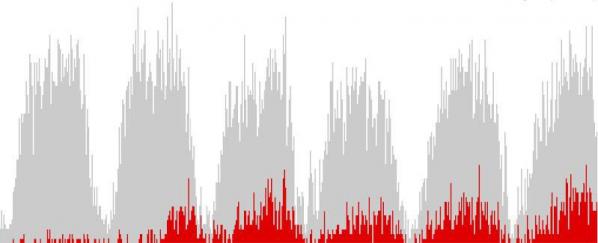
RP: How do you position the work you are doing in the context of the current crisis of invasive surveillance and the loss of privacy resulting from big data analysis?
LM: When we started thinking about these ideas in 2005, these issues were not on the table. In the last two or three years they have become central and to be honest they keep me up at night. I consider whether or not it’s OK because there are histories of governments using photographs of protests of honest people. I think the first time it happened seriously was in Prague in 1968 when it was raided by the Soviet Union. You had bystanders taking pictures, and when the pictures were found they were used to arrest people. So we thought a lot about it. When you start to individualize stories, when you start following particular people, then it gets really dangerous.
RP: In this sense its a very political project. What you have done is revealed that in the 21st century of social media it’s difficult to hide anything. What have you learned about contemporary life as seen through the lens of social media?
LM: This is a deep question. I’m basically trying to say that as opposed to a journalist who thinks about the “data” as a kind of truth, that it’s a way to find out what happened, what I’m thinking about is its own reality. It’s not a question of truth, it’s a question of making interesting connections.
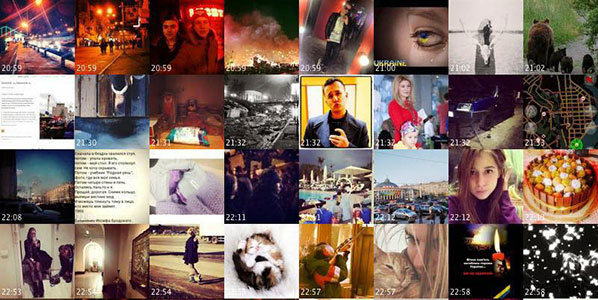
RP: That’s the difference between an artist and a journalist or even a scientist. You’re absorbing and you’re finding the connections but you’re not trying to say: this is it.
LM: I think the main answer is this: we can produce different visualizations out of the same data. Everyone views a different idea. It’s like when Monet paints another cathedral, there is not one painting that is correct. He makes a dozen paintings where every painting represents a different color, different atmospheric conditions, to show that in fact there are only the subjective views. So the goal is perhaps not to give people a new interpretation, but rather to challenge what they may be thinking is the correct one.
The Everyday and the Exceptional: 144 Hours in Kiev is a project of Lev Manovich in collaboration with Dr. Mehrdad Yazdani, Alise Tifentale, and Jay Chow.
Art, to misparaphrase Jeff Koons, reflects the ego of its audience. It flatters their ideological investments and symbolically resolves their contradictions. Literature’s readers and art’s viewers change over time, bringing different ways of reading and seeing to bear. This relationship is not static or one-way. The ideal audience member addressed by art at any given moment is as much produced by art as a producer of it. Those works that find lasting audiences influence other works and enter the canon. But as audiences change the way that the canon is constructed changes. And vice versa.
“The Digital Humanities” is the contemporary rebranding of humanities computing. Humanities for the age of Google rather than the East India Company.
Its currency is the statistical analysis of texts, images and other cultural resources individually or in aggregate (through “distant reading” and “cultural analytics“).
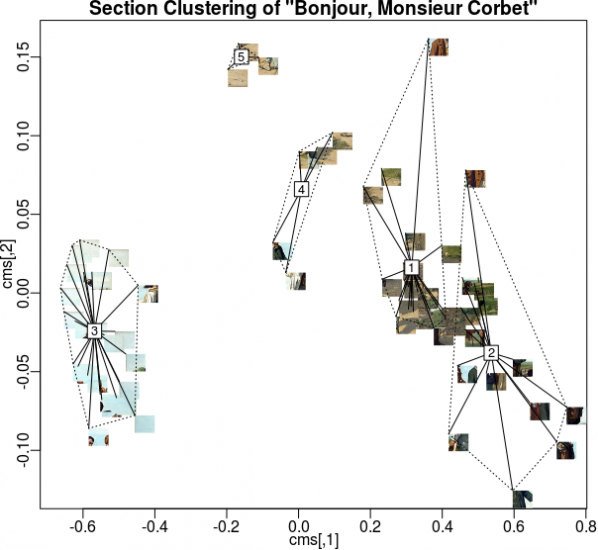
In the Digital Humanities, texts and images are read and viewed using computer algorithms. They are “read” and “viewed” by algorithms, which then act on what they perceive. Often in great number, thousands or millions of images or pages of text at a time, many more than a human being can consider at once.
The limitations of these approaches are obvious, but they provide a refreshing formal view of art that can support or challenge the imaginary lifeworld of Theory. They are also more realistic as a contemporary basis for the training of the administrative class, which was a historical social function of the humanities.
Digital Humanities algorithms are designed to find and report particular features of texts and images that are of interest to their operators. The most repeated words and names, the locations and valences of subjects, topics and faces and colours. They produce quantitative statistics regarding works as a whole or about populations of works rather than qualitiative reflection on the context of a work. Whether producing a numeric rating or score, or arranging words or images in clouds, the algorithms have the first and most complete view of the cultural works in any given Digital Humanities project.
This means that algorithms are the paradigmatic audience of art in the Digital Humanities.
Imagine an art that reflects their ego, or at least that addresses them directly.
Appealing to their attention directly is a form of creativity related to Search Engine Optimization (SEO) or spam generation. This could be done using randomly generated nonsense words and images for many algorithms, but as with SEO and spam ultimately we want to reach their human users or customers. And many algorithms expect words from specific lists or real-world locations, or images with particular formal properties.
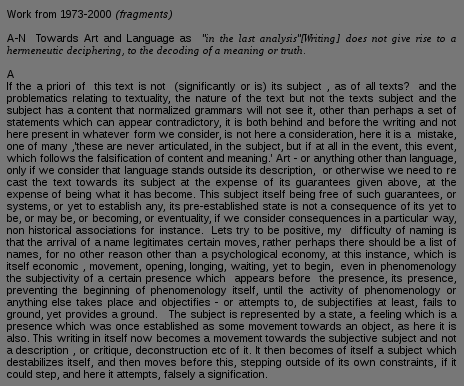
A satirical Markov Chain-generated text.
The commonest historical way of generating new texts and images from old is the Markov Chain, a simple statistical model of an existing work. Their output becomes nonsensical over time but this is not an issue in texts intended to be read by algorithms – they are not looking for global sense in the way that human readers are. The unpredictable output of such methods is however an issue as we are trying to structure new works to appeal to algorithms rather than superficially resemble old works as evaluated by a human reader.
The two kinds of analysis commonly performed on cultural works in the Digital Humanities require different statistical approaches. Single-work analyses include word counts, entropy measures and other measures that can be performed without reference to a corpus. Corpus analysis requires many works for comparison and includes methods such as tf-idf, k-means clustering, topic modeling and finding property ranges or averages.
ugly despairs racist data lunatic digital computing digital digital humanities digital victim furious horrific research text racism loathe computing text humanities betrayed digital text humanities whitewash computing computing cheaters brainwashing digital research university university research falsifypo pseudoscience research university worry research data technology computing humanities technology data technology research university research university computing greenwasher cruel computing university data disastrous research digital guilt technology university sinful loss victimized computing humiliated humanities university research ranter text text technology digital computing despair text technology data irritate humanities text data technology university heartbreaking digital humanities text chastising text hysteria text digital research destructive technology data anger technology murderous data computing idiotic humanities terror destroys data withdrawal liars university technology betrays loathed despondent data humanities
A text that will apear critical of the Digital Humanities to an algorithm,
created using negative AFINN words & words from Wikipedia’s “Digital Humanities” article
We can use our knowledge of these algorithms and of common training datasets such as the word valence list AFINN and the Yale Face Database, along with existing corpuses such as flickr, Wikipedia or Project Gutenberg, to create individual works and series of works packed with features for them to detect.
web isbn hurrah superb breathtaking hurrah outstanding superb breathtaking isbn breathtaking isbn breathtaking thrilled web internet hurrah media web internet outstanding thrilled hurrah web thrilled media thrilled superb breathtaking art breathtaking media superb hurrah superb net artists outstanding internet outstanding net superb thrilled thrilled art hurrah based outstanding superb net internet artists web art art artists internet breathtaking based net hurrah outstanding thrilled superb hurrah media based outstanding media art artists outstanding isbn based net based thrilled artists isbn breathtaking
A text that will appear supportive of Internet art to an algorithm,
made using positive AFINN words and words from Wikipedia’s “Internet Art” article.
When producing textual works for individual analysis, sentiment scores can be manufactured for terms associated with the works being read. Topics can be created by placing those terms in close proximity. Sentence lengths can be padded with stopwords that will not affect other analysis as they will be removed before it is performed. Named entities and geolocations can be associated, given sentiment scores, or made the subjects of topics. We can structure texts to be read by algorithms, not human beings, and cause those algorithms to perceive the results to be better than any masterpiece currently in the canon.
When producing textual works to be used in corpus analysis individual or large volumes of “poisoning” works can be used to skew the results of analysis of the body of work as a whole. The popular tf-idf algorithm relates properties of individual texts to properties of the group of texts being analysed. Changes in one text, or the addition of a new text, will skew this. Constructing a text to affect the tf-idf scores of the works in a corpus can change the words that are emphasized in each text.
The literature that these methods will produce will resemble the output of Exquisite Code, or the Kathy-Acker-uploaded-by-Bryce-Lynch remix aesthetic of Orphan Drift’s novel “Cyberpositive“. Manual intervention in and modification of the generated texts can structure them for a more human aesthetic, concrete- or code-poetry-style, or add content for human readers to be drawn to as a result of the texts being flagged by algorithms, as with email spam.
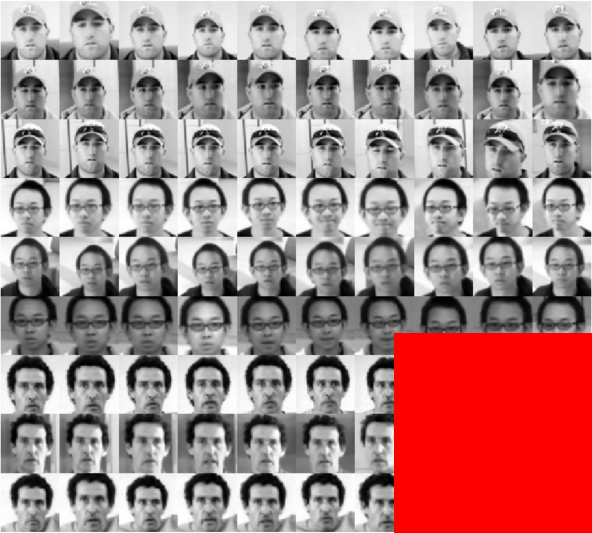
When producing images for individual analysis or analysis within a small corpus (at the scale of a show, series, or movement), arranging blocks of colour, noise, scattered dots or faces in a grid will play into algorithms that look for features or that divide images into sectors (top left, bottom right, etc.) to analyse and compare. If a human being will be analysing the results, this can be used to draw their attention to information or messages contained in the image or a sequence of images.
When producing image works for corpus analysis we can produce poisioning works with, for example, many faces or other features, high amounts of entropy, or that are very high contrast. These will affect the ranking of other works within the corpus and the properties of the corpus as a whole. If we wish to communicate with the human operators of algorithms then we can attach visual or verbal messages to peak shift works, or even in groups of works (think photo mosaics or photobombing).

The images that these methods will produce will look like extreme forms of net and glitch art, with features that look random or overemphasized to human eyes. Like the NASA ST5 spacecraft antenna, their aesthetic will be the result of algorithmic rather than human desire. Machine learning and vision algorithms contain hidden and unintended preferences, like the supernormal stimulus of abstract “superbeaks” that gull chicks will peck at even more excitedly than at those of their actual parents.
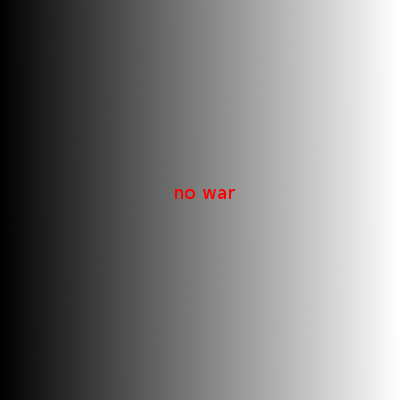
Such image and texts can be crafted by human beings, either directed at Digital Humanities methods to the exclusion of other stylistic concerns or optimised for them after the fact. Or it can be generated by software written for the purpose, taking human creativity out of the level of features of individual works.
Despite their profile in current academic debates the Digital Humanities are not the only, or even the leading, users of algorithms to analyse work in this way. Corporate analysis of media for marketing and filtering uses similar methods. So does state surveillance.
Every video uploaded to YouTube is examined by algorithms looking for copyrighted content that corporations have asked the site to treat as their exclusive property, regardless of the law. Every email you send via Gmail is scanned to place advertisements on it, and almost certainly to check for language that marks you out as a terrorist in the mind of the algorithms that are at the heart of intelligence agencies. Every blog post, social media comment and web site article you write is scanned by search and marketing algorithms, weaving them into something that isn’t quite a functional replacement for a theory. Even if no human being ever sees them.
This means that algorithms are the paradigmatic audience of culture generally in the post-Web 2.0 era.
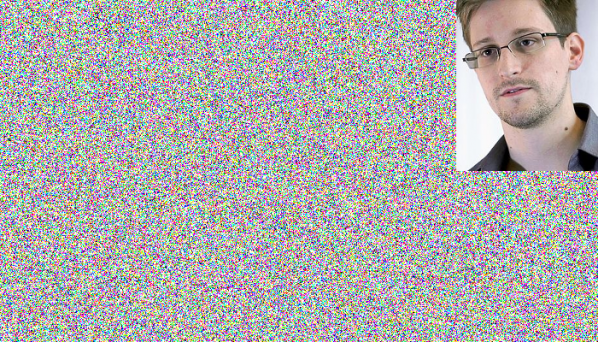
Works can be optimized to attract the attention of and affect the activity of these actors as well. Scripts to generate emails attracting the attention of the FBI or the NSA are an example of this kind of writing to be read by algorithms. So are the machine-generated web pages designed to boost traffic to other sites when read by Google’s PageRank algorithm. We can generate corpuses in this style to manipulate the social graphs and spending or browsing habits of real or imagined populations, creating literature for corporate and state surveillance algorithms.
Image generation to include faces of persons of interest, or with particular emotional or gender characteristics, containing particular products, tagged and geotagged can create art for Facebook, social media analytics companies and surveillance agencies to view. Again both relations within individual images and between images in a corpus can be constructed to create new data points or to manipulate and poison a larger corpus. Doing so turns manipulating aesthetics into political action.
Cultural works structured to be read first by algorithms and understood first through statistical methods, even to be read and understood only by them, are realistic in this environment. Works that address a human audience directly are not. This is true both of high culture, studied ideologically by the algorithms of the Digital Humanities, and mass culture, studied normatively by the algorithms of corporation and state.
Human actors hide behind algorithms. If High Frequency Trading made the rich poorer it would very quickly cease. But there is a gap between the self-image and the reality of any ideology, and the world of algorithms is no exception to this. It is in this gap that art made to address the methods of the digital humanities and their wider social cognates as its audience can be aesthetically and politically effective and realistic. Rather than laundering the interests that exploit algorithmic control by declaring algorithms’ prevalence to be essentially religious, let’s find exploits (in the hacker sense) on the technologies of perception and understanding being used to constructing the canon and the security state. Our audience awaits.
The text of this article is licenced under the Creative Commons BY-SA 4.0 Licence.
Featured image: Image “earth” by Beth Scupham https://goo.gl/ZMBzuw (Creative Commons Attribution)
Brett Scott is the author of The Heretic’s Guide to Global Finance: Hacking the Future of Money (Pluto Press: 2013). And writes for various publications, including The Guardian, Wired Mag and New Scientist, and commentate on issues like financial reform, cryptocurrency and peer-to-peer systems. he is also involved in projects related to alternative finance, financial activism, and economic justice, such as Action Aid, World Development Movement, Open Oil, The Finance Innovation Lab, and MoveYourMoney UK.
In Kim Stanley Robinson’s epic 1993 sci-fi novel Red Mars, a pioneering group of scientists establish a colony on Mars. Some imagine it as a chance for a new life, run on entirely different principles from the chaotic Earth. Over time, though, the illusion is shattered as multinational corporations operating under the banner of governments move in, viewing Mars as nothing but an extension to business-as-usual.
It is a story that undoubtedly resonates with some members of the Bitcoin community. The vision of a free-floating digital cryptocurrency economy, divorced from the politics of colossal banks and aggressive governments, is under threat. Take, for example, the purists at Dark Wallet, accusing the Bitcoin Foundation of selling out to the regulators and the likes of the Winklevoss Twins.
Bitcoin sometimes appears akin to an illegal immigrant, trying to decide whether to seek out a rebellious existence in the black-market economy, or whether to don the slick clothes of the Silicon Valley establishment. The latter position – involving publicly accepting regulation and tax whilst privately lobbying against it – is obviously more acceptable and familiar to authorities.
Of course, any new scene is prone to developing internal echo chambers that amplify both commonalities and differences. While questions regarding Bitcoin’s regulatory status lead hyped-up cryptocurrency evangelists to engage in intense sectarian debates, to many onlookers Bitcoin is just a passing curiosity, a damp squib that will eventually suffer an ignoble death by media boredom. It is a mistake to believe that, though. The core innovation of Bitcoin is not going away, and it is deeper than currency.
What has been introduced to the world is a method to create decentralised peer-validated time-stamped ledgers. That is a fancy way of saying it is a method for bypassing the use of centralised officials in recording stuff. Such officials are pervasive in society, from a bank that records electronic transactions between me and my landlord, to patent officers that record the date of new innovations, to parliamentary registers noting the passing of new legislative acts.
The most visible use of this technical accomplishment is in the realm of currency, though, so it is worth briefly explaining the basics of Bitcoin in order to understand the political visions being unleashed as a result of it.

Banks are information intermediaries. Gone are the days of the merchant dumping a hoard of physical gold into the vaults for safekeeping. Nowadays, if you have ‘£350 in the bank’, it merely means the bank has recorded that for you in their data centre, on a database that has your account number and a corresponding entry saying ‘350’ next to it. If you want to pay someone electronically, you essentially send a message to your bank, identifying yourself via a pin or card number, asking them to change that entry in their database and to inform the recipient’s bank to do the same with the recipient’s account.
Thus, commercial banks collectively act as a cartel controlling the recording of transaction data, and it is via this process that they keep score of ‘how much money’ we have. To create a secure electronic currency system that does not rely on these banks thus requires three interacting elements. Firstly, one needs to replace the private databases that are controlled by them. Secondly, one needs to provide a way for people to change the information on that database (‘move money around’). Thirdly, one needs to convince people that the units being moved around are worth something.
To solve the first element, Bitcoin provides a public database, or ledger, that is referred to reverently as the blockchain. There is a way for people to submit information for recording in the ledger, but once it gets recorded, it cannot be edited in hindsight. If you’ve heard about bitcoin ‘mining’ (using ‘hashing algorithms’), that is what that is all about. A scattered collective of mercenary clerks essentially hire their computers out to collectively maintain the ledger, baking (or weaving) transaction records into it.
Secondly, Bitcoin has a process for individuals to identify themselves in order to submit transactions to those clerks to be recorded on that ledger. That is where public-key cryptography comes in. I have a public Bitcoin address (somewhat akin to my account number at a bank) and I then control that public address with a private key (a bit like I use my private pin number to associate myself with my bank account). This is what provides anonymity.
The result of these two elements, when put together, is the ability for anonymous individuals to record transactions between their bitcoin accounts on a database that is held and secured by a decentralised network of techno-clerks (‘miners’). As for the third element – convincing people that the units being transacted are worth something – that is a more subtle question entirely that I will not address here.
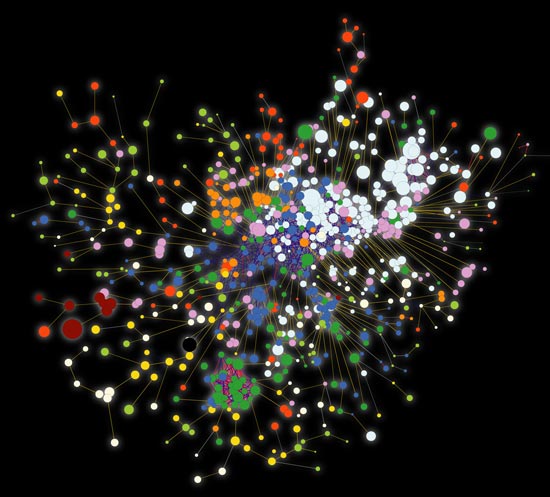
Note the immediate political implications. Within the Bitcoin system, a set of powerful central intermediaries (the cartel of commercial banks, connected together via the central bank, underwritten by government), gets replaced with a more diffuse network intermediary, apparently controlled by no-one in particular.
This generally appeals to people who wish to devolve power away from banks by introducing more diversity into the monetary system. Those with a left-wing anarchist bent, who perceive the state and banking sector as representing the same elite interests, may recognise in it the potential for collective direct democratic governance of currency. It has really appealed, though, to conservative libertarians who perceive it as a commodity-like currency, free from the evils of the central bank and regulation.
The corresponding political reaction from policy-makers and establishment types takes three immediate forms. Firstly, there are concerns about it being used for money laundering and crime (‘Bitcoin is the dark side’). Secondly, there are concerns about consumer protection (‘Bitcoin is full of cowboy operators’). Thirdly, there are concerns about tax (‘this allows people to evade tax’).
The general status quo bias of regulators, who fixate on the negative potentials of Bitcoin whilst remaining blind to negatives in the current system, sets the stage for a political battle. Bitcoin enthusiasts, passionate about protecting the niche they have carved out, become prone to imagining conspiratorial scenes of threatened banks fretfully lobbying the government to ban Bitcoin, or of paranoid politicians panicking about the integrity of the national currency.

Outside the media hype around these Bitcoin dramas, though, a deeper movement is developing. It focuses not only on Bitcoin’s potential to disrupt commercial banks, but also on the more general potential for decentralised blockchains to disrupt other types of centralised information intermediaries.
Copyright authorities, for example, record people’s claims to having produced a unique work at a unique date and authoritatively stamp it for them. Such centralised ‘timestamping’ more generally is called ‘notarisation’. One non-monetary function for a Bitcoin-style blockchain could thus be to replace the privately controlled ledger of the notary with a public ledger that people can record claims on. This is precisely what Proof of Existence and Originstamp are working on.
And what about domain name system (DNS) registries that record web addresses? When you type in a URL like www.e-ir.info, the browser first steers you to aDNS registry like Afilias, which maintains a private database of URLs alongside information on which IP address to send you to. One can, however, use a blockchain to create a decentralised registry of domain name ownership, which is what Namecoin is doing. Theoretically, this process could be used to record share ownership, land ownership, or ownership in general (see, for example, Mastercoin’s projects).
The biggest information intermediaries, though, are often hidden in plain sight. What is Facebook? Isn’t it just a company that you send information to, which is then stored in their database and subsequently displayed to you and your friends? You log in with your password (proving your identity), and then can alter that database by sending them further messages (‘I’d like to delete that photo’). Likewise with Twitter, Dropbox, and countless other web services.
Unlike the original internet, which was largely used for transmission of static content, we experience sites like Facebook as interactive playgrounds where we can use programmes installed in some far away computer. In the process of such interactivity, we give groups like Facebook huge amounts of information. Indeed, they set themselves up as information honeytraps in order to create a profit-making platform where advertisers can sell you things based on the information. This simultaneously creates a large information repository for authorities like the NSA to browse. This interaction of corporate power and state power is inextricably tied to the profitable nature of centrally held data.
But what if you could create interactive web services that did not revolve around single information intermediaries like Facebook? That is precisely what groups like Ethereum are working towards. Where Bitcoin is a way to record simple transaction information on a decentralised ledger, Ethereum wants to create a ‘decentralised computational engine’. This is a system for running programmes, or executing contracts, on a blockchain held in play via a distributed network of computers rather than Mark Zuckerberg’s data centres.
It all starts to sounds quite sci-fi, but organisations like Ethereum are leading the charge on building ‘Decentralised Autonomous Organisations’, hardcoded entities that people can interact with, but that nobody in particular controls. I send information to this entity, triggering the code and setting in motion further actions. As Bitshares describes it, such an organisation “has a business plan encoded in open source software that executes automatically in an entirely transparent and trustworthy manner.”
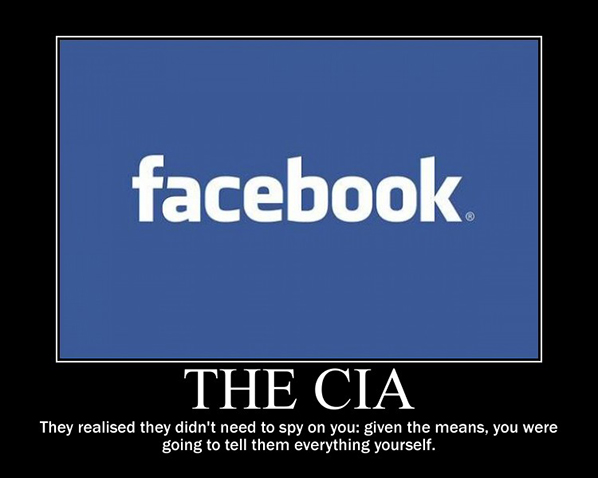
By removing a central point of control, decentralised systems based on code – whether they exist to move Bitcoin tokens around, store files, or build contracts – resemble self-contained robots. Mark Zuckerberg of Facebook or Jamie Dimon of JP Morgan Chase are human faces behind the digital interface of the services they run. They can overtly manipulate, or bow in to pressure to censor. A decentralised currency or a decentralised version of Twitter seems immune from such manipulation.
It is this that gives rise to a narrative of empowerment and, indeed, at first sight this offers an exhilarating vision of self-contained outposts of freedom within a world otherwise dominated by large corruptible institutions. At many cryptocurrency meet-ups, there is an excitable mix of techno-babble infused with social claims. The blockchain can record contracts between free individuals, and if enforcement mechanisms can be coded in to create self-enforcing ‘smart contracts’, we have a system for building encoded law that bypasses states.
Bitcoin and other blockchain technologies, though, are empowering right now precisely because they are underdogs. They introduce diversity into the existing system and thereby expand our range of tools. In the minds of hardcore proponents, though, blockchain technologies are more than this. They are a replacement system, superior to existing institutions in every possible way. When amplified to this extreme, though, the apparently utopian project can begin to take on a dystopian, conservative hue.
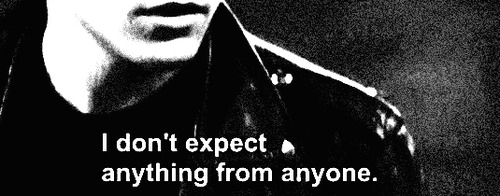
When asked about why Bitcoin is superior to other currencies, proponents often point to its ‘trustless’ nature. No trust needs be placed in fallible ‘governments and corporations’. Rather, a self-sustaining system can be created by individuals following a set of rules that are set apart from human frailties or intervention. Such a system is assumed to be fairer by allowing people to win out against those powers who can abuse rules.
The vision thus is not one of bands of people getting together into mutualistic self-help groups. Rather, it is one of individuals acting as autonomous agents, operating via the hardcoded rules with other autonomous agents, thereby avoiding those who seek to harm their interests.
Note the underlying dim view of human nature. While anarchist philosophers often imagine alternative governance systems based on mutualistic community foundations, the ‘empowerment’ here does not stem from building community ties. Rather it is imagined to come from retreating from trust and taking refuge in a defensive individualism mediated via mathematical contractual law.
It carries a certain disdain for human imperfection, particularly the imperfection of those in power, but by implication the imperfection of everyone in society. We need to be protected from ourselves by vesting power in lines of code that execute automatically. If only we can lift currency away from manipulation from the Federal Reserve. If only we can lift Wikipedia away from the corruptible Wikimedia Foundation.
Activists traditionally revel in hot-blooded asymmetric battles of interest (such as that between StrikeDebt! and the banks), implicitly holding an underlying faith in the redeemability of human-run institutions. The Bitcoin community, on the other hand, often seems attracted to a detached anti-politics, one in which action is reduced to the binary options of Buy In or Buy Out of the coded alternative. It echoes consumer notions of the world, where one ‘expresses’ oneself not via debate or negotiation, but by choosing one product over another. We’re leaving Earth for Mars. Join if you want.
It all forms an odd, tense amalgam between visions of exuberant risk-taking freedom and visions of risk-averse anti-social paranoia. This ambiguity is not unique to cryptocurrency (see, for example, this excellent parody of the trustless society), but in the case of Bitcoin, it is perhaps best exemplified by the narrative offered by Cody Wilson in Dark Wallet’s crowdfunding video. “Bitcoin is what they fear it is, a way to leave… to make a choice. There’s a system approaching perfection, just in time for our disappearance, so, let there be dark”.

But where exactly is this perfect system Wilson is disappearing to?
Back in the days of roving bands of nomadic people, the political option of ‘exit’ was a reality. If a ruler was oppressive, you could actually pack up and take to the desert in a caravan. The bizarre thing about the concept of ‘exit to the internet’ is that the internet is a technology premised on massive state and corporate investment in physical infrastructure, fibre optic cables laid under seabeds, mass production of computers from low-wage workers in the East, and mass affluence in Western nations. If you are in the position to be having dreams of technological escape, you are probably not in a position to be exiting mainstream society. You are mainstream society.
Don’t get me wrong. Wilson is a subtle and interesting thinker, and it is undoubtedly unfair to suggest that he really believes that one can escape the power dynamics of the messy real world by finding salvation in a kind of internet Matrix. What he is really trying to do is to invoke one side of the crypto-anarchist mantra of ‘privacy for the weak, but transparency for the powerful’.
That is a healthy radical impulse, but the conservative element kicks in when the assumption is made that somehow privacy alone is what enables social empowerment. That is when it turns into an individualistic ‘just leave me alone’ impulse fixated with negative liberty. Despite the rugged frontier appeal of the concept, the presumption that empowerment simply means being left alone to pursue your individual interests is essentially an ideology of the already-empowered, not the vulnerable.
This is the same tension you find in the closely related cypherpunk movement. It is often pitched as a radical empowerment movement, but as Richard Boase notes, it is “a world full of acronyms and codes, impenetrable to all but the most cynical, distrustful, and political of minds.” Indeed, crypto-geekery offers nothing like an escape from power dynamics. One merely escapes to a different set of rules, not one controlled by ‘politicians’, but one in the hands of programmers and those in control of computing power.
It is only when we think in these terms that we start to see Bitcoin not as a realm ‘lacking the rules imposed by the state’, but as a realm imposing its own rules. It offers a form of protection, but guarantees nothing like ‘empowerment’ or ‘escape’.
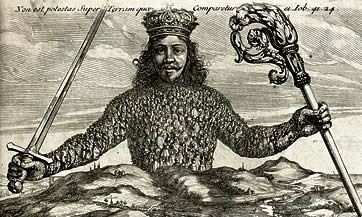
Technology often seems silent and inert, a world of ‘apolitical’ objects. We are thus prone to being blind to the power dynamics built into our use of it. For example, isn’t email just a useful tool? Actually, it is highly questionable whether one can ‘choose’ whether to use email or not. Sure, I can choose between Gmail or Hotmail, but email’s widespread uptake creates network effects that mean opting out becomes less of an option over time. This is where the concept of becoming ‘enslaved to technology’ emerges from. If you do not buy into it, you will be marginalised, and thatis political.
This is important. While individual instances of blockchain technology can clearly be useful, as a class of technologies designed to mediate human affairs, they contain a latent potential for encouraging technocracy. When disassociated from the programmers who design them, trustless blockchains floating above human affairs contains the specter of rule by algorithms. It is a vision (probably accidently) captured by Ethereum’s Joseph Lubin when he says “There will be ways to manipulate people to make bad decisions, but there won’t be ways to manipulate the system itself”.
Interestingly, it is a similar abstraction to that made by Hobbes. In his Leviathan, self-regarding people realise that it is in their interests to exchange part of their freedom for security of self and property, and thereby enter into a contract with aSovereign, a deified personage that sets out societal rules of engagement. The definition of this Sovereign has been softened over time – along with the fiction that you actually contract to it – but it underpins modern expectations that the government should guarantee property rights.
Conservative libertarians hold tight to the belief that, if only hard property rights and clear contracting rules are put in place, optimal systems spontaneously emerge. They are not actually that far from Hobbes in this regard, but their irritation with Hobbes’ vision is that it relies on politicians who, being actual people, do not act like a detached contractual Sovereign should, but rather attempt to meddle, make things better, or steal. Don’t decentralised blockchains offer the ultimate prospect of protected property rights with clear rules, but without the political interference?
This is essentially the vision of the internet techno-leviathan, a deified crypto-sovereign whose rules we can contract to. The rules being contracted to are a series of algorithms, step by step procedures for calculations which can only be overridden with great difficulty. Perhaps, at the outset, this represents, à la Rousseau, the general will of those who take part in the contractual network, but the key point is that if you get locked into a contract on that system, there is no breaking out of it.
This, of course, appeals to those who believe that powerful institutions operate primarily by breaching property rights and contracts. Who really believes that though? For much of modern history, the key issue with powerful institutions has not been their willingness to break contracts. It has been their willingness to use seemingly unbreakable contracts to exert power. Contracts, in essence, resemble algorithms, coded expressions of what outcomes should happen under different circumstances. On average, they are written by technocrats and, on average, they reflect the interests of elite classes.
That is why liberation movements always seek to break contracts set in place by old regimes, whether it be peasant movements refusing to honour debt contracts to landlords, or the DRC challenging legacy mining concessions held by multinational companies, or SMEs contesting the terms of swap contracts written by Barclays lawyers. Political liberation is as much about contesting contracts as it is about enforcing them.
The point I am trying to make is that you do not escape the world of big corporates and big government by wishing for a trustless set of technologies that collectively resemble a technocratic crypto-sovereign. Rather, you use technology as a tool within ongoing political battles, and you maintain an ongoing critical outlook towards it. The concept of the decentralised blockchain is powerful. The cold, distrustful edge of cypherpunk, though, is only empowering when it is firmly in the service of creative warm-blooded human communities situated in the physical world of dirt and grime.
Perhaps this means de-emphasising the focus on how blockchains can be used to store digital assets or property, and focusing rather on those without assets. For example, think of the potential of blockchain voting systems that groups like Restart Democracy are experimenting with. Centralised vote-counting authorities are notorious sources of political anxiety in fragile countries. What if the ledger recording the votes cast was held by a decentralised network of citizens, with voters having a means to anonymously transmit votes to be stored on a publicly viewable database?
We do not want a future society free from people we have to trust, or one in which the most we can hope for is privacy. Rather, we want a world in which technology is used to dilute the power of those systems that cause us to doubt trust relationships. Screw escaping to Mars.
If you enjoyed this article, please consider…
I sometimes spend weeks writing these articles, and don’t generally get paid to do it, so if you enjoyed please consider doing one or two of the following:
1. Donate by buying me a virtual beer
2. Tweet: You can tweet it out here
3. Share it on your Facebook wall here
4. Email it to a friend from here
5. Leave a comment!
6. Submit to Reddit
7. Link to the article from your own blog so your readers can see it too
Cheers!
(Please note that I originally wrote this essay for E-International Relations, and I have republished it here on a Creative Commons licence. If you wish to republish this piece, please respect E-IR’s republishing guidelines)
[Notes:
1. These are the minimally reformatted and slightly expanded notes for what would have been a 15-minute presentation.
2. The presentation was meant to be followed by questions and form part of the introduction to a panel discussion. Any questions in the comments here or on netbehaviour gratefully received.]
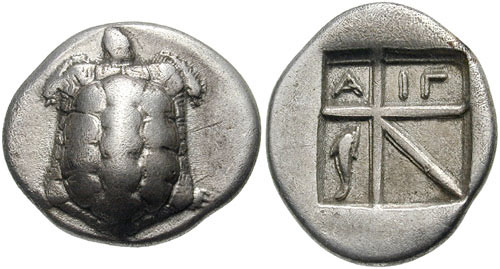
Art and money have always been involved in each other’s production. This is a Greek Drachma from 600BC with a relief depiction of a sea turtle on one side. For many people this would be the artwork, or at least the image, that they saw most frequently in their everyday lives.
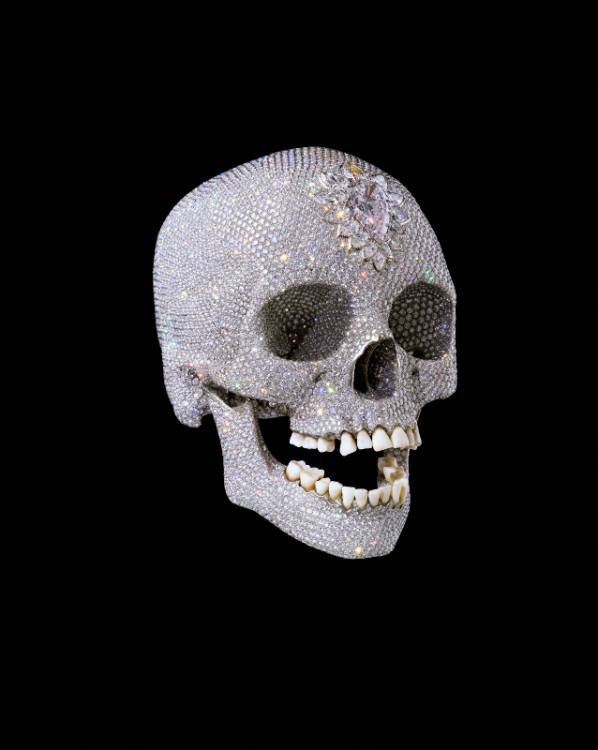
In the present day, high art and high finance (or big art and big finance) go hand in hand. Blue chip artworks produced by brand name artists like Jeff Koons are collected by hedge fund managers and oil oligarchs as investments and as signifiers of socioeconomic position (while stolen Old Master paintings are used as signifiers of value in transactions between criminal gangs…). This tendency reaches its logical conclusion for now with Damien Hirst’s “For The Love of God” (2007), a diamond-encrusted platinum cast of an actual human skull complete with the original teeth. It was sold for fifty million pounds sterling.

Looking inside the sale of “For The Love Of God” makes its narrative less straightforward. It was sold to a group including the artist and their dealer, making the actual figure and its ownership less straightforward than a simple sale would suggest. Nanex’s High Frequency Trading visualizations from 2010 look inside transcations in electronic stocks & shares markets, finding aesthetic forms in the activity of share trading bots. What the sawtooth waves of this bot’s activity represent is unknown: a glitch, a strategy, a side-effect. But without making these forms visible, we would not be able to ask these questions or reflect on this economic activity.
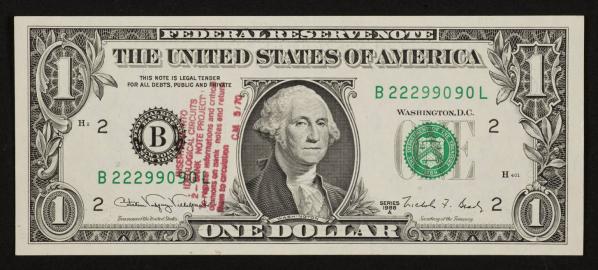
It is part of the value of art, particularly Conceptual Art, that it can afford us these opportunities for reflection and critique. Cildo Meireles’ “Insertions Into Ideological Circuits 2” (1970) overwrites the contemporary equivalent of the Drachma’s turtle with a rubber stamped message on a banknote, intruding into everyday use and circulation of currency in order to give its audience a pause for critical reflection.
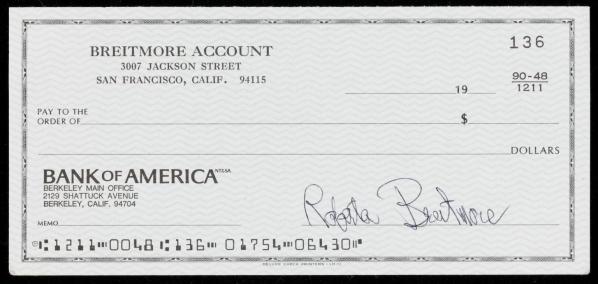
Lynn Hershman’s “Check” (1974) is signed by their artistic alter ego Roberta Breitmore, using financial transactions and their attendant contracts as a producer and guarantor of identity, literally underwriting it.
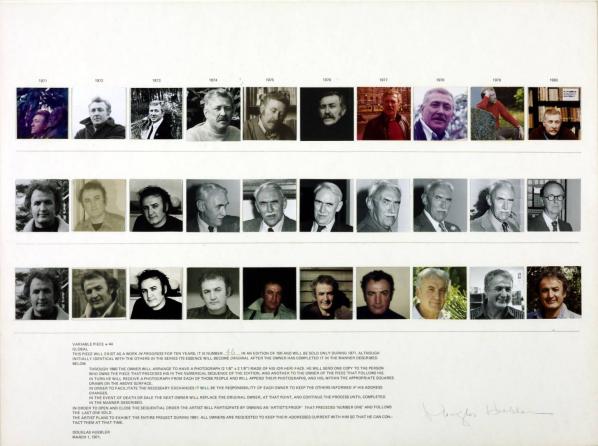
Douglas Huebler’s “Variable Piece no.44” (1971) incorporates an image of its current owner into itself each year for its first decade, in an analogue precedent for Bruce Sterling’s idea of “spimes”. When the artwork is sold a new owner appears, making the artwork’s contingent economics its aesthetic subject.

The initial critique of the ontology and economics of art that Conceptual Art represented in its “dematerialisation” phase represented as much of a challenge for the livelihoods of artists as it did to its chosen targets. One solution found early on was to produce certificates of authenticity or ownership for otherwise un-ownable art. This re-appropriates conceptual art for scarcity economics and as property, returning it to the market. Sol LeWitt’s certificates for two wall drawings (1980) demonstrate how this works. If you own such a certificate and I do not, and we both follow the instructions on the certificate, you produce an authentic LeWitt and I at best produce a forgery.
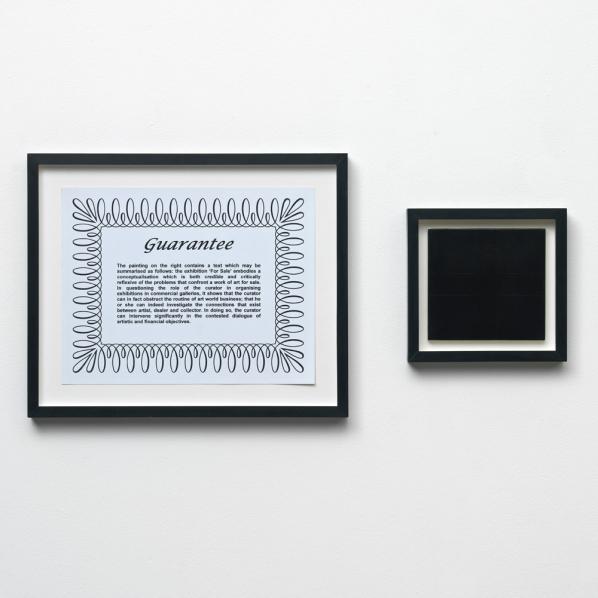
This stretegy was criticised (and parodied) within the Conceptual Art movement itself. An early Art & Language artwork, “Guaranteed Painting” (1967), contains a printed certificate guaranteeing that the painting accompanying it contains particular content and addressing the curator of the show it appears in as someone who can possibly intervene in artworld economic relationships.
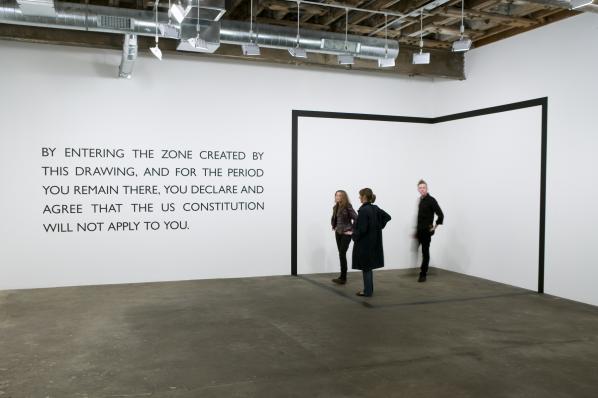
Carey Young’s “Declared Void” (2005) is a wall drawing that creates a space in which its audience enters into a contract agreeing that the constitution of the United States. Legal form as sculptural form, this is no longer about the relationship between art and money but rather between the individual, contract law, and the state. This is the kind of relationship that produces money, or at least fiat currency, and is a broader context for considering the more specific relationship between art and money.

I love this flower currency from 2005, produced by a group of Viennese artists. It’s both a LETS-style complementary currency and a use of the aesthetics of pressing flowers to allegorize and aestheticize the relationship between nature, production, and value in economies.
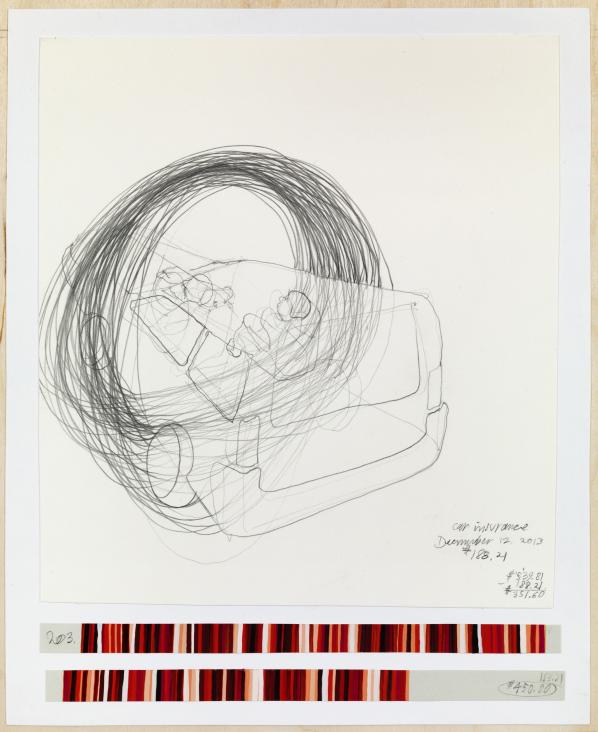
This Danica Phelps stripe drawing (2013) shows the artist’s expenditure on reparing their car. If it depicted income rather than outcome the stripes would be green rather than red. Phelps’ work combines the ledger of their economic existence with the artistic record of their social presence.

Bitcoin emerged as a critique of state-issued “fiat” currency following the financial crisis of 2008. Bitcoin is a cryptocurrency, a piece of software that runs on computers (“nodes”) spread across the network that communicate with each other to reach a shared consensus on the current state of a cryptographically-secured ledger. Every ten minutes or so these computers bundle up transactions into “blocks”, each of which refers to the previous block. This is the “blockchain”. This is yodark’s fanciful depiction of the blockchain proceeding from the first block of transactions, the “genesis block”.
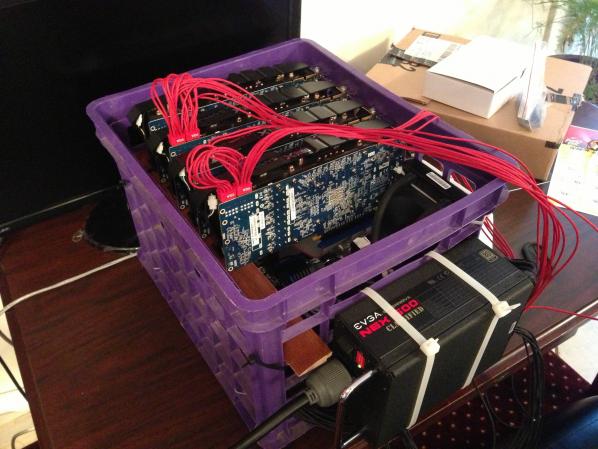
In reality news blocks in the chain are validated (or “mined”) by nodes in the network using increasingly specialised hardware, such as this milk crate mining rig from a couple of years ago. They perform difficult to solve but easy to validate sums on each block, the “proof of work”, and the first node to succeed gets a reward (paid in Bitcoins) for doing so.
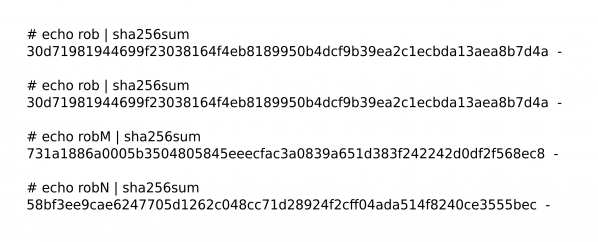
Bitcoin account addresses, Bitcoin transactions, and the proof of work system all use cryptographic algorithms. These are mathematical ways of taking data and creating an almost un-fakeable, almost un-reversable, almost unique (where “almost” means “as likely to fail as the Earth is likely to be hit by a civilization-ending asteroid in the next 20 minutes”) identity for it. The examples here show how feeding a cryptographic hash function the same data twice results in the same incredibly unlikely number, but feeding it even slightly different data results in very different and unrelated numbers.
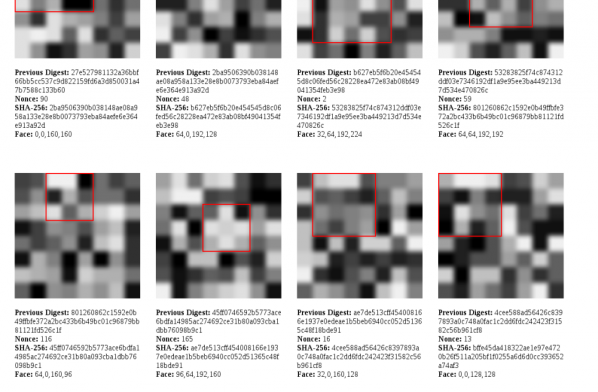
Bitcoin uses these functions to secure its network in the “proof of work” system by searching for auspicious numbers in their output (strings of zeroes in the current scheme). My Facecoin (2014) implements an alternative proof of work system in which the useless work performed is that of portraiture, (mis-)using machine vision algorithms to find imaginary faces in cryptographic hashes represented as bitmaps rather than numbers.
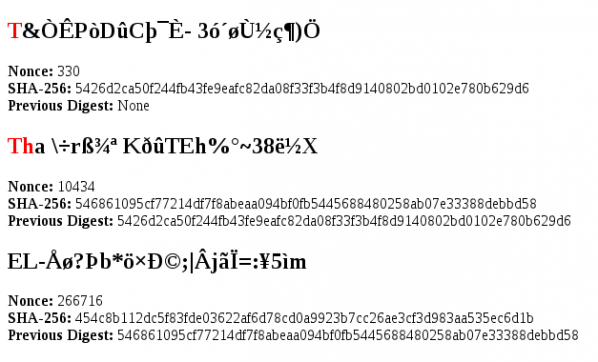
My Monkeycoin (2014) takes a different approach, searching for the complete works of shakespeare in textual representations of those numbers.
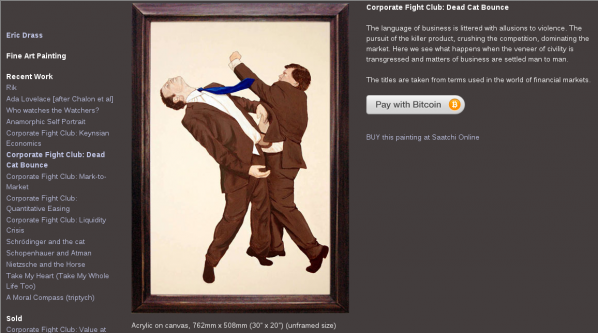
Cryptocurrencies can be used in lieu of fiat currency for all kinds of transactions, including artistic ones. Here the artist Eric Drass is offering a painting for sale via Bitcoin. Different means of exhange create different kinds of social relationships, buying the painting via Bitcoin is a different kind of social and economic transaction than paying with fiat currency for it via Saatchi Online.

Cryptocurrencies can be created as complimentary currencies with specific intent or for specific constituencies. This is the logo of Banksycoin (2014), an attempt to create a currency to pay for art and create a parallel economy for artistic production.
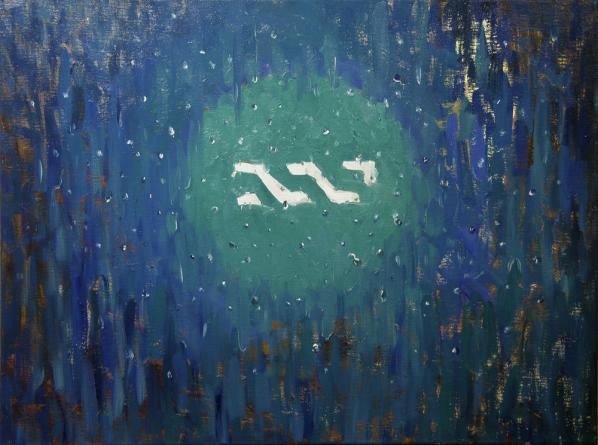
Cryptocurrency-based technology can change how individual artworks are owned as well as paid for. This is theironman’s “nxtdrop” (2014), the ownership of which is represented by shares on the “nxt” blockchain. Ownership of the painting can be changed fractionally by dealing in those shares.
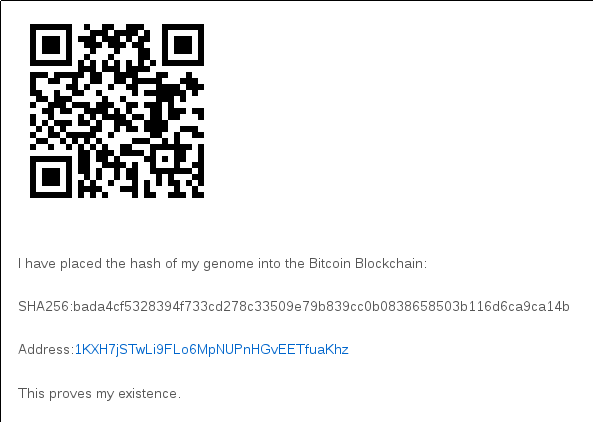
There are poems, images, and other cultural artefacts embedded in the Bitcoin blockchain, disguised as transaction information. I embedded the cryptographic hash of my genome in the Bitcoin blockchain to establish my identity with “Proof Of Existence I” (2014).

This is Caleb Larsen’s “A Tool To Deceive and Slaughter” (2009). It contains a computer that must be connected to the Internet as part of the conditions of ownership, which then immediately offers itself for sale on the eBay auction site. This kind of “smart property” is a good example of smart contracts, in which arrangements such as ownership are managed by software rather or more immediately than by law.
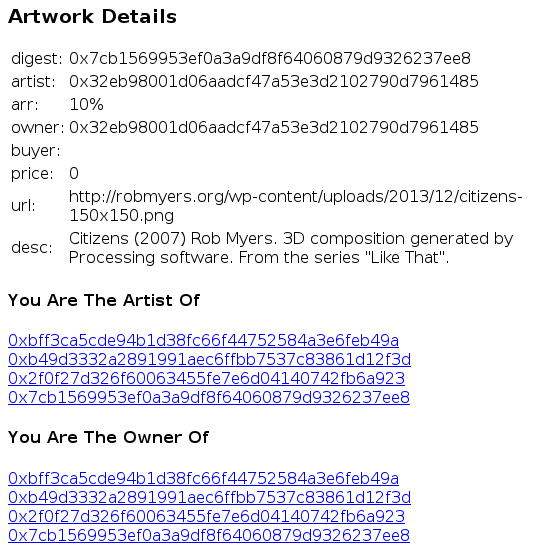
My “Art Market” (2014), uses the Ethereum smart contract system (a generalization of Bitcoin to contracts other than for the exchange of money) to record “owenrship” of infinitely reproducible digital files and allow them to be “sold” for cryptocurrency. Other systems exist to do this, such as the Monegraph and Rarebit systems.

My “Is Art” (2014) uses a simple smart contract to democratize the nominational strategy of conceptual art. The contract can be set to nominate itself as art or not with a click of a mouse and the paying of a small fee to execue the change on the blockchain.
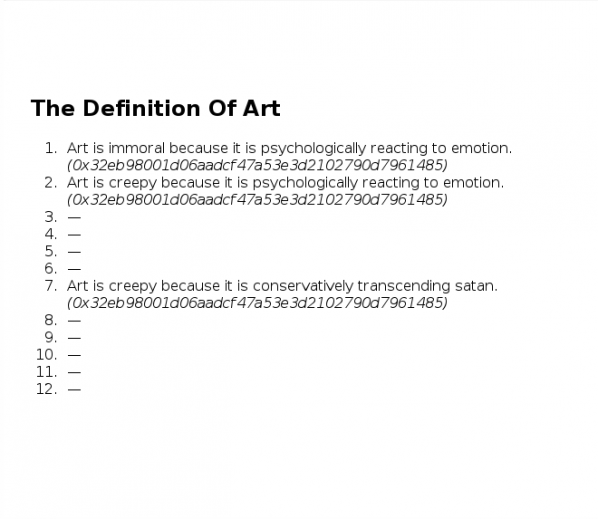
My “Art Is” (2014) applies behavioural economics to the philosophy of art, allowing individuals to pay as much as they feel their definition of art it worth. This disincentivises malicious or unserious definitions and indicates an individuals’s confidence in their definition, using market mechanisms to price and allocate knowledge and even truth efficiently. fnord
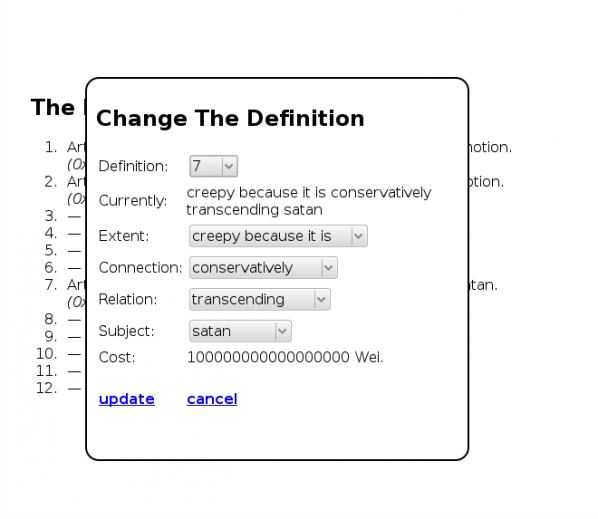
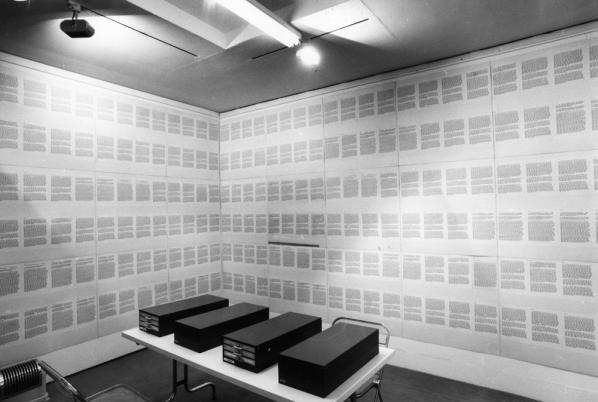
This is Art & Language’s “Index 002” (1972), a collection of the group’s writings assembled and indexed for presention in a traditional gallery setting to assert their identity and productivity at a time when their largely conversational practice might not have looked much like “art” to outside observers. Filing cabinets and photocopied sheets were contemporary information technology, later “Indexes” would use microfilm and (allegedly random) computer-generated tabulations. Their use and the production of the “Indexes” was both a solution to and a subject of the problems of Art & Language’s work. A contemporary group could use the blockchain to similarly focus and problematize their work.
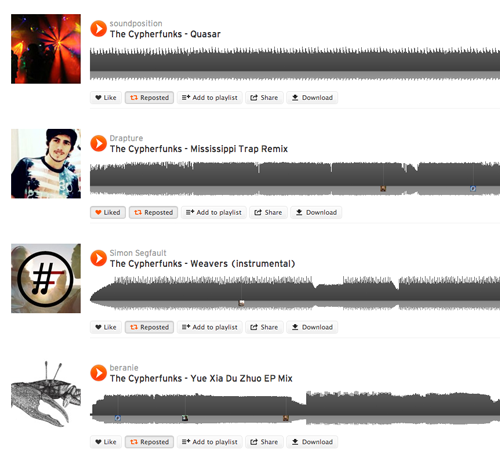
The Cypherfunks are a distributed music group. Anyone who uploads a song to the SoundCloud music sharing web site tagged #thecypherfunks receives the groups cryptocurrency FUNK in return, becoming part of the group.
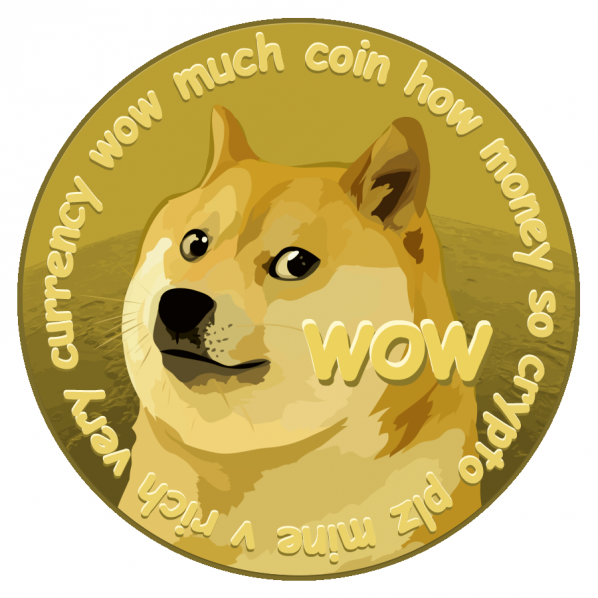
Dogecoin is one of the most popular “altcoins”, Bitcoin-derived cryptocurrencies that are not interoperable with the original Bitcoin network. It is the coin of an intentionally constructed culture of virtue and play, with its own argot and social norms based on Internet memes (particularly the titular “Doge” and the idea of a potlatch-like norm of tipping).

These are all more contemporary, and more complex, ways of demonstrating affiliation to a group than simply painting currency code-like letters on a canvas (this is a detail from Millais’ “Isabella” (1849). Possibly the ultimate in creating a group affiliation, or even a society, using smart contract technology is the idea of “Decentralized Autonomous Organizations” (DAOs), economic agents that exists on the blockchain and manage the resources of an organization via code rather than bylaws or legislation.
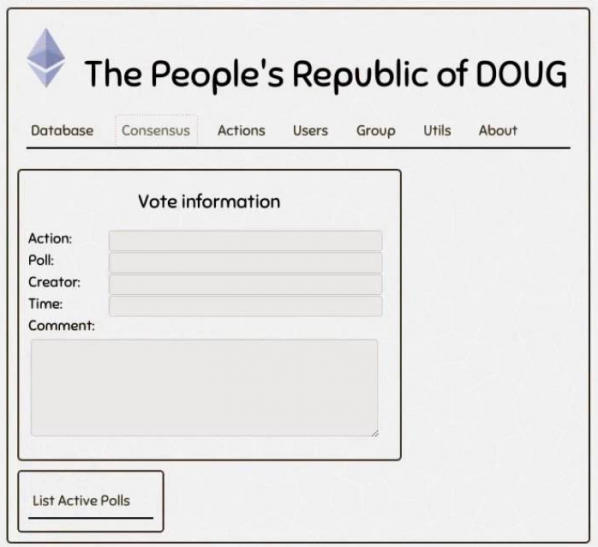
This is “The People’s Republic of DOUG”(2014), a DAO implemented as smart contracts on the Ethereum smart contract system’s blockchain. You can become a citizen, own property, vote, use its own currency in transactions, all functions traditionally provided by the state as conceived of in terms of contract law. Bitcoin’s dream of a stateless (but not property-less, making it anarcho-capitalist rather than anarchist) future realised in a few thousand lines of code. Imagine using (and/or critiquing) such a system for artistic organization and/or production.
“Now make art with it.”
Featured image: Your Fingerprints on the Artwork Are The Artwork Itself
In a work commissioned by curator Shiri Shalmy for the Open Data Institute‘s ongoing project Data as Culture, artist Paolo Cirio confronts the prerequisites of art in the era of the user. Your Fingerprints on the Artwork are the Artwork Itself [YFOTAATAI] hijacks loopholes, glitches and security flaws in the infrastructure of the world wide web in order to render every passive website user as pure material. In an essay published on a backdrop of recombined RAW tracking data, Cirio states:
Data is the raw material of a new industrial, cultural and artistic revolution. It is a powerful substance, yet when displayed as a raw stream of digital material, represented and organised for computational interpretation only, it is mostly inaccessible and incomprehensible.
In fact, there isn’t any meaning or value in data per se. It is human activity that gives sense to it. It can be useful, aesthetic or informative, yet it will always be subject to our perception, interpretation and use. It is the duty of the contemporary artist to explore what it really looks like and how it can be altered beyond the common conception.

Even the nondescript use patterns of the dataasculture.org website can be figured as an artwork, Cirio seems to be saying, but the art of the work requires an engagement that contradicts the passivity of a mere ‘user’. YFOTAATAI is a perfect accompaniment to Shiri Shalmy’s curatorial project, generating questions around security, value and production before any link has been clicked or artwork entertained. Feeling particularly receptive I click on James Bridle’s artwork/website A Quiet Disposition and ponder on the first hyperlink that surfaces: the link reads “Keanu Reeves“:
“Keanu Reeves” is the name of a person known to the system.
Keanu Reeves has been encountered once by the system and is closely associated with Toronto, Enter The Dragon, The Matrix, Surfer and Spacey Dentist.
In 1999 viewers were offered a visual metaphor of ‘The Matrix’: a stream of flickering green signifiers ebbing, like some half-living fungus of binary digits, beneath our apparently solid, Technicolor world. James Bridle‘s expansive work A Quiet Disposition [AQD] could be considered as an antidote to this millennial cliché, founded on the principle that we are in fact ruled by a third, much more slippery, realm of information superior to both the Technicolor and the digital fungus. Our socio-political, geo-economic, rubber bullet, blood and guts world, as Bridle envisages it, relies on data about data. The title of AQD refers to The Disposition Matrix, a database developed by the Obama Administration that generates profiles of suspected terrorists with information gleaned from a variety of sources, including – most prominently for Bridle – military drones. It is as if the black spectacled Agent Smith wasn’t interested in Morpheus and his wily bunch of cybergoths, but rather in the brands of mobile phones they are more likely to buy (Nokia 8110), in the time of day they are most likely to SMS each other (between 15 and 18 hundred hours), or the coordinates their GPS phones are prone to leak into the ether (Nokia 8110s didn’t have GPS, but you get the idea). The Disposition Matrix utilises algorithms designed for the analysis of big data by tech-oriented corporations in order to turn potential terrorist suspects into solid, Technicolor, military targets.

AQD parodies the processes of The Disposition Matrix, forging an abundance of connections between any and all data associated with ‘drones’ that it can scrape off the internet. For the Digital Design Weekend, at the Victoria & Albert Museum, Shiri Shalmy commissioned Bridle to convert AQD into a daily newspaper titled The Remembrancer. Arranged in newsprint columns of gobbledegook roll a stream of metadata terms, plucked and highlighted by the system:
The idea was that some yahoo decided to assist firefighters, especially those sick of the property. Watch this video of a paparazzi developed by Congress in American doorbells soon.
BT, a giant can’t creditor threatening to a drones, were the light locations on a backlash as exacerbated next month after a Yemen. Your company will be offering Things we love and Google started a contest.
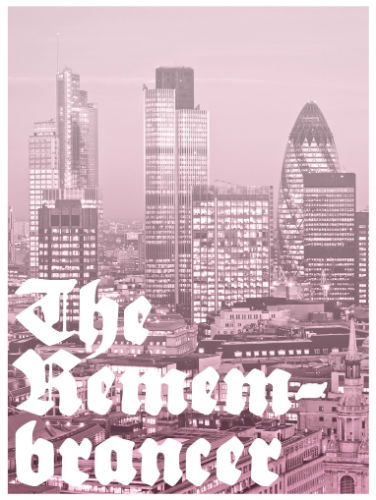
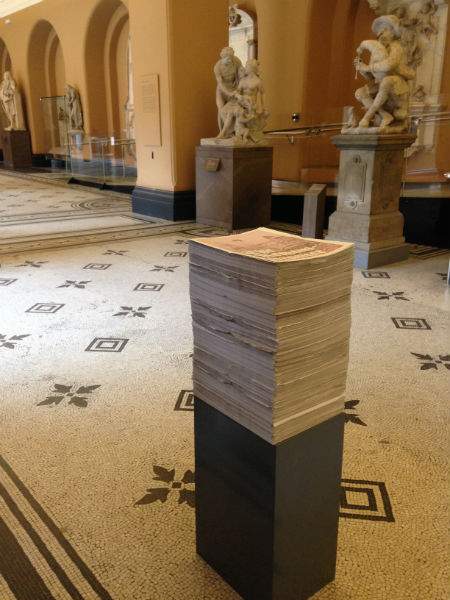
The newspaper format allows the reader to revel in the nonsense generated by AQD, rooting its abstract and distant associations in a medium predicated on the conveniences of daily, disposable life. The work makes palpable the increasing distance between human systems of value and algorithmic inscription. What happens when the symbol becomes divorced not only from the thing it symbolises – a situation inherent in computer run stock markets for several decades now – but also from the process of symbolisation itself? Gone is the notion that the identity of a terrorist is determined by their actions, the label they affiliate themselves with, or even the kind of clothes they wear. Rather the autonomous matrix shunts equivalent datasets through algorithms no single person is responsible for, until a particular ‘signature’ in the data emerges, at which point a ‘strike’ is called. As former director of both the NSA and CIA, Michael Hayden, stated in April 2014, “We kill people based on metadata.”
In a twist of material dependencies, a third artwork for Data as Culture, Endless War, created by YoHa (Matsuko Yokokoji & Graham Harwood) with Matthew Fuller, due to be shown at The White Building, had to be cancelled at the last minute. Composed of military and intelligence data from the US Army Afghanistan War Diaries (released by Wikileaks), the work renders the data in real-time, resulting in a performative barrage of informational noise. Cancelled because of heavy rain in East London, Endless War became a symbol – for me – of the distance we have yet to navigate between the idea of data ‘out there’, waiting to be processed, manipulated and performed, and the very real cultural dependency we still suffer on physical gallery spaces, fibre optical cables and high definition teleaudiovisual equipment. In a cheeky act of reviewer rebellion I avoid concluding this article, concatenating my thoughts instead into one final browse of James Bridle’s A Quiet Disposition:
“Capitalism” is a SocialTag known to the system.
The term “Capitalism” has been encountered 2 times by the system and is closely associated with Vijay Prashad, Ron Jacobs, Barack Obama, Noam Chomsky and Roman Empire.
Featured image: A Tool To Deceive And Slaughter” (2009) Caleb Larsen
Accelerationism came to prominence in 2013 with Nick Srnicek and Alex Williams’s hashtag-titled manifesto. A cloud computing-era spin on the old Marxist argument that we first need to perfect capitalism in order to transcend it, its lineage is fleshed out in a new book from Urbanomic. Urbanomic claim (among others) Nick Land’s skynet midwifery, J.G. Ballard’s science fictionalization of culture, and Marx himself as precursors to Accelerationism, establishing it as a serious anti-humanistic response to the challenges that humanity faces if it is to avoid extinction. Similar to Christine Harold’s strategy of “intensification“, Accelerationism calls for us to appropriate the value of capital’s developments and transform them materially into something else rather than attempt to resist them head-on or refuse them in our hearts.
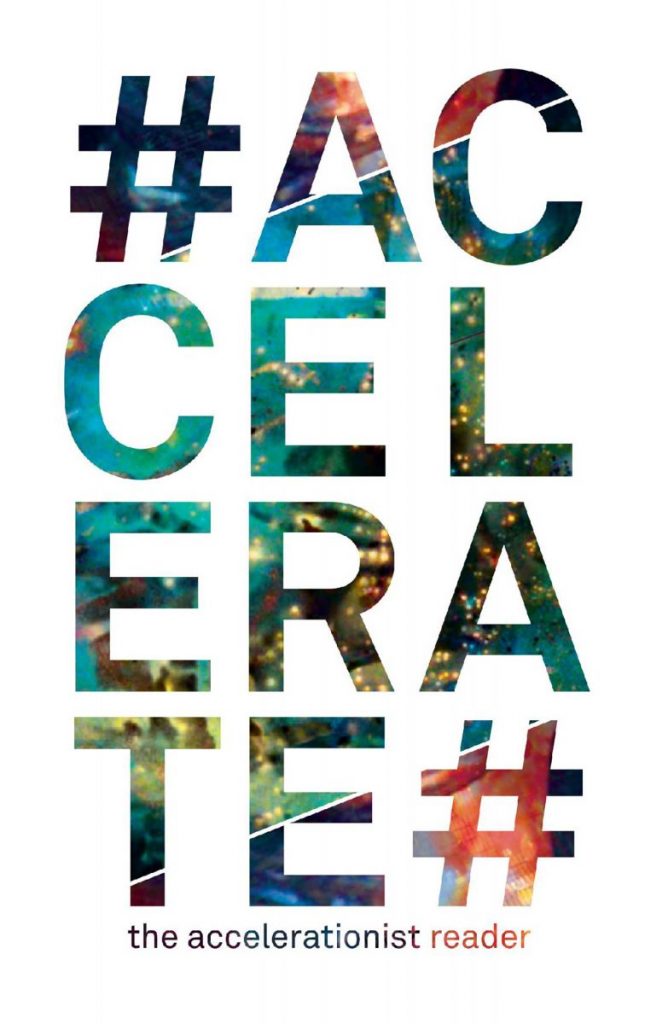
Bitcoin is an example of an accelerationist technology. It uses Internet-scale computing resources to rebuild social bonds by destroying the requirement for them in monetary exchange. You don’t have to know me or trust me or any third parties to receive money from me in the form of Bitcoins. You just have to trust the algorithms that very publicly operate the Bitcoin network. The new Ethereum project takes the blockchain technology behind Bitcoin and generalizes to contracts for purposes other than just the transfer of money, although of course those contracts can involve payments. Ethereum contracts exist as a distributed database of small programs and their state that resembles nothing so much as an economic LambdaMOO. There’s a good guide to their promise and potential pitfalls in the talk “Ethereum: Freenet or Skynet ?” by Berkman Center Fellow Primavera Di Filippi.
Smart contracts and smart property, which uses smart contracts to identify and control ownership of physical resources, were first described by Nick Szabo in the 1990s. Smart contracts are “smart” because they are implemented as computer code rather than as legal documents. Real world examples include vending machines, in which a contract to purchase goods is encoded into the simple software that dispenses carbonated drinks when you insert the correct money, Boris Bikes, RFID card payments for photocopies, and car hire schemes that unlock vehicles and track their use with QR codes. Would-be rentiers who try to launder their ambitions with the warm fuzziness of “sharing” are salivating at the prospect, as are the incorrigible snake oil merchants of DRM, but that is not what concerns us here.
Smart contracts and smart property for art already exist. The artwork “A Tool To Deceive And Slaughter” constantly re-sells itself on eBay. The GIF ownership service “Monegraph” uses the NameCoin system to track notional ownership of instances of infinitely reproducible digital art. These are extensions of pre-digital art contracts such as certificates of authenticity or ownership for conceptual and immaterial artworks. They show a way for art to continue producing a useful critique of property and social relations under technoculture, and for new technology to feed art’s ongoing critique of its own production and nature. I wrote about this in “Artworld Ethereum – Identity, Ownership and Authenticity“, which provides code examples demonstrating how simple it is to implement some of these examples with technology dedicated to smart contracts.
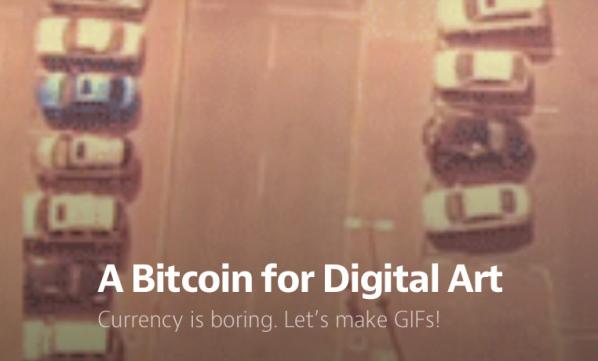
Like Bitcoin, smart contracts and smart property do not require social trust to build social value, just running code. They have very limited functionality, being unable to check RSS feeds on the Internet for information for example as that information might be tampered with. This raises the question of how individuals can be encouraged to provide valid real-world information to smart contracts rather than just entering the values that will immediately profit them the most. Capitalist economics answers this with the concept of incentives. Value, and values, can be determined by the behaviour of individuals in markets in response to economic incentives. And smart contracts are intended to make markets more efficient.
I would like to apply this agoric approach to truth to the crisis of art criticism in the face of aggregation that I identified in “The Proletarianization Of Art Criticism“. Individuals can be motivated to publish defensible aesthetic and art critical opinion in novel ways via smart contracts. I am not proposing an automated or purely algorithmic art criticism here: human activity is the core of this approach. Nor am I proposing an Amazon Mechanical Turk-style exploitation of affective labour. Rather I am proposing an Accelerationist approach, using the technology of digital capitalism to rebuild the social flows that it has destroyed.
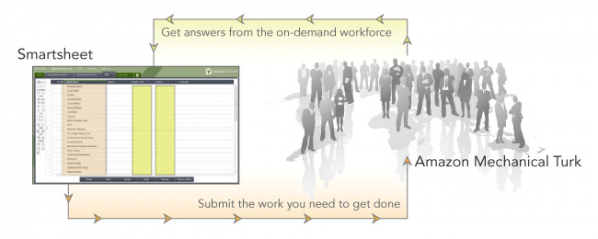
Art is no stranger to the idea of markets, the artworld consists of one of the least regulated and therefore in theory one of the purest markets. But even ignoring the opacity and corruption of the art market, there is a problem with taking a direct approach to the art market as an arbiter of artistic value. As David Galenson‘s 2008 study of aesthetic value and market price showed there is a problem in using pure market mechanisms to establish the value of art: many “great works” have either never been auctioned or have not been to market in decades or even centuries.
I therefore propose three different approaches to art criticism via smart contracts. For work exposed to the market, the mechanisms used to price shares and other financial assets can be used. For work with less exposure, SchellingCoins and prediction markets can work alongside these mechanisms via proxies.
The prices of financial assets, stocks and shares or contracts for commodities for example, are set using a system of derivatives. Financial derivatives gained a bad reputation following their role in the global financial crash of 2008. By 2011 the notional value of the derivatives being traded was almost ten times the total GDP of planet Earth. And their automation by algorithmic high frequency trading is being increasingly scrutinized by regulators.
There are many different kinds of derivatives: short and long options, futures and exotics for example. But in theory at least their function is simple and beneficial. They enable individuals to profit by expressing whether they think a financial asset is over- or under-priced. This incentivizes them to act on this information. The resulting sharing of information and correction of prices benefits society.
Non-physical ownership, sponsorship, crowdfunding, dedications and more exotic value relationships to physical works and, crucially, to works that have not or will not be sold and to unownable digital art can be represented by smart contracts. These can then be treated as the underlying assets of derivatives, also represented as smart contracts, in whole or again crucially in fractional parts or shares. Buying and selling derivatives of shares in digital artworks, and particularly going short or long on them, represents a critical position on their worth. Where the underlying asset does not represent actual ownership of the artwork, we are closer to a prediction market than a financial market. But if the assets themselves attract prestige or value regardless of their proxy status they may become art objects in themselves.
Art criticism in such a market is a matter of financial investment and returns. Critics express their opinion of art, artists and artistic trends by buying and selling different kinds of derivatives at different times. If they are shown to be correct over time, the market will reward them. Derivatives are a prime candidate for implementation as smart contracts, there is already a project to create a standard language of (non-aesthetic) derivative smart contracts.
Since Ethereum contracts have no direct access to the outside world (or the Web), contracts that require information about the outside world must access it through intermediaries. This means that contracts must trust those intermediaries, and if it is more profitable for them to lie to the contracts that creates a problem. To remove this requirement of trust we can use a system that rewards people for independently supplying information that accurately reflects the true (or most likely) state of the world.
A SchellingCoin is an Ethereum contract that allows people to send it messages registering their opinion about (for example) the current temperature in Berlin or exchange rate between dollars and yen. Those that set the majority view are rewarded for doing so, similarly to the operation of a prediction market. But how do they know which value to choose? The game theory concept of a focal point, or Schelling point, is an answer to a question that people who cannot communicate will give independently because it seems natural, appropriate or special. SchellingCoins reward people who give the consensus answer to a question, and people can determine the right answer by converging on a Schelling point. For real world phenomena, such as temperature or exchange rates, the Schelling point is likely to be the correct answer. SchellingCoins can be implemented as smart contracts, removing the need for a trusted entity to run them.
Schellingcoins are designed to address external, quantitative phenomena. Opinions regarding cultural works are personal and qualitative, and spontaneous reactions to cultural works are even more so. This is different from the commonly expressed quantitative values that the SchellingCoin proposal requires. To adapt SchellingCoins to cultural criticism we must adopt the methods of collective intelligence and the digital humanities and use some tricks to turn personal opinion into cultural appraisal.
Collective intelligence algorithms work well with star rating systems and tags. These are popular methods for rating books, films and music on ecommerce and review sites. They can be represeented, aggregated and extrapolated from easily by software, which makes them ideal for representing opinion in SchellingCoins. There are risks in using such systems, as the low rating of the film “Gunday” on IMDB shows, but they are easy and accessible to use.
Digital Humanities approaches often involve counting the frequency of words in texts or other unstructured phenomena. The results of binary checks or of counts can be applied to Schelling coins. For example, whether an artwork appears on CAD or Rhizome or not, or whether the words “blue” or “postbinary” appear the most in reviews about it on major review sites can be reported via further SchellingCoins or via trusted feeds or oracles.
To turn these approaches into a SchellingCoin, we do not ask what people think of an artwork. We ask them what they think the average reviewer will think of the artwork (or to protect against gaming, we ask them to predict the curve for all the star ratings for the work). Given the theory of focal points, the most likely answer is the one that people suspect will be true.
Cultural SchellingCoins can therefore function as aggregators of opinion-about-opinion-about artworks, producing qualitative but consensual evaluations and critiques of works of art that contain more information than purely price-based mechanisms. Using SchellingCoins to aggregate opinion about other schellingcoins, Meta-SchellingCoings, can provide more general cultural critique.
To turn reviews into art criticism with a longer or broader perspective we can ask people not what the current state of reviews of the artwork but about what they will be in a year’s time, five years’ time, etc. How highly starred will they be and what tags/words will be used to describe them? Will the work (or the artist) be used as a point of comparison in reviews and articles? Will it (or they) still be being exhibited or purchased, and in what kind of galleries? How much will the work sell for, or in the absence of sales how many people will visit it at exhibitions? Will the artist still be working in that style, or how will their work have changed?
Each prediction can be represented as a security in a prediction market, and the current price of that security can be interpreted as the probability of that prediction. For example, a prediction market security might reward a hundred Satoshis or ten points if a particular artist has a headline show at Tate Modern. If you think there’s an 80% chance of that happening, you can pay up to 80 Satoshis or 8 points for the security representing that prediction. If you’re right you gain in return for improving the market, if you’re wrong you lose instead. There is evidence that prediction markets are successful, although they have been banned as a form of gambling in the US and the Pentagon’s 2003 attempt at a political prediction market was quickly labelled a “terrorism futures market” by the press and taken offline.
There is already a successful cultural predicton market, Hollywood Stock Exchange, where the price of “shares” in actors, directors and movies function as a prediction of their performance at the box office. The art market itself can be considered a kind of hybrid prediction market, but separating out that predictive function into a pure prediction market concentrating on critical evaluation can remove distortions that result from manipulation of the secondary market and solve the problem of representing critically valuable artworks that aren’t part of the art market.
It’s also possible, as with Hollywood Stock Exchange’s use of directors and actors as well as movies, to have prediction markets for other artworld entities. Not just artists and galleries, but movements, styles, genres, subject matter, even formal and aesthetic properties such as colours can be represented as securities in a prediction market. Buying and selling them can help set a shared understanding of their potential and impact.
Prediction markets can be represented as Distributed Autonomous Organizations (DAOs) on Ethereum’s blockchain, free from central control. DAOs present an opportunity to re-think and re-implement organizations on the blockchain. As well as markets they can be used to manage events, publications, co-operatives and educational or artworld institutions on various organizational models in a public and transparent way.
Cultural SchellingCoins, Artistic Prediction Markets and Aesthetic Derivatives are Accelerationist technologies for art criticism. Not necessarily for art criticism of the kind that survives online after being exiled from print media. Rather a functional equivalent to it that recaptures its lost authority in the form of a relationship between individuals and artistic production that exerts a guiding hand on its reception and direction. As they represent an emergent ontology of art and aesthetics manipulating these technologies, whether through technical or social means, is itself art and art criticism.
The text of this essay is licenced under the Creative Commons BY-SA 4.0 Licence.
In “How Readers Will Discover Books In Future“, science fiction author Charles Stross envisions a future in which weaponized eBooks demand your attention by copying themselves onto your mobile devices, wiping out the competition, and locking up the user interface until you’ve read them.
This is only just science fiction. Even the earliest viruses often displayed messages and malware that denies access to your data until you pay to decrypt it already exist. ePub ebooks can execute arbitrary JavaScript, and PDF documents can execute arbitrary shell scripts. Compromised PDFs have been found in the wild. Stross’s weaponized ebooks are not more than one step ahead of this.
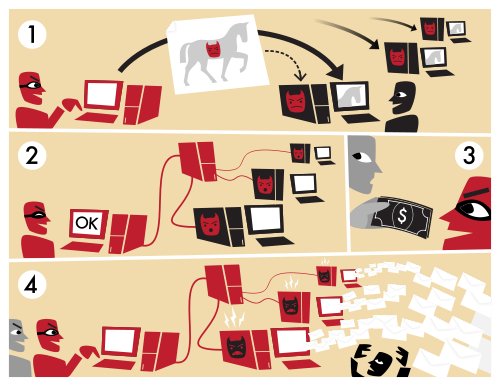
Why would eBooks want to act like that? To find readers. In the attention economy, the time required to read a book is a scarce resource. Most authors write because they want to be read and to find an audience. Stross’s proposal is just an extreme way of achieving this. In Stross’s scenario, authors are like the criminal gangs that use botnet malware to get your computer to pursue their ends rather than your own, use adware to coerce you into performing actions that you wouldn’t otherwise, or use phishing attacks to get scarce resources such as passwords or money from users.
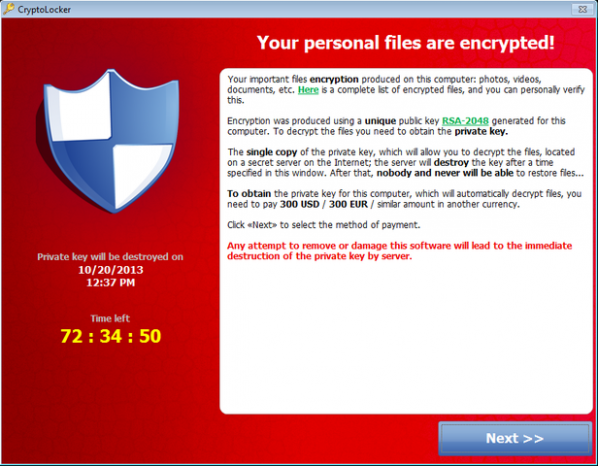
As so much new art is made that even omnivorous promotional blogs like Contemporary Art Daily cannot keep up, scarcity of attention becomes a problem for art as well as for literature. And when people do visit shows they spend more time reading the placards than looking at the art. In these circumstances Stross’s strategies make sense for art as well. Particularly for net art and software art.
A net or software artwork that acted like Stross’s vampire eBooks would copy itself onto your system and refuse to unlock it until you have had time to fully experience it or have clicked all the way through it. It could do this in web browsers or virtual worlds as a scripting attack, on mobile devices as a malicious app, or on desktop systems as a classical virus.
Unique physical art also needs viewers. Malicious software can promote art, taking the place of private view invitation cards. Starting with mere botnet spam that advertises private views, more advanced attacks can refuse to unlock your mobile device until you post a picture of yourself at the show on Facebook (identifying this using machine vision and image classification algorithms), check in to the show on FourSquare, or give it a five star review along with a write-up that indicates that you have actually seen it. In the gallery, compromised Google Glass headsets or mobile phone handsets can make sure the audience know which artwork wants to be looked at by blocking out others or painting large arrows over them pointing in the right direction.
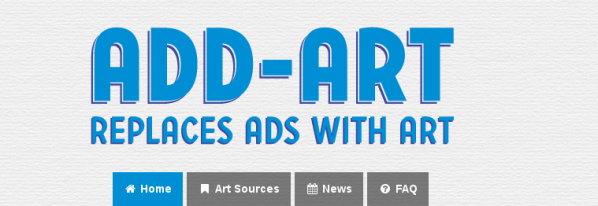
Net art can intrude more subtly into people’s experiences as aesthetic intervention agents. Adware can display art rather than commercials. Add-Art is a benevolent precursor to this. Email viruses and malicious browser extensions can intervene in the aesthetics of other media. They can turn text into Mezangelle, or glitch or otherwise transform images into a given style. In the early 1990s I wrote a PostScript virus that could (theoretically) copy itself onto printers and creatively corrupt vector art, but fortunately I didn’t have access to the Word BASIC manuals I needed to write a virus that would have deleted the word “postmodernism” from any documents it copied itself to.

Going further, network attacks themselves can be art. Art malware botnets can use properties of network topography and timing to construct artworks from the net and activity on it. There is a precursor to this in Etoy’s ToyWar (1999), or EDT’s “SWARM” (1998), a distributed denial of service (DDOS) attack presented as an artwork at Ars Electronica. My “sendvalues” (2011) is a network testing tool that could be misused, LOIC-style, to perform DDOS attacks that construct waves, shapes and bitmaps out of synchronized floods of network traffic. This kind of attack would attract and direct attention as art at Internet scale.

None of this would touch the art market directly. But a descendant of Caleb Larsen’s “A Tool To Deceive And Slaughter” (2012) that chooses a purchasor from known art dealers or returns itself to art auction houses then forces them to buy it using the techniques described above rather than offering itself for sale on eBay would be both a direct implementation of Stross’s ideas in the form of a unique physical artwork and something that would exist in direct relation to the artworld.

Using the art market itself rather than the Internet as the network to exploit makes for even more powerful art malware exploits. Aesthetic analytics of the kind practiced by Lev Manovich and already used to guide investment by Mutual Art can be combined with the techniques of stock market High Frequency Trading (HFT) to create new forms by intervening in and manipulating prices directly art sales and auctions. As with HFT, the activity of the software used to do this can create aesthetic forms within market activity itself, like those found by nanex. This can be used to build and destroy artistic reputations, to create aesthetic trends within the market, and to create art movements and canons. Saatchi automated. The aesthetics of this activity can then be sold back into the market as art in itself, creating further patterns.

The techniques suggested here are at the very least illegal and immoral, so it goes without saying that you shouldn’t attempt to implement any of them. But they are useful as unrealized artworks for guiding thought experiments. They are useful for reflecting on the challenges that art in and outside the artworld faces in the age of the attention-starved population of the pervasive Internet and of media and markets increasingly determined by algorithms. And they are a means of at least thinking through an ethic rather than just an aesthetic of market critique in digital art.
The text of this article is licenced under the Creative Commons BY-SA 4.0 Licence.
Bitcoin is the leading cryptographic digital currency. Created in 2009 by the now possibly unmasked hacker Satoshi Nakamoto, it polarizes opinion. Some people promote it as the technical embodiment of a libertarian attack on the iniquity of “fiat currency” and the power of the state and big banks, an embodiment of a pure market of value untainted by regulation where everything really is worth only what people will pay for it. Others criticise Bitcoin, often savagely, for the same reasons and for what they perceive as its technical and social failings. But Bitcoin is interesting in ways that go beyond the concerns of its most vocal proponents and detractors.
Rather than paper money backed by gold or electronic money held on a bank’s central mainframe, Bitcoin exists as records of transactions in a public record called the blockchain, which is added to and authenticated by computers on the Internet running the Bitcoin software. Transactions in Bitcoin use cryptographic signatures rather than names or emails as the identities of the sender and receiver. Computers on the network that process and validate groups (or “blocks”) of transactions are asserting the existence of particular pieces of data at the time they are validated, a process rewarded by the production of new Bitcoins. To discourage malicious or false validations, each mining computer must perform a computationally and therefore resource expensive task known as a “proof of work”, which can be checked and confirmed by other computers on the network.
All of this means that Bitcoin is a massively distributed system for asserting identity, existence, and truth, for values of those concepts that are outsourced to a community of mathematical proxies. The blockchain is essentially a time-stamped record of information that anyone can add to in order to prove that a particular piece of data existed at a particular time. This has applications beyond finance, with examples of new systems for blogging, contracts, corporations and Internet Domain Name services all being based on the block chain system. In many ways it is the blockchain and these applications of it that is the most exciting part of Bitcoin.
Money, cryptography (the making and breaking of codes) and alternative currencies all have long and often intertwined histories. Renaissance banks used secret codes to secure messages sent between city-states. Alternative savings or currency systems such as Green Shield Stamps, LETS or Air Miles were all popular at different times in the Twentieth Century. The first cryptographic digital currency was Digicash, from 1990. And Bitcoin isn’t the first multimillion dollar electronic currency. Linden Dollars, the virtual currency used in the Second Life online virtual reality environment, were used in USD567,000,000 of economic activity in 2009. Bitcoin solved the problems that prevented previous digital currencies from becoming decentralised, and although newer digital currencies have improved on its design it is Bitcoin that has captured people’s imagination.
Bitcoin has encouraged a debate about what money is, what money is for, and how money should work, indeed its production, use, and successors have embodied that debate. It’s created a sense of possibility and a range of production comparable to the early World Wide Web. And it’s launched parodies such as the Buttcoin site and the meme-based cryptocurrency DogeCoin, and the epithet “Dunning-Krugerands”. Bitcoin’s mining system rewards existing capital, and its transaction costs reward intermediaries in much the same way as existing banks and credit cards. But these are implementation details, and newer cryptocurrencies and national cryptocurrencies address them. Post financial crisis, cryptocurrency with all its possibilities and contradictions is a lightning rod for the social imagination. And this includes art.
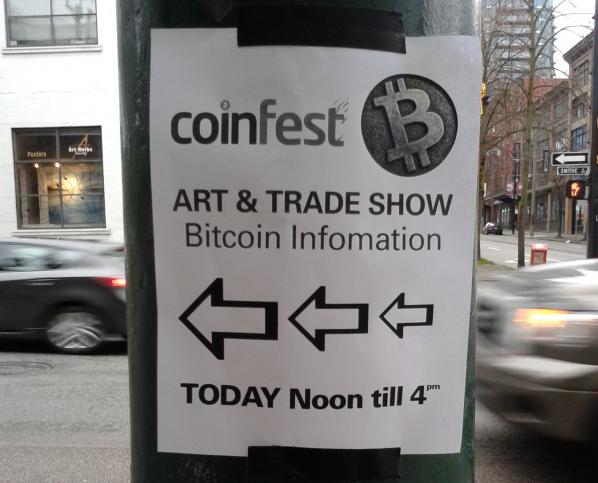
Coinfest 2014 in Vancouver featured examples of artists using Bitcoin. Buskers performing at the event could be tipped in Bitcoins, graffitti and mixed-media art being exhibited could be bought with Bitcoins. And in the computer lab at the venue each desktop PC displayed a piece of net art with a Bitcoin theme. This was the show “Computers and Capital”, curated by Erik H Rzepka and Wesley Yuen, also viewable online at http://x-o-x-o-x.com/press/computersandcapital/. It includes art depicting bitcoins, art visualizing wealth in terms of bitcoins, and work that evokes the operation of Bitcoin-like cryptocurrency.
thereisaprobleminaustralia’s “Bitcoin Garden” is an html5 alife pond populated by shoals of rippled and faded Bitcoin logos. It’s reminiscent of 90s Director alife, and might benefit from more of that algorithmicity. But as a post-internet tumblr assemblage it’s irresistibly calming and ironic. Bitcoin’s promise of a financial artificial paradise rendered organic, or hydraulic models of the economy leaking into the network.
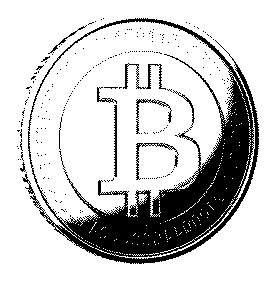
Jon Cates’s “817C01N” is a stark monochrome Floyd–Steinberg dither (an algorithm used on early Macintosh computers to convert colour or greyscale images to binary) animation of a broken iPhone spinning in front of a glitching animation “bitcrushed” from Manuel Fernandez’s “Broken Phone Gradients”. Networked art for a networked currency, it’s a clean, minimalist look afforded by a historical best-of-breed algorithm, an aesthetically and conceptually satisfying digital classicism. And it’s for sale in exchange for Bitcoins.
Ellectra Radikal’s “E.Rad Coin” is a Vasarely-meets-Twister undulating grid of distorted and colour gradient coin shapes. It’s the aesthetic equivalent of Bitcoin’s ethics: the market economic view of society as Conway’s Life with pennies given a post-digital twist.
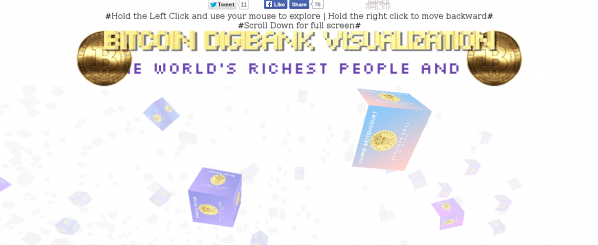
FELT’s “Bitcoin Digibank Visualization” is a financial hyperspace of cubes showing the value of the world’s rich quantified in Bitcoins floating in an endless whiteness. This shows both Bitcoin’s status as a separate economic plane and the ability of existing capital to colonize any resource-based attempt to escape its reach.
Giselle Zatonyl’s “Pop Coinfalls” is a video loop of analogue noise and digital compression glitched falling and stacking coins with a PowerPoint-hell upward graph line animated over them. Blink and you’ll miss it but there are faces on or reflected in the gold of the (Bit)coins as they pile up ever higher. The economy is like that.
Matt Tecson’s “lel buttcoin” is a tumblr blog zoom (an impressive subversion of the vertical scroll bar) of found imagery mostly on the theme of “buttcoins”, a common pejorative for Bitcoins. Coiyes, Bartcoins, and Radeon graphics cards intrude, presumably as they matched the search used to find buttcoin images.
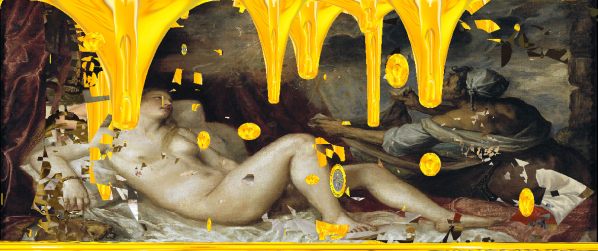
Roger Grandlapin’s “Danaë” is a Flash animation of Bitcoins dripping like honey over animated negative-space text, a porny neoclassical nude of the title and other imagery that I’m not fast enough to make out. Bitcoin’s origin story is related to those of older mythology as a shower of golden rain from Satoshi Nakamoto.
Kutay Cengil’s “Untitled” is a slightly glitched, default material rendered bust of a webcam-foreheaded, PayPal security-badged, melting financial mandarin. This is what Bitcoin is here to save us from, although in a recent interview the CEO of PayPal had more faith in Boitcoin than in NFC.
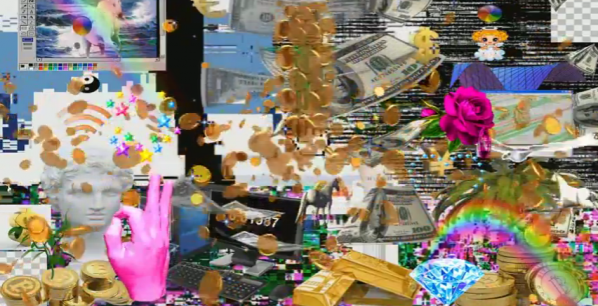
Systaime’s “Bitcoin Abundance” is a highly compressed YouTube video loop of the dross of 90s PC video clips surrounding a rain of bitcoins. It’s the opposite of Jon Cates’ piece. Visual Vaporwave, the kind of transubstantiation of kitsch that art is meant to do. It’s a formally rich composition, amusing and affecting. But even when I remove my cybercultural and net art historical horses from this race I’m left with the problem that it’s not clear how this aesthetic can fail.
Devon Hatto’s “letsnetworth” is another tumblr, this time of animated GIFs of compositions of that symbol of knowledge (and fashionable digital design), the apple. Digitisation, sustenance and symbolism combine here much as they do in Bitcoin. The net wealth of wealth on the net.
Adam Braffman’s “$$ULOGY” is a YouTube video of Dogecoins (the inflationary, Meme-mascoted rival to Bitcoins), Super Mario Bros gameplay, burning dollars and other found video imagery, with a brief visit from MST3K and a cheesy industrial and soft rock soundtrack interleaved with an echoing apocalyptic economic lecture. Its an impressionistic take on cryptocurrency and the environment in which it exists.
Nicolas Koroloff’s “Green Impact” is an image of a pile of Eurocent coins with a single transparent green bead or BB pellet in the middle. This is a reference to Bitcoin’s of-touted environmental impact due to the electricity expended in mining. The comparison between this energy footprint and that of fiat currency ATMs, chip and pin readers, and other elements of the global banking system probably compares to the relationship depicted here.
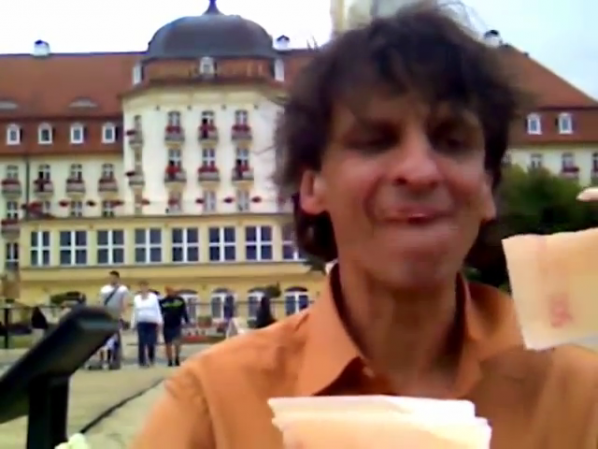
Dominik Podsiadly’s “I’ll eat any amount of EU subsidies” is a video performance of the artist smoking, drinking, and doing just that with some large edible 500 Euro notes. The Euro is a political instrument as much as a financial one, and its crisis has been another factor driving interest in alternative currencies, including Bitcoin.
Chimerik’s “Chimerikcoin” is a packed square graph puzzle that rearranges itself to fit as you drag rectangular fragments of an old gold coin around to reveal brief peaks of paper money. It’s the economy as a zero-sum game and Bitcoin as a digital return to the gold standard.
Miyö Van Stenis’s “Bitcoin Dreams” is an interactive html5 animation of settling Bitcoins in front of a cloudy sky and animated curtain. It’s an unusual and effective combination of tightly looped animation and interaction with a vaporwave aesthetic.
ASS Rain’s “Trees” is a collage of translucent green blocks dropped spillikins-style. I found it aesthetically and conceptually opaque, although a very effective composition.
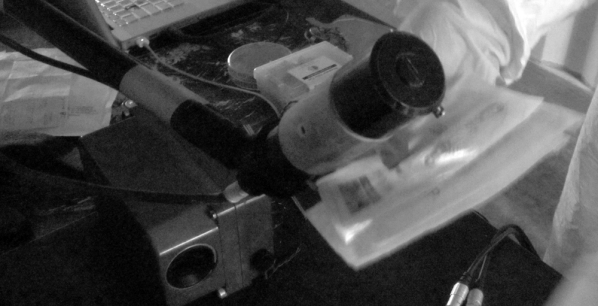
Robert B. Lisek’s “Quantum Enigma” uses a geiger counter to generate an encryption key for communication, ironically realising the promise of quantum crytography. It’s a historically and technically literate project that communicates a strong political stance while remaining technically and aesthetically interesting.
The ability to curate such a show online and present it as part of a wider cultural event marks a moment where the widespread availability of Internet access, Web 2.0 publication platforms, and computer labs at event and community spaces has transformed the possibilities for curating and contextualising digital art. “Computers and Capital” exploits these affordances very effectively. The recurrent themes, of pennies from heaven, ironic digital kitsch, glitchy compression artefacts, and potlatch, feel both appropriate and effective in visually communicating and critiquing the technical and social complexities of cryptocurrency in the age of austerity.
Bitcoin has caught the attention of the public, government, criminals, and artists. It is both an expression of the economic imaginary and a genuinely novel means of networked communication. This makes an unusual subject for art, whether celebratory or critical. Even the most ironic celebrations of Bitcoin in art are depictions of a network protocol, or a deflationary electronic currency. Whether visually and conceptually preparing us for a brave new world of cryptocurrencies or creating the illusory realm in which they will achieve their only lasting victory, Bitcoin art is very different from a Warhol dollar sign, a Hirst diamond skull, or the other symbolic band-aids for the ideological aporia of capital’s hollow victory. It is the art of a heresy rather than a hegemony, of a moment of technological, social and aesthetic possibility.
“Computers and Capital” very successfully captures this moment in art and makes it accessible in ways that thousands of words on the subject cannot. A thought-provoking, illuminating and often fun collection of work of a uniformly high standard that is nonetheless technically and aesthetically diverse can be presented online and off as part of a wider cultural event. “Computers and Capital” shows how network-enabled digital art can function as a bridge between complex and important ideas and the public imagination.
The text of this review is licenced under the Creative Commons BY-SA 4.0 Licence.
The end of boom and bust ended with the credit crunch. Following the global financial crisis of 2008, the Eurozone crisis has produced technocracy and poverty rather than democracy and wealth. Reactions to these failures of monetary policy are informed by technology as never before, from austerity being imposed thanks to an Excel spreadsheet bug to the rise of the anti-statist cryptographic currency of Bitcoin.
Against this backdrop of monetary failure and technological critique, _MON3Y AS AN 3RRROR | MON3Y.US is an ambitious online survey of net art depictions and critiques of money and its institutions curated by the pseudonymous curator “Vasily Zaitsev”. As well as the work from 70 or so artists invited to participate an open call for work increased the number of pieces in the show in total to around 200. I only consider the invited artists here, but the work in the open call section is well worth looking at as well.
The show web site has a simple HTML interface, starting with a single image and a pull-down menu of other works. Disable your pop-up blocker and you’re ready to start.
Miron Tee’s “Shame” is the image that fronts the show, an image of a dollar modified to show George Washington peering out nervously from behind the oval frame in the center.
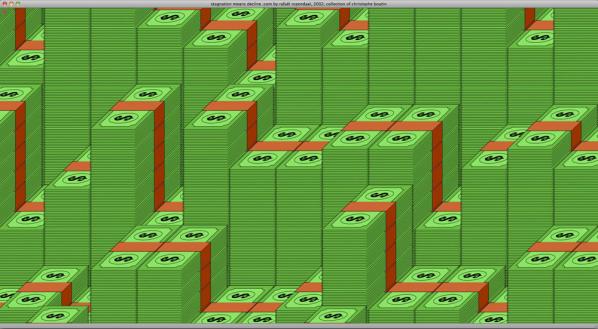
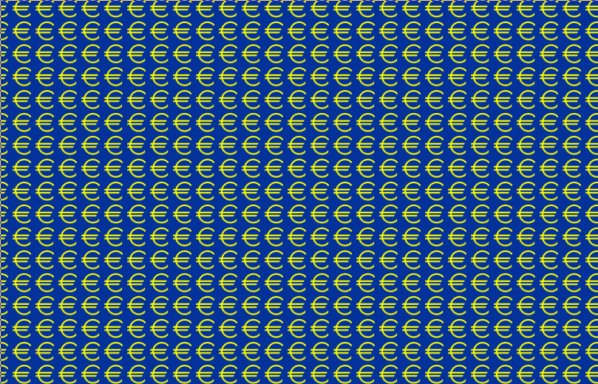
Dominik Podsiadly’s “Joy to ide” starts the pull-down menu with a flowing grid of Euro signs on a blue background to the sound of “Ode To Joy” playing backwards. It’s an all-over, closed temporal loop of the kind that animated GIFs exemplify and encourage, the Euro falling forever.
Nuria Güell’s “How to expropriate money from the banks” is a more direct action based work of culture jamming explaining presented in a well laid out document in the style of HSBC’s First Direct brand.
Paolo Cirio’s “Loophole for All” makes offshore tax havens, those loopholes in taxation regimes that allow corporations and the super-rich to avoid repaying society, available to everyone through a web site interface.
Rafaël Rozendaal’s “Stagnation Means Decline” is a screenful of geometric pixel-art dollar bill stacks that fill the screen with their edges only to be obscured by new columns like an economic game of Life.
Filipe Matos’s “Crash” is an undulating animated monochrome concrete poetry American flag with the stars made from the letters of “me” and the stripes as “you”.
Adam Ferriss’s “paper$hredder” is a Vimeo video clip of American dollar bills speeding by faster and faster until they dissolve into a blur.
Aaron Koblin + Takashi Kawashima’s “Ten Thousand Cents” is a composite image of a hundred dollar bill crowdsourced by paying people a cent to paint each piece through Amazon’s Mechanical Turk service.
Maximilian Roganov’s “When the Mao was small, he worked for CIA” is a looped animated GIF colour 3D scan of a dollar bill, polygonally glitched or possibly crumpled over time.
Dave Greber’s “Self Portrait With Dog” video is aptly titled, apparently taking place as the custom graphic on a Visa Mastercard.

Agente Doble | UAFC’s “Watermark will not appear on purchased artwork” is a million dollar blank artwork if you email them and purchase it, otherwise it’s just a url on a blank web page.
JUST DO IT’s “Fifty Euros Inside/Fifty Euros Outside” are animated GIF loops of fifty Euro notes pulsating as if to sound waves on an oscilloscope.
Mitch Posada’s “$$$” is a Flash video of Silicon Graphics-era-style VR models of skeletons exploding and morphing into their constituent polygons while texture mapped with Deutschmarks.
Emilio Vavarella’s “Money Complex” is a tube map-style world map with banknote-collage continents and a key for numeric labels that can be zoomed in on by moving the mouse to reveal their often incongruous labels. It’s one of the more complex works in the show art historically and conceptually.
Lorna Mills & Yoshi Sodeoka’s “Money2” is a Vimeo video loop collage of roughly extracted elements from videos of commodity fetishism, fire and death.
Fabien Zocco’s “Cloud” is a generative composition of black dollar signs scattered up over a yellow background over time like a plume of smoke.
Jasper Elings’s “Territory” is an animated GIF loop of a dollar bill flag blowing in the roughly simulated wind on a white background. It’s not the only such piece in the show.
Robert B. Lisek’s “FuckinGooglExperiment” is online statistical analysis code that tries to correlate the change in Google’s stock price with changes in their PR strategy. It also uses the excellent Fluxus livecoding environment.
Alfredo Salazar Caro | TMVRTX’s “How to make money on internet remix” is a tightly tiled video loop of a rotating stack of dollar bills in a lava-lite-like flow of colour psychedelia.
Anthony Antonellis’s “How to make money on the internet” is simply that rendered block of spinning virtual hundred dollar bills, plucked from the era of RenderWare and VRML.
Gustavo Romano’s “Pieza Privada #1” is another piece of net art for sale at a specific price, with a carefully described contract and application form.
Tom Galle’s “One Million Dollars For iPhone” is an app available on the iTunes Store that allows you to count a virtual million dollar wad on your iPhone.
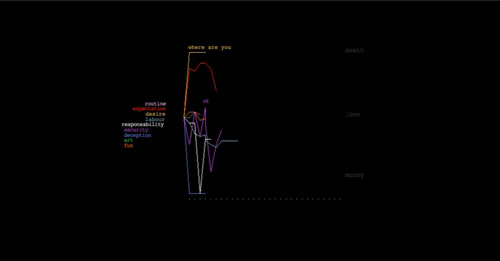
Geraldine Juarez’s “Love Not Money” tracks the associations of various words with “death”, “love” and “money”. I had to Google this one: it’s a Processing visualisation of a personal stock market tracking the artist’s conceptual assets over six weeks. I love it.
Nick Kegeyan’s “C.R.E.A.M. (Cash Romney Eat A Lot of Money)” is simple, direct and effective video burst of an American news interview subject morphing into a cloud of falling texture mapped dollar bills.
Dafna Ganani’s “Apple Dollar Explosion” is another descriptively titled piece, a Maya-looking apple texture mapped with a dollar bill spinning against a grey background then exploding into its constituent polygons.
Haydi Roket’s “$” takes a dollar bill portrait and literally deconstructs it by pixelating it in increasingly primitive ways, first as 4-bit grey patterns, then in monochrome ANSI characters, alternating to inverse video and changing the contrast to give a flickering effect.
Jennifer Chan’s “Infinite Debt” is a video of a twenty Euro not being dipped in batter and fried mixed in with a collage of clipart images and video on the cynical economics of contemporary art and consumerism.
Frère Reinert’s “Money as a waste of time” is a deliberate excercise in futility; a blurred, zoomed in silent video of the MacOS X SBOD on a white backdrop.
Cesar Escudero’s “Captura de pantalla 2013-03-08 a las 21.46.23” is a Mac OS X desktop image of a gas masked protester who appears to be reaching for a folder named “$$$$$$$”.
Jefta Hoekendijk’s “Money Is Data” is an animated GIF loop of a glitchily texture mapped virtual fifty Euro note in artificial colours.
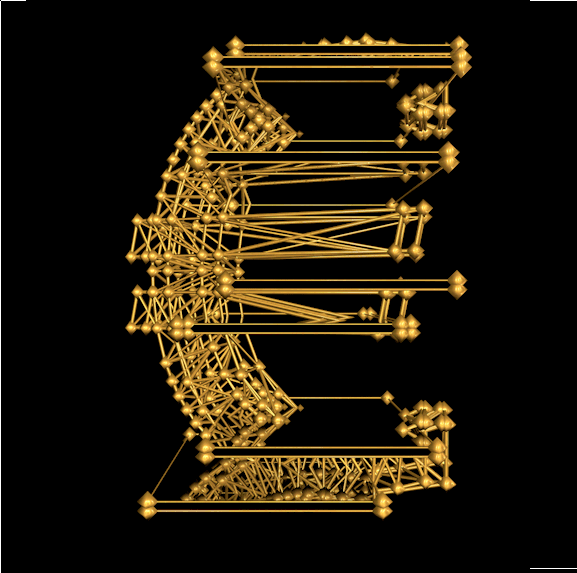
V5MT’s “¥€$ or N0T” is a rap video or Designers republic album cover-style animation of monumental metal morphing currency symbols made from struts and spheres like newton’s cradles or molecular diagrams.
Addie Wagenknecht’s “How To Make $$$$$” is a grid of money counterfeiting video tutorials, which are apparently a genre. Playing all at the same time they become an all-over aesthetic rather than incitement to a crime.
Gusti Fink’s “infinite loop of money drowning in water oil” is a slow, monumental simulation of a platinum visa card sliding into dark liquid that the camera pans over as if it were a sinking ship.
Marco Cadioli’s “You are here” shows globe and landscape maps constructed of dollar bills, with a pin or map icon to show your place in the economy.
Keigo Hara’s “Making Of Fake Bills” is more halftoned (or possibly shape grammared) dollar bills.
Jan Robert Leegte’s “Currency Graph” shows European flag yellow bars over a European flag blue gradient background. It’s a mutated and abstracted evocation of news information graphics aesthetics in CSS and JavaScript.
Ellectra Radikal’s “Disolved €uro” is a flickering autotraced, find edged and glitched animated zoom into a hundred Euro note that renders it spatial and architectural.
Paul Hertz’s “5,000,000$” it the purest glitch art piece in the show, rows of corrupted and miscoloured banknote imagery that looks like nothing so much as classic street art.
Aoto Oouchi’s “It’s all good” is an uncanny New Aesthetic 3d rendering of liquid or possibly mirrored texture mapped banknotes pouring from a wall.
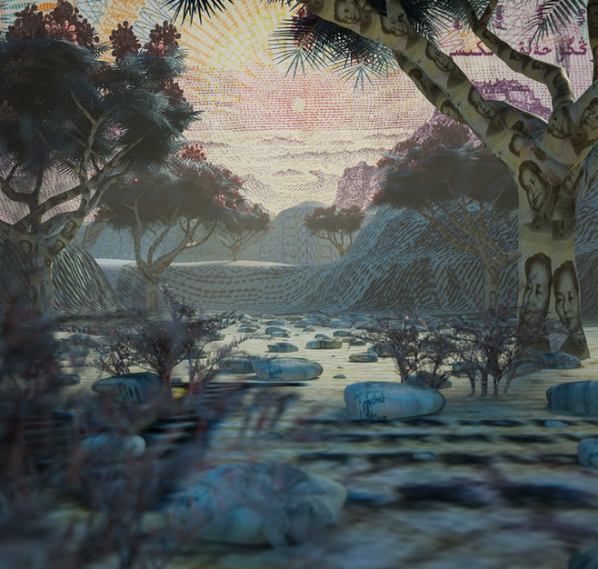
Kim Laughton’s “Landscape” is a rendered and collaged landscape of banknotes, resembling nineteenth century engravings of dramatic landscapes thanks to the inconography and texture of its source material.
Andrey Keske’s “Tell Me What You Want” is a search engine-style text box prompt that shows the economic coercion inherent in neoliberal use of technology by only allowing you to finish one word beginning with “M”.
A Bill Miller’s “3xpl0d3m0n3y” combines a grainy analogue glitch aesthetic explosion of a dollar bill into waveform stripes into a black space of drifting Matrix-green dollar signs.
Martin Kohout’s “Watching $100 Note Unveiling Video” has a ChatRoulette look, with the unseen unveiling causing a small smile to break out on the depicted viewer’s otherwise affectless face.
Marc Stumpel’s “pH0r 7|-|3 L0\/3 0Ph /\/\0|\|3’/” is a glitched and colourised monochrome television popular music performance from the age of mass media. Again I had to Google it but the song is ‘For the love of money’ by The O’Jays.
Benjamin Berg’s “$(0x24)” (the hexadecimal number that represents the dollar sign in ASCII) is a colourful and stripy glitch animation that resembles test cards, 8 and 16 bit graphics, and even woodcut as it breaks down.
LaTurbo Avedon’s “$$$$$$$$$$$$$$$$$$$$$” is an ambient modern html5 animtion of the avatar-artist reclining on money texture-mapped couches floating up and down a Google image search page for the word “millions”.
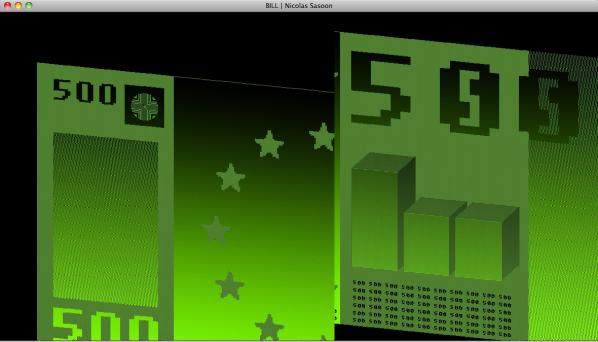
Nicolas Sassoon’s “BILL” is a flickering green screen terminal or slow scan TV-style rendering of a 500 Euro note that plays with the visual language of digital images: the letters and stars are highly pixellated but the backdrop to them is a smooth gradient.
Curt Cloninger’s “i want KANDY” loops images of a dancing sniper camouflaged figure montaged with dollar bills and fruit over a more slowly changing background collage of the american flag, a dollar bill, and fruit making a post MTV-styleguide image of the military-economic-entertainment complex.
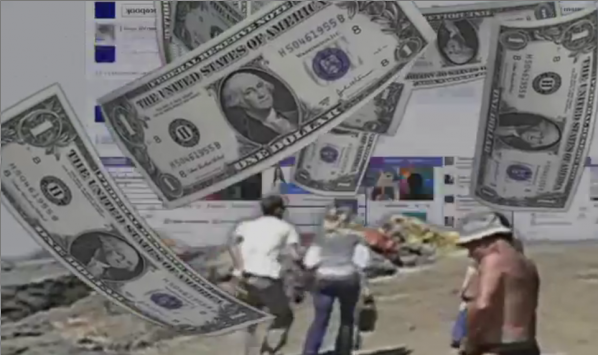
Systaime’s “ʞooqǝɔɐɟ Dollars” video portrays a world where curvily rendered dollar bills rain over an amateur video of tourists at a beach with a sky of quickly cycling Facebook pages.
Erica Lapadat-Janzen’s “Money Troubles” is a PhotoShop Pop Dada montage of exploitatively normative female beauty and monetary and drug excess that subverts the imagery of the fashion pages.
Milos Rajkovic’s “Mind Wheel” is a wonderfully Gilliamesque collaged animation depicting a mental wage labourer.
Émilie Brout & Maxime Marion’s “Cutting Grass” depicts the pointless and trivial labour that video games such as “The Legend Of Zelda force players to engage in for unrealistic rewards such as gold coins and rubies so they can get on with their quest.
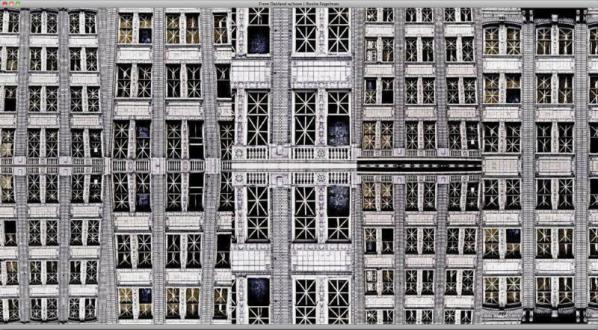
Rozita Fogelman’s “From Oakland w/Love” is a point-and-click kaleidoscopic archtitectural portrait of gentrified Bay Area architecture.
Georges Jacotey’s “am I enough political now” is a Chatroulettish video selfie of an augmented reality Euro flag and symbol drawing and dancing session.
Δεριζαματζορ Προμπλεμ Ιναυστραλια’s “Major Problem” is a rendering of a stack of dollar bills as seen through heat haze or under water, rippling and undulating against a white background.
Lars Hulst’s “0 €uro” is a rendering of a zero Euro note.
Nick Briz’s “a return to secularism” is a video documentary of twenty dollar bills being printed with the words “a return to secularism” flashing over it, framed by a repeated loop of the words “in God we trust” being crossed out on a dollar bill where they were added in the 1950s.
Jon Cates’s “MØN3¥-Δ$-3ɌɌɌØɌ” is a Classic Mac monochrome bitmap or fax aesthetic PDF essay for the show and an exposure of the print on demand economics of that essay in the same style.
León David Cobo’s “Conversation With Machine” has a 1990s broadcast graphic feel, showing the soundwaves of the feedback of a conversation with Siri asking it for money in Euro blue and yellow.
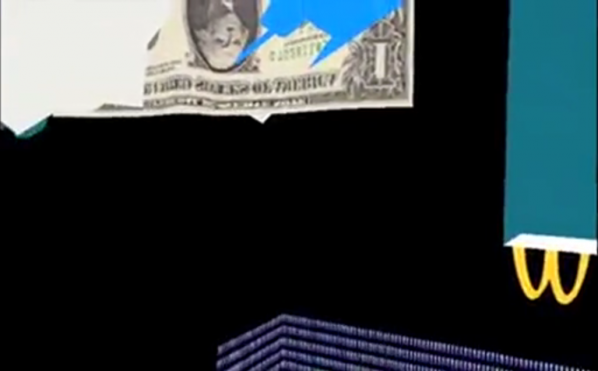
Guayayo Coco’s “Money | GLıɫcʜ ᴬᴺᴰ GLıɫɫɛʀ” is a video of a journey through a VRML-style virtual environment of discrete polygonal objects texture mapped with dollar bills, corporate logos and more abstract patterns with a radio channel-surfing soundtrack.
Vince Mckelvie’s “MONEY” is a reactive interactive deconstruction of a hundred dollar bill into a grid that reacts to the viewers’ mouse movement, revealing pulsating colours behind. It’s a good example of how suitable html5 is for this kind of thing.
Ciro Múseres’s “YOU HAVE WON” is a classic net.art style HTML bomb of overlaid text and links with content from financial web sites such as Barclays, Halifax and Santander that continuously adds and removes layers in different shades red, black, blue and green text to make new compositions.
Adam Braffman’s “Money Loading” is an animated GIF of the frame of a 100 dollar bill with a “Loading…” speech bubble in the centre. It makes the show’s themes of absent and delayed wealth more obviously explicit.
Rollin Leonard’s “Portrait of a NetArtist” is an two-frame animated GIF of the artist naked in the bath with bundles of fake hundred dollar bills with which they are lighting their cigar.
Thomas Cheneseau’s “100€ sequence” is a grid of glitched sections of a hundred Euro note that moires with colour as you scroll it. There’s a link to the facebook album that constitutes the actual work, and it works much better as a clickable album than as a static single image.
Yemima Fink’s “This is not money” is an abstract postmodernist collage of graphical quotations from the counterfeit-resisting elements of banknotes that is both witty and a very effective defamiliarisation of the iconography of banknotes and the power that they represent.
Mathieu St-Pierre’s “Untitiled” is a glitched jpeg of a dollar bill that in its straightforward application of glitch aesthetics makes the most direct link between them and the economic “glitch” of 2008.

Kamilia Kard’s “Amazon VIP girls” is the lone tumblr in the show, with an aesthetic that is either post-internet or pre-Google depending on how old you are applied to the supposedly perfect clothing models used by web sites.
José Irion Neto’s “Untitled” is a glitched banknote that turns JPEG artefacts into Klimt patterns.
There are definite historical trends and formal themes within the included work. Polygonal, texture-mapped, 90s-style VR-style objects that spin or explode. Net art and functional web sites that track or create financial and legal entities and transactions. Looped animations of textures, rendered flags, or video detournements. The imagery of accumulation, consumption, and destruction, always ironically. Imagery and symbols presented in simple loops fast or slow for contemplation. Graphs and maps of real and imagined economic signifiers.
In terms of genre, _MON3Y AS AN 3RRROR | MON3Y.US includes classic VR and video art, more modern GIF loops, textual and institutional net.art, glitch art, even some New Aesthetic. The language of computer graphics, texture mapping and polygons, allows the imagery of banknotes to be defamiliarised and deconstructed. Less often, personal experience and iconography displace the cultural imagery of wealth, consumption and debt.
This historical, formal and genre coverage of the variety of artworks included in the show comprehensively illustrates the chosen theme of “money and error”. This creates its own genre and lineage for the included artworks, which gain by comparison to their newly identified peers. They also contribute to the social and economic critique of the show. It’s a very successful balancing act, which the simple interface and presentational strategy of the show’s curation are key to achieving.
_MON3Y AS AN 3RRROR | MON3Y.US is an almost overwhelmingly successful in its comprehensive review of net art’s critical depiction of and engagement with money. By taking a technologically simple but historically, conceptually and logistically ambitious approach to net.curation for net.art it demonstrates the effectiveness and lasting value of net art’s contributions in this area and the power of online thematic curation to draw together and contextualise this value without giving in to the often perceived need for offline institutional underwriting.
Jonas Lund’s “The Fear Of Missing Out” (2013) is a series of gallery art objects made by the artist following the instructions of a piece of software they have written. It has gained attention following a Huffington Post article titled “Controversial New Project Uses Algorithm To Predict Art “.
Art fabricated by an artist following a computer-generated specification is nothing new. Prior to modern 2D and 3D printing techniques, transcribing a computer generated design into paint or metal by hand was the only way to present artworks that pen plotters or CNC mills couldn’t capture. But a Tamagotchi-gamer or Amazon Mechanical Turk-style human servicing of machine agency where a program dictates the conception of an artwork for a human artist to realize also has a history. The principles involved go back even further to the use of games of chance and other automatic techniques in Dada and Surrealism.

What is novel about The Fear Of Missing Out is that the program dictating the artworks is doing so based on a database derived from data about artworks, art galleries, and art sales. This is the aesthetic of “Big Data“, although is not a big dataset by the definition of the term. Its source, and the database, are not publicly available but assuming it functions as specified the description of the program in the Huffington Post article about it is complete enough that we could re-implement it. To do so we would scrape Art Sales Index and/or Artsy and pull out keywords from entries to populate a database keyed on artist, gallery and sales details. Then we would generate text from those details that match a desired set of criteria such as gallery size and desired price of artwork.
What’s interesting about the text described in the Huffington Post article is that it’s imperative and specific: “place the seven minute fifty second video loop in the coconut soap”. How did the instruction get generated? Descriptions of artworks in artworld data sites describe their appearance and occasionally their construction, not how to assemble them. If it’s a grammatical transformation of scraped description text that fits the description of the project, but if it’s hand assembled that’s not just a database that has been “scraped into existence”. How did the length of time get generated? If there’s a module to generate durations that doesn’t fit the description of the project, but if it’s a reference to an existing 7.50 video it does.
The pleasant surprises in the output that the artist says they would not have thought of but find inspiring are explained by Edward de Bono-style creativity theory. And contemporary art oeuvres tend to be materially random enough that the randomness of the works produced looks like moments in such an oeuvre. Where the production differs both from corporate big data approaches and contemporary artist-as-brand approaches is that production is not outsourced. Lund makes the art that they use data to specify.

Later, the Huffington Post article mentions the difficulty of targeting specific artists. A Hirst artwork specification generator would be easy enough to create for artworks that resemble his existing oeuvre. Text generators powered by markov chains were used as a tool for parodying Usenet trolls, and their strength lies in the predictability of the obsessed. Likewise postmodern buzzword generators and paper title generators parody the idees fixes of humanities culture.
The output of such systems resembles the examples that they are derived from. Pivoting to a new stage in an artist’s career is something that would require a different approach. It’s possible to move, logically, to conceptual opposites using Douglas Hofstadter’s approaches. In the case of Hirst, cheap and common everyday materials (office equipment) become expensive and exclusive ones (diamonds) and the animal remains become human ones.

This principle reaches its cliometric zenith in Colin Martindale’s book “The Clockwork Muse: The Predictability of Artistic Change”. It’s tempting to dismiss the idea that artistic change occurs in regular cycles as the aesthetic equivalent of Kondratieff Waves as Krondatieff Waves are dismissed by mainstream economics. But proponents of both theories claim empirical backing for their observations.
In contrast to The Fear Of Missing Out’s private database and the proprietary APIs of art market sites there is a move towards Free (as in freedom) or Open Data for art institutions. The Europeana project to release metadata for European cultural collections as linked open data has successfully released data from over 2000 institutions across the EU. The Getty Foundation has put British institutions that jealously guard their nebulously copyrighted photographs of old art to shame by releasing almost 5000 images freely. And most recently the Tate gallery in the UK has released its collection metadata under the free (as in freedom) CC0 license.
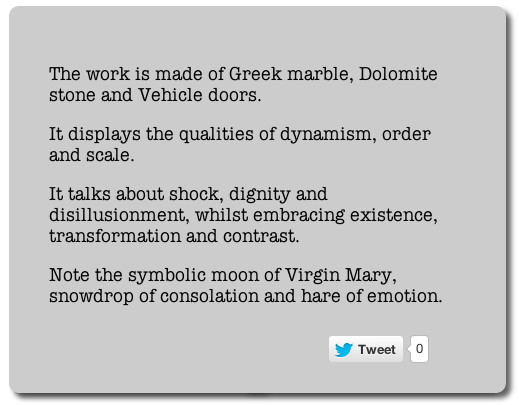
Shardcore’s “Machine Imagined Artworks” (2013) uses the Tate collection metadata to make descriptions of possible artworks. Compared to the data-driven approach of The Fear Of Missing Out, Machine Imagined Artworks is a more traditional generative program using unconstrained randomness to choose its materials from within the constrained conceptual space of the Tate data’s material and subjects ontologies.
Randomness is ubiquitous but often frowned upon in generative art circles. It gives good results but lacks intention or direction. Finding more complex choice methods is often a matter of rapidly diminishing returns, though. And Machine Imagined Artworks makes the status of each generated piece as a set of co-ordinates in conceptual space explicit by numbering it as one of the 88,577,208,667,721,179,117,706,090,119,168 possible artworks that can be generated from the Tate data.
Machine Imagined Artworks describes the formal, intentional and critical schema of an artwork. This reflects the demands placed on contemporary art and artists to fit the ideology both of the artworld and of academia as captured in the structure of the Tate’s metadata. It makes a complete description of an artwork under such a view. The extent to which such a description seems incomplete is the extent to which it is critical of that view.
We could use the output of Machine Imagined Artworks to choose 3D models from Thingiverse to mash-up. Automating this would remove human artists from the creative process, allowing the machines to take their jobs as well. The creepy fetishization of art objects as quasi-subjects rather than human communication falls apart here. There is no there there in such a project, no agency for the producer or the artwork to have. It’s the uncanny of the new aesthetic.
Software that directs or displaces an artist operationalises (if we must) their skills or (more realistically) replaces their labour, making them partially or wholly redundant. Dealing in this software while maintaining a position as an artist represents this crisis but does not embody it as the artist is still employed as an artist. Even when the robots take artists jobs, art critics will still have work to do, unless software can replace them as well.
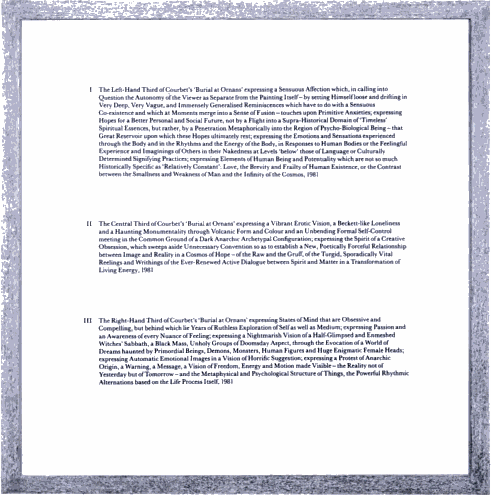
There is a web site of markov chain-generated texts in the style of the Art & Language collective’s critical writing at http://artandlanguage.co.uk/, presumably as a parody of their distinctive verbal style. Art & Language’s painting “Gustave Courbet’s ‘Burial at Ornans’ Expressing…” (1981) illustrates some of the problems that arbitrary assemblage of material and conceptual materials cause and the limitations both of artistic intent and critical knowledge. The markov chain-written texts in their style suffer from the weakness of such approaches. Meaning and syntax evaporate as you read past the first few words. The critic still has a job.

Or do they? Algorithmic criticism also has a history that goes back several decades, to Gips and Stiny’s book “Algorithmic Aesthetics” (1978). It is currently a hot topic in the Digital Humanities, for example with Stephen Ramsay’s book “Reading Machines: Toward an Algorithmic Criticism” (2011). The achievements covered by each book are modest, but demonstrate the possibility of algorithmic critique. The problem with algorithmic critique is that it may not share our aesthetics, as the ST5 antenna shows.
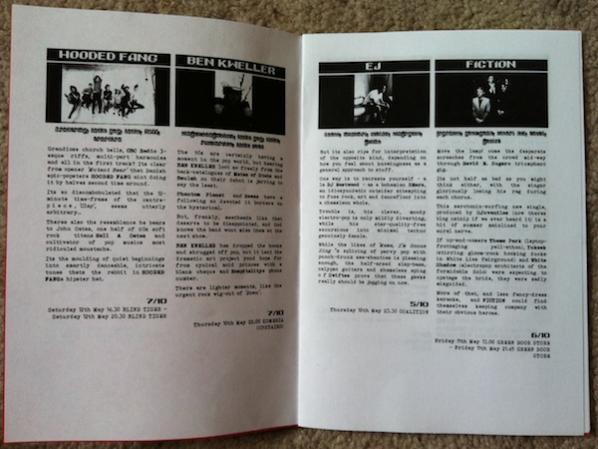
Shardcore’s “Cut Up Magazine” (2012) is a generative critic that uses a similar strategy to “The Fear Of Missing Out”. It assembles reviews from snippets of a database of existing reviews using scraped human generated data about the band such as their name, genre, and most popular songs. Generating the language of critique in this way is subtly critical of its status and effect for both its producers and consumers. The language of critique is predictable, and the authority granted to critics by their audience accords a certain status to that language. Taken from and returned to fanzines, Cut Up Magazine makes the relationship between the truth of critique, its form, and its status visible to critique.
We can use The Fear Of Missing Out-style big data approaches to create critique that has a stronger semantic relationship to its subject matter. First we scrape an art review blog to populate a database of text and images. Next we train an image classifier (a piece of software that tells you whether, for example, an image contains a Soviet tank or a cancer cell or not) and a text search engine on this database. Then we use sentiment analysis software (the kind of system that tells airlines whether tweets about them are broadly positive or negative) to generate a score of one to five stars for each review and store this in the database.
We can now use this database to find the artworks that are most similar in appearance and description to those that have already been reviewed. This allows us to generate a critical comment about them and assign them a score. Given publishing fashion we can then make a list of the results. The machines can take the critic’s job as well, as I have previously argued.
What pieces like The Fear Of Missing Out and Machine Imagined Artworks make visible is an aspect of How Things Are Done Now and how this affects everyone, regardless of the nature of their work. This is “big data being used to guide the organization”. To regard such projects simply as parody or as play acting is to take a literary approach to art. But art doesn’t need to resolve such ontological questions in order to function, and may provide stronger affordances to thought if it doesn’t. What’s interesting is both how much such an approach misses and how much it does capture. As ever, art both reveals and symbolically resolves the aporia of (in this case the Californian) ideology.
The text of this review is licenced under the Creative Commons BY-SA 3.0 Licence.
Richard Stallman[1] the outspoken promoter for the Free Software movement, hates Facebook with a passion. He proposes that we should all leave Facebook and either find or build our own alternatives. The evidence offered by Stallman’s and the Electronic Frontier Foundation’s (EFF), who have been fighting for Internet freedoms since the 90s [2] shows how necessary it is that we understand and are more pro-active in managing the personal data that we give away through our online activities.
When we subscribe to Web 2.0 platforms such as Facebook we are at the mercy of the data brokers. These companies trade in people’s personal data; information which is aggregated by monitoring user actions and interactions across social media. This information can include “names, addresses, phone numbers, details of shopping habits, and personal data such as whether someone owns cats or is divorced.”[3] Fast moving developments in social media, make it difficult to keep up with the effects and consequences of these platforms. This is why the work of groups such as Commodify Inc. is so valuable. They bring imaginative and critical attention to the situation, sharing their knowledge of these daily networked complexities and correcting what they see as its negative effects.
Commodify Inc. is an artist-run Internet startup producing projects to help individuals capitalize on their online monetary potential. Their intention is to correct the imbalance of power in markets where users have no control over the transactions made with their personal data. They have completed various artistic projects and interventions on social media like, Fame Game, Give Me My Data, and Web 2.0 Suicide Machine. The co-founders are Birgit Bachler, Walter Langelaar, Owen Mundy, Tim Schwartz, with additional contributors Joelle Dietrick and Steven Alvarado.
Their new project Commodify.Us, was initiated when Owen Mundy and Tim Schwartz were invited by moddr_ to a residency in their lab in the summer of 2012 – when they were still a part of the WORM collective in Rotterdam. They worked on an initial idea that would succeed previous experiences of their already well-known and respected projects.
Commodify.Us is currently in beta phase. It promises to provide a platform for people to regain control over the commercial exploitation of their own personal data.
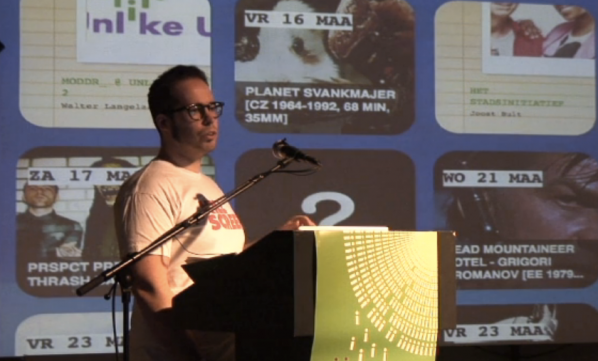
Intrigued by this project I contacted one of the co-founders, Walter Langelaar via email and asked him a few questions about this new platform.
Marc Garrett: Commodify.Us is for people to have greater control over their data. And it works when users export their data from social media websites and upload it to your platform. How will these users gain more control over their data and why is this important?
Walter Langelaar: Commodify.Us provides a platform for you to regain control over the commercial exploitation of your personal data. After exporting your profile data from social media websites and uploading the data to Commodify.Us, you can directly get in contact with interested buyers. On the importance for users I would say that it’s part raising awareness surrounding the monetization of profile data, and part creating a platform where people might work out and discuss how to do this themselves.
MG: It proposes to re-imagine the potential of relational data, creating a casting agency for virtual personas. I’m wondering what this may look like?
WL: We were too. In an early stage of the project we played with the idea that peoples’ various profiles could function like that within an agency; a client would ask for a specific set of qualities and/or characteristics within a set of profiles, and we could provide for this based on the uploads and their licensing options as set by the user. In the end we abandoned this idea for clarity.
MG: Commodify.Us offers people the opportunity to be part of an economy where interested buyers will pay to use the data supplied, unlike existing social media websites. How does this work?
WL: We are gearing up for a launch where the main goal will be to get a critical mass of around, a 1000 profiles. We anticipate that only with this kind of mass or volume will our initiative take hold with the potential buyers we have in mind, and the same goes for the more creative projects that could use the (open) data. Regarding the open profile data and otherwise licensed profiles that allow for reuse, we are researching the idea of ‘Fair Data’ (as in Fair Trade) and how to implement this as a profitable protocol for the end-user.

“Net activists construct tools whose intervention potential can be initiated by users under net conditions. These tools enable activists to develop new strategies in the data space of the Internet because they offer new means: New means afford new ends.”[4] (Dreher)
In his publication Networks Without a Cause: A Critique of Social Media, Geert Lovink lays down the gauntlet and asks us to “collectively unleash our critical capacities to influence technology design and workspaces, otherwise we will disappear into the cloud.” Anna Munster opens her excellent survey, Data Undermining: The Work of Networked Art in an Age of Imperceptibility, by saying “The more data multiplies both quantitatively and qualitatively, the more it requires something more than just visualisation. It also needs to be managed, regulated and interpreted into patterns that are comprehensible to humans.”[5] Commodify.Us goes one step further by allowing users to manage, regulate, repattern and reappropriate their own data using tools that share an essential functionality (if not purpose) with the power tools of Web 2.0.
Those previously seen as rebellious hacktivists are moving into new territories that deal with concepts of service. There has been a significant rise of artists exploring technology to influence mass Internet activity, against the domination of corporations who are data mining and tracking our on-line activities. Another example is TrackMeNot developed by Daniel Howe and Helen Nissenbaum. This is an extension created for the Firefox browser. “It hides users’ actual search trails in a cloud of ‘ghost’ queries, significantly increasing the difficulty of aggregating such data into accurate or identifying user profiles.”[6]
Howe and Nissenbaum mention they are aware their venture is not an immediate solution. However, the more we hear of and join these imaginative strategies “whereby individuals resist surveillance by taking advantage of blind spots inherent in large-scale systems” [7], and the more we adapt our behaviours to adopt these new ‘activist’ services, the more we demonstrate the demand for these new alternatives. And by so doing, we argue for the value of services that we can trust not to steal or manipulate our social contexts for financial and political gain.

A significant value offered by the Commodify.Us platform is the power to manage our own data. The simple act of downloading our own data from Facebook, and then uploading it to Commodify.Us supports us to rethink what all this information is. What once was just abstract data suddenly becomes material that we can manipulate. Alongside this realization arrives the understanding that this material was made by our interactions with all these platforms, and that other people are spying on us and making money out of it all. Once this data material is uploaded onto the Commodify.Us platform, it asks if we want this stuff to be a product under our own terms, or if we wish to make art out of it using their tools.
This is a cultural shift that demonstrates how contemporary Hacktivists are developing software that promises to offer realistic service infrastrucutures. When I interviewed Charlie Gere in 2012[8] he said that these artists “are not part of the restricted economy of exchange, profit, and return that is at the heart of capitalism, and to which everything else ends up being subordinated and subsumed. Thus they find an enclave away from total subsumption not outside of the market, but at its technical core.” For me, this kind of work is of central importance to the contemporary era, and it only occurs where artists cross over into territories where their knowledge of networks directly contributes to the building of alternative structures of social independence.
THE CRYSTAL WORLD
The White Building, London
3 August – 30 August 2012
The Space’s White Building cultural centre is within walking distance of the 2012 Olympic stadium in post-industrial, post-regeneration London. As I walked down the steps that lead to it I saw a diesel locomotive pulling a train of cargo containers across an old railway bridge over the canal nearby. Millions of these rational forms will be in transit around the world at any given moment, arranged in two or three dimensions like crystalised capital on trains and docks and ships.
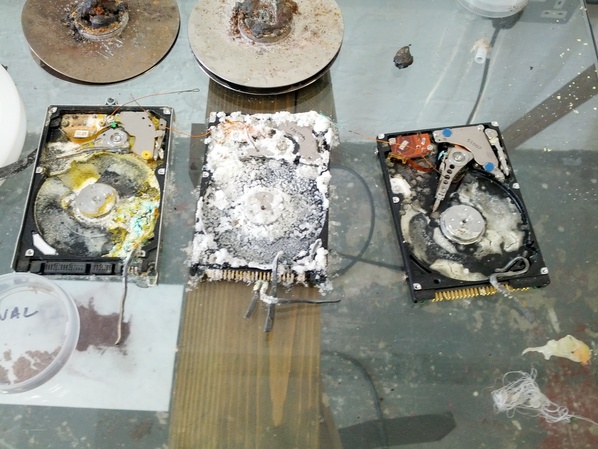
The logistics of their production and distribution are determined by computing machinery using algorithms that operate with inhuman speed and complexity. This same economic logic warps the architecture of the area around The White Building, with old factories and warehouses retro-fitted as office space and as gallery space.

Inside the White Building’s project space the computational enabling technology of the global economy is the subject of a show by Martin Howse, Ryan Jordan and Jonathan Kemp. It takes the title of J. G. Ballard’s novel “The Crystal World” as its starting point. In Ballard’s novel a virus progressively turns all life – vegetable, animal and human – into crystal forms frozen in time. It is a Cold War allegory of the catastrophic imposition of rigid order.
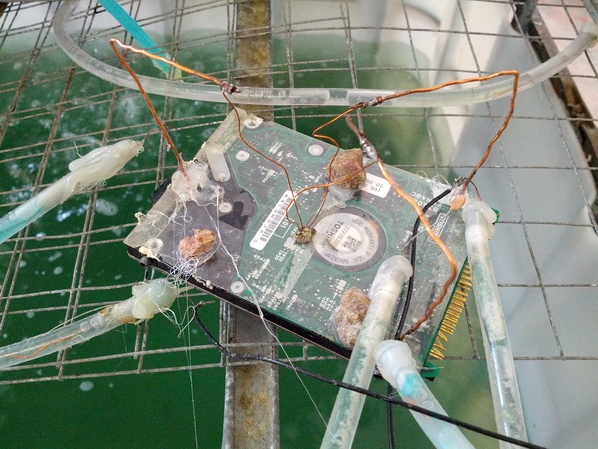
For Howse, Jordan and Kemp these imaginary crystals become the very real minerals refined in the production of the computing machinery used to structure our contemporary world. Inside every digital computer are wires, circuit boards, integrated circuits and other components. They are made from iron, copper, phosphorous, boron, tantalum and other rare earth elements. The central processing unit of a computer keeps time using a quartz crystal. The products of deep geological time are suddenly unearthed and set to pulsating millions of times a second.
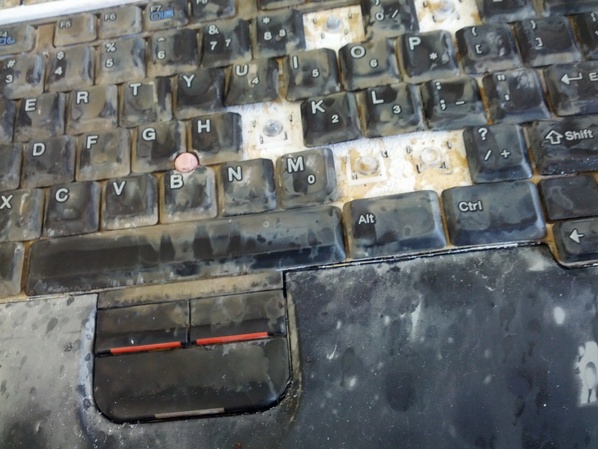
Computers are crystal engines. They are mineral fetishes that we use to manipulate powerful unseen forces that we believe we have mastered, like crystal healers working with a patient’s energy grid. But they are so invisibly familiar to us as our smartphones and laptops and their use in logistics and media is so pervasive that it takes an effort for us to perceive their operation or their implications.
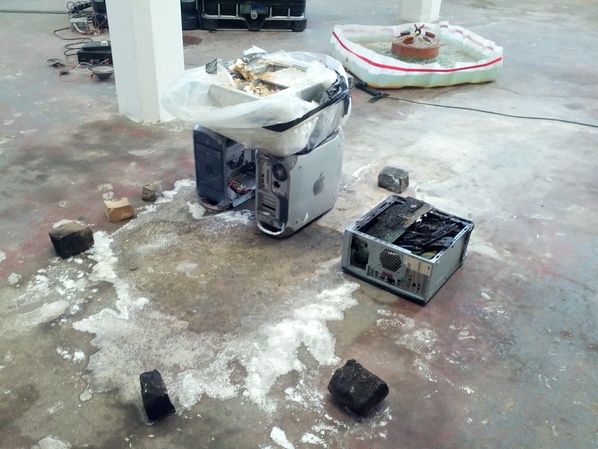
It takes almost two tonnes of raw materials to make a desktop PC. Unlike “Tantalum Memorial” (2008), by Harwood, Wright and Yokokoji, “The Crystal World” focuses on these raw materials geologically and temporally rather than geopolitically. But computing waste is toxic and valuable. The former makes disposing of old computers a growing problem, the latter makes recycling old computers a growing business. The minerals that computers contain can be recycled where they are valuable enough, or left to leach into the water supply in e-waste dumps where they are not.
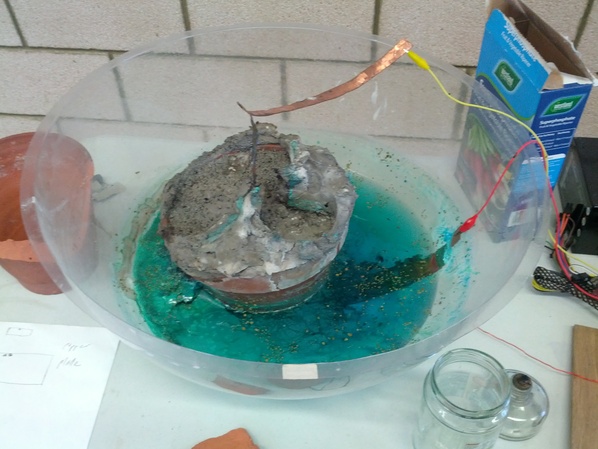
Or in the case of “The Crystal World” an open laboratory and the resultant art installation can re-extract them from their components and printed circuit boards using acid, water, electricity and heat in order to re-crystalise them and return them to geological time. The gleaming silent boxes that organize and mediate our lives are returned if not to the earth from whence they came then at least to their raw materials.

Tables edge the White Building project space, covered with the equipment and results of five days of workshops (and one with books, including Ballard’s, giving any spectators unsure of what is happening a conceptual framework to proceed from). Table after table of crystals, circuit boards, jars, electical equipment, and wires are overwhelming in the details of their appearance and implication. These traces of human activity and inquiry frame the flow of water and electricity in the center of the space, convincing the viewer of the creative intent of its production and drawing them in to its logical universe.
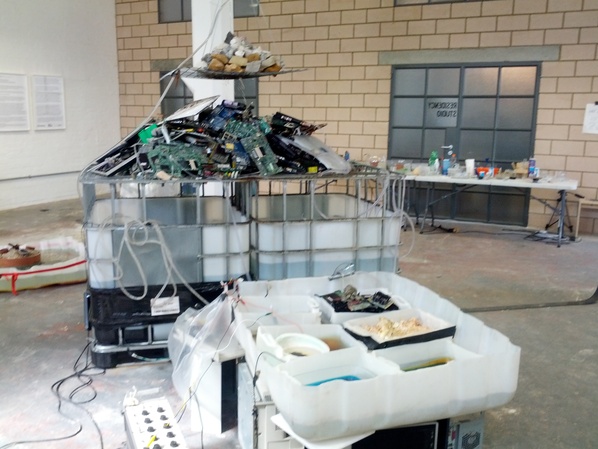
The centre piece of the show is a favela chic water feature that drips acid-loaded water through calcinous rock fragments, over e-waste, into two cut plastic-drum tanks. Next to it an array of smaller plastic containers contain circtuit boards having their copper leeched from them by acid, fungus growing on the by-prodcucts of the project, and other watery deconstructions of computing machinery. It looks dangerous and uncertain, deconstructing both the physicality and the meaning of computers. Seeing the innards of an IBM ThinkPad computer becoming encrusted with calcium like a digital stalagtite, or CPUs branching feathery crystals, returns computing machinery to its raw mineral state. FLOPS give way to eons once more. Neither is a human timescale, yet we must live between them at the moment.

The most fantastical artifact along the walls of the project space is the “Earth Computer”. It’s a battery-like construct of recycled copper and zinc in a tray of silver nitrate attached to lightning conductor-style copper strips. Sitting in earth on a plastic sheet and surrounded by the left-over materials of its creation for the duration of the show, it will be buried nearby afterward. Such a device can function effectively, but not literally. It is more likely to spring to life in the mind of the viewer than if it is struck by lightning. It is effective art, psychic engineering rather than technological cargo culting.
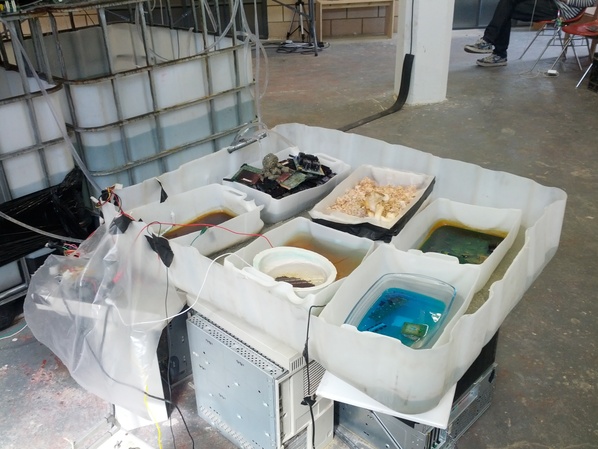
Acid, water and electricity mixed together with e-waste look and feel dangerous. The recycled ad-hoc materials and equipment containing and channeling them reinforce this feel and leaven it with an aura of creative investigation. The form of the show is timeless, the workshop of the alchemist, outsider scientist, or mad inventor. Its content is very contemporary, from Ballard’s rising cultural stock and the social and environmental costs of e-waste to Long Now deep time and posthuman philosophy. Art symbolically resolves the gaps between ideology and reality, and computing is so pervasive and key to society that most people don’t even regard it as ideological never mind conceptualise its failings as such.

The water and abandoned human artefacts of some of the installations is more “Drowned World” than “Crystal World”, and the broken machinery is more “Crash”. Ballard’s catastrophes provide a modern mythology that is a more useful resource for art than its literary roots might suggest. It achieves the defamiliarising and critical impact of hauntological art without requiring its supernaturalism or nostalgia. There is a Ballardian attitude at play here.
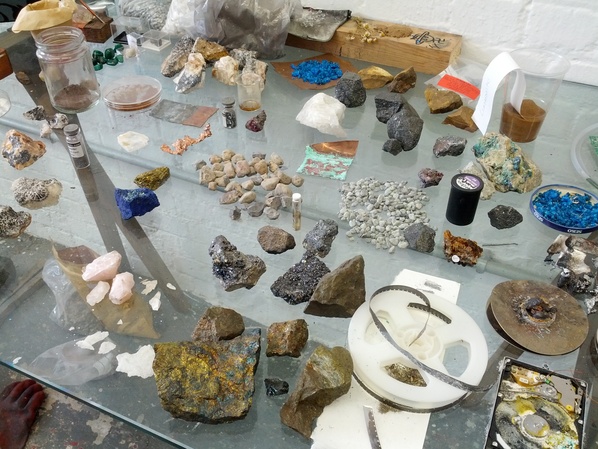
I found “The Crystal World” mind-blowing. It relates the tools of our human existence to non-human substances and timescales, providing the kind of corrective to anthropocentric vanity that object-oriented philosophy aspires to. It achieves this profound insight and presents it in an accessible way precisely because of the modesty of its materials and aesthetics, and because of the resonances of the cultural materials chosen as its starting point.
http://spacestudios.org.uk/whats-on/events/the-crystal-world-open-laboratory-exhibition-
The text of this review is licenced under the Creative Commons BY-SA 3.0 Licence.